

25 Road Trip Hacks when Traveling with Dogs in Cars
Road trips are one of the easiest and funnest ways to travel. Plus, they’re a great option for dog owners, since dogs of all shapes and sizes can ride in a car. Whether your trip is hours long or days long, there are things you can do to make life on the road a little bit easier for both you and your dog. Check out these 25 road trip hacks for when you’re riding with your dog.
Article Contents
1. Get Astroturf

If you’re traveling with dogs, and you want to protect your car from hair and dirt, consider Astroturf.
Astroturf is a synthetic material that looks like fake grass. It’s usually found on sports fields or walkways.
But it works great for dogs and cars too! Purchase a cheap roll of Astroturf at your local hardware store, measure your space, and cut it to fit.
The Astroturf provides your dogs with something to grip on, so they won’t slide around in the back. It’s great for traction, and it’s easy to put on and remove.
It’ll also catch all the debris – like dirt, fur or gravel – that your dog will inevitably track in. It’s just a matter of shaking it off to clean it, or giving it a quick spray of water. And remember, it’s a synthetic material, so it’ll dry super quick.
Get Astroturf here .
Bonus: if you’re into messy outdoor activities – hiking, camping, going to the beach, etc. – it’ll be great for you and your gear too!
2. Use a spill-proof bowl

You have to stay hydrated while on the road.
Ideally, you’ll want to stop for water breaks, and drink al fresco. But if you’re staying in the car, either due to time constraints, bad weather, or because it’s dark out, you’ll want to serve up that fresh H2O in a spill proof bowl.
Spill proof bowls ensure your dog won’t get water everywhere or drench your car in dog drool.
Keep one on hand for mess free feedings, so your dog stays hydrated while your car stays clean.
Get the no spill bowl here .
3. Keep all your dog’s important documents in a waterproof, sealable Ziploc bag
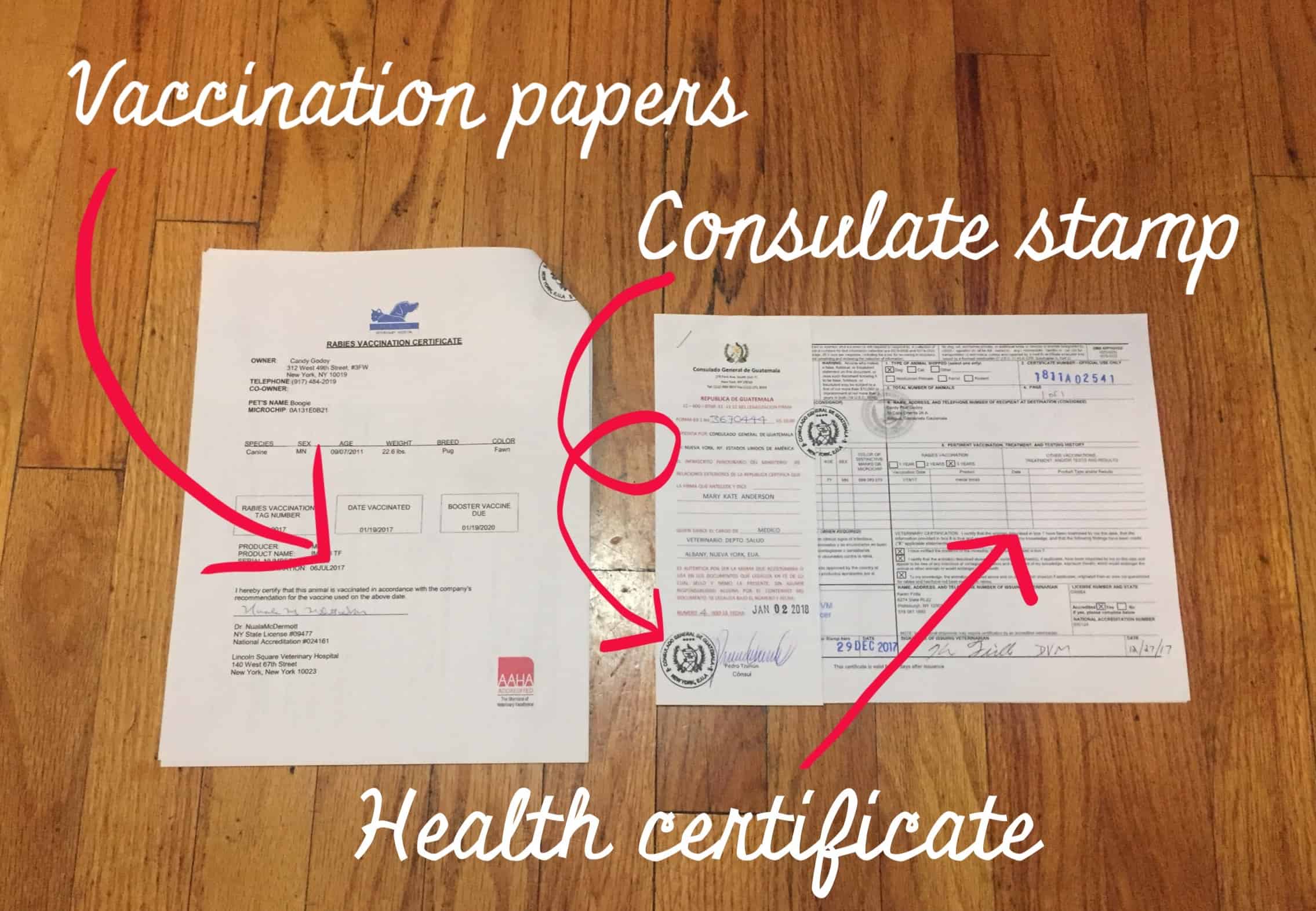
When you’re traveling with your dog, it’s important to keep vital documents, like medical records, extra copies, and ID information, on hand, especially if you’re crossing state lines.
And when there are muddy paws, dirty shoes, and the potential for spills, you’ll want to be sure these documents stay clean and dry.
Keep them safe in a waterproof and sealable ziplock bag. This is easy to throw it in a backpack or the glove compartment, and means you won’t have to worry about keeping them readable.
4. Use seat covers or a blanket
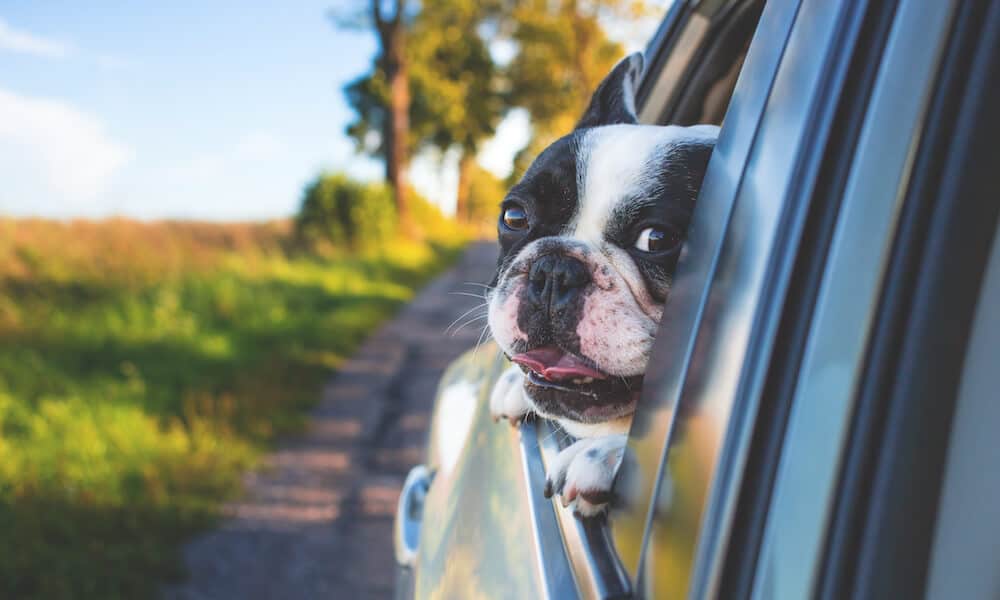
Dog hair and seat scratches are easily preventable by keeping seat covers or a blanket on hand. They both protect your car and make it easy to shake off loose fur and debris.
They’re especially useful if you’re renting a car. Who doesn’t love an easy clean up?
Bonus: get waterproof seat covers to make your ride even smoother – there’ll be no need to worry about wet dogs!
Get seat covers here .
5. A crate, car seat, and/or seatbelt are necessary
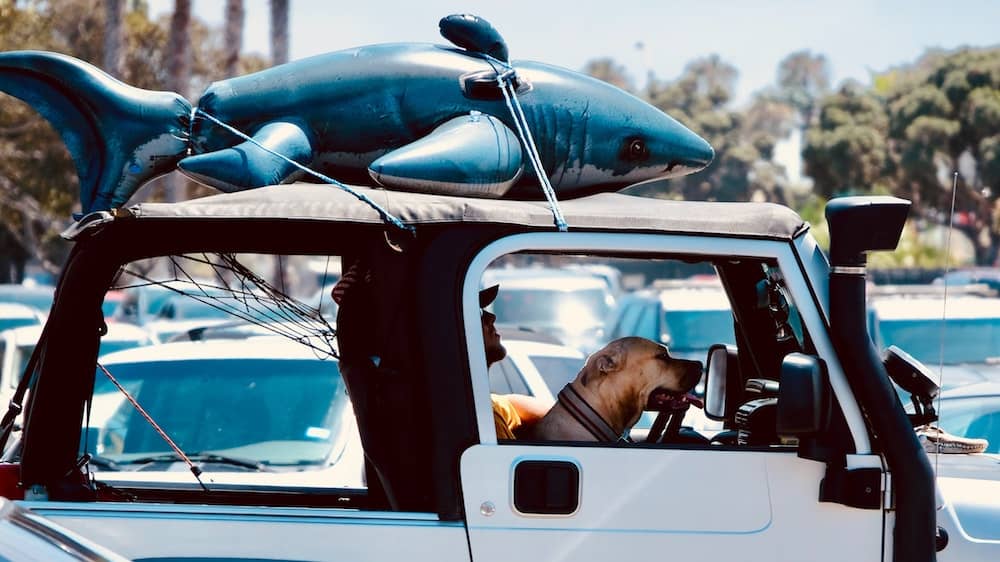
Safety is important when you’re on the road. If you stop short, slam on the brakes, or get into an accident, your dog can get seriously hurt.
To protect your dog, make sure to secure them while in the vehicle.
For medium to large dogs, try a crate or dog seatbelt. For smaller dogs, check out car seats.
Consider collapsible travel crates , no matter your dog’s size, which double as in-car restraint systems and a dog suite in your hotel room or campsite.
6. Use a pet ramp for easy access
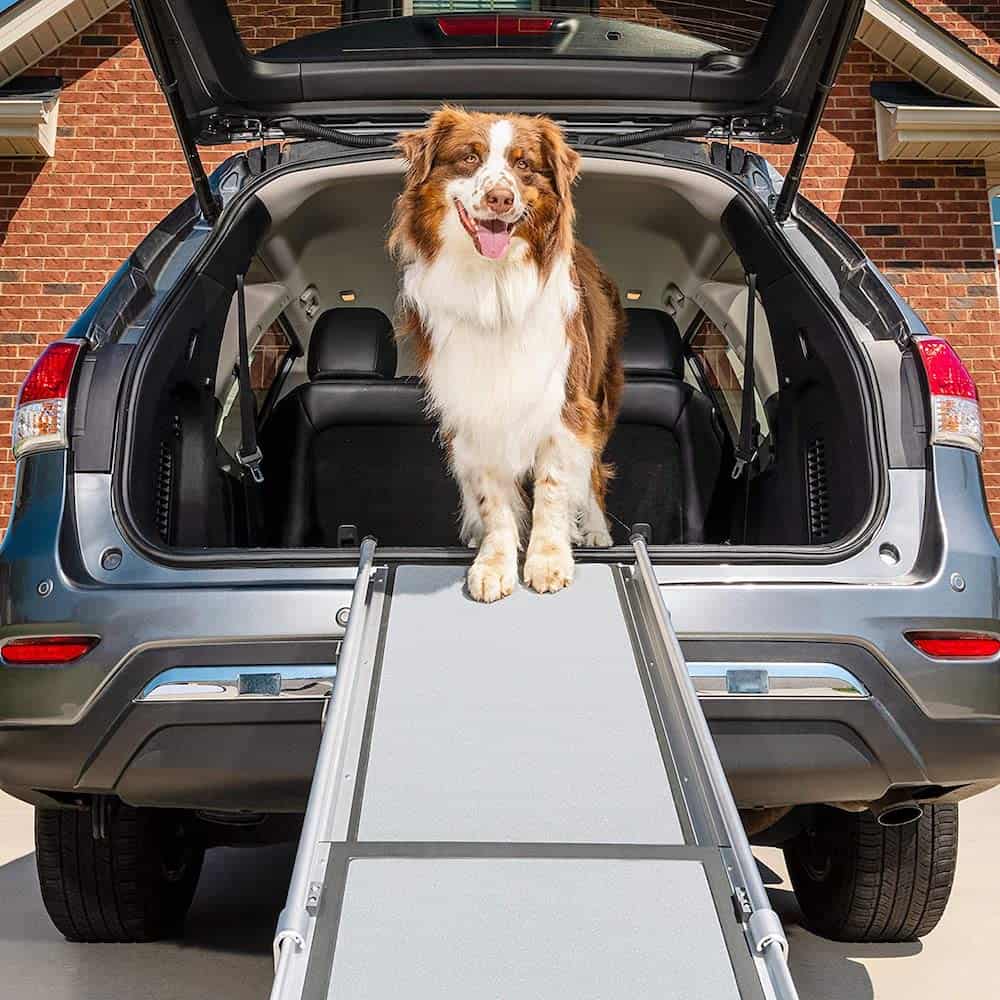
Some dogs, like older pets or dogs with mobility issues, might have trouble getting in and out of the car. Carrying them isn’t really an option if they’re big, or if your hands are full.
A pet ramp is a great option to help with easy load ins and outs.
This one is adjustable, works with all sizes of vehicle, and can withstand up to 400 pounds. Its high traction surface prevents slips and falls. Plus, the ramp is easy to carry – it’s only 13 pounds – and easy to store.
7. Use up to date dog tags

Up to date dog tags are important in your dog’s daily life, and especially while traveling.
They signify to others that your pet has a home. They’ll protect your pet from being mistaken as a stray, and make it easy for people to contact you should anything happen.
My dog’s tags have their name, my email address, and my phone number. Some might choose to include their home address as well.
Be sure your pet is microchipped too!
8. Use a travel pet food container
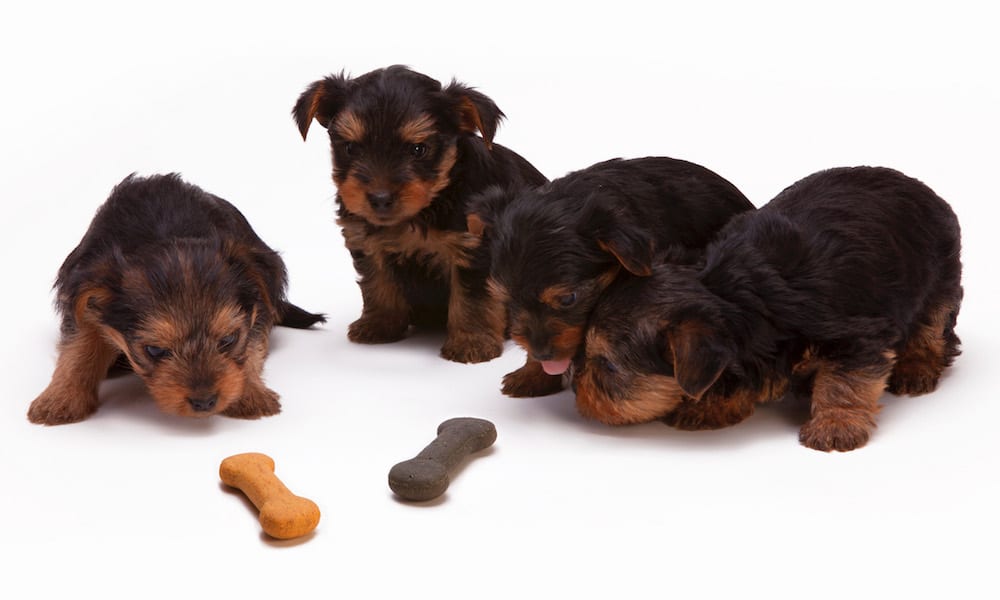
Throwing some kibble in a Ziploc bag sounds easy, but if you turn your back for a few minutes, your dog will sniff it out and rip right through it.
This kibble carrier keeps meals fresh and can hold up to five pounds of food. I love that it rolls down and clips securely, making it malleable so it changes size depending on how much food I pack.
This travel container is also great, especially on camping trips and long car rides. It includes two detachable bowls to serve food and water, and features an easy to carry handle.
9. Pack the right clean up tools
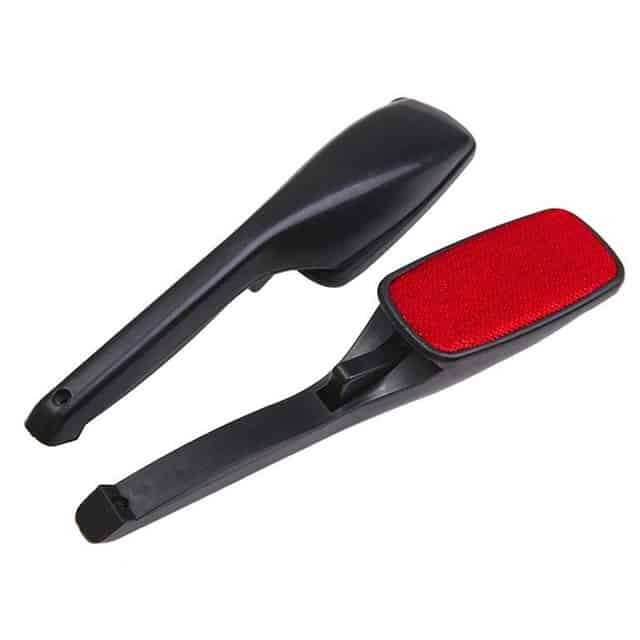
A road trip converts your car into a make shift home; you’ll be using it to eat, sleep and hang out. With all of that extra time in your vehicle, it won’t be smelling too fresh by the end of the day. Add one or two dogs, dirt and mud from outdoor excursions, and plenty of spills, and you’ve got yourself a locker room on wheels.
But who wants to travel in a dirty car? Not me! Especially if it’s a rental, and fees are involved. Keep your car clean and pack the right tools to help you.
This hair-removing silicone brush is great at loosening pet fur lodged in your car’s carpets and seats. It’s also small enough to keep in your glove compartment or to throw in a bag.
For a more thorough clean up, consider a vacuum. This handheld cordless vacuum will suck up all of the fur, sand and dirt tracked in from your dog, plus it comes in an easy to store bag.
It’s lightweight and portable, so perfect for road trips.
10. Stay shady
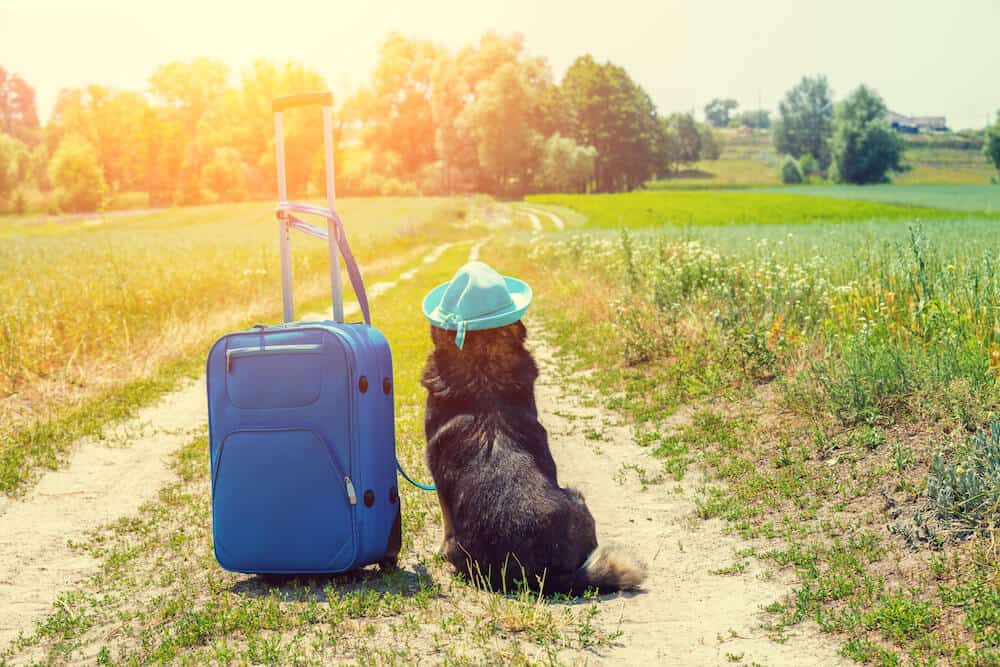
Driving on a hot day? Sunlight will heat up the interior of your car and turn your vehicle into an oven. It’ll dehydrate you and your dog, and make car rides uncomfortable.
Keep your car, whether on the road or parked, cool and stay shady.
This car window sun shade blocks over 97% of harmful UV Rays. It fits most car windows.
If your dog sits in the back (they should!), try these rear seat air fans . They plug into your cars’ cigarette lighter and help keep your pet cool on even the hottest of days.
11. Stay hydrated

Long hours on the road, especially on a hot day, can lead to dehydration.
While you’ll want to take frequent water breaks, sometimes, due to weather or time of day, you won’t be able to stop the car.
This dog water bottle fits right in the car cupholder, and dispenses water with a squeeze. It’ll make grabbing a quick lick easy while on the road.
12. Pet First Aid kits are a must
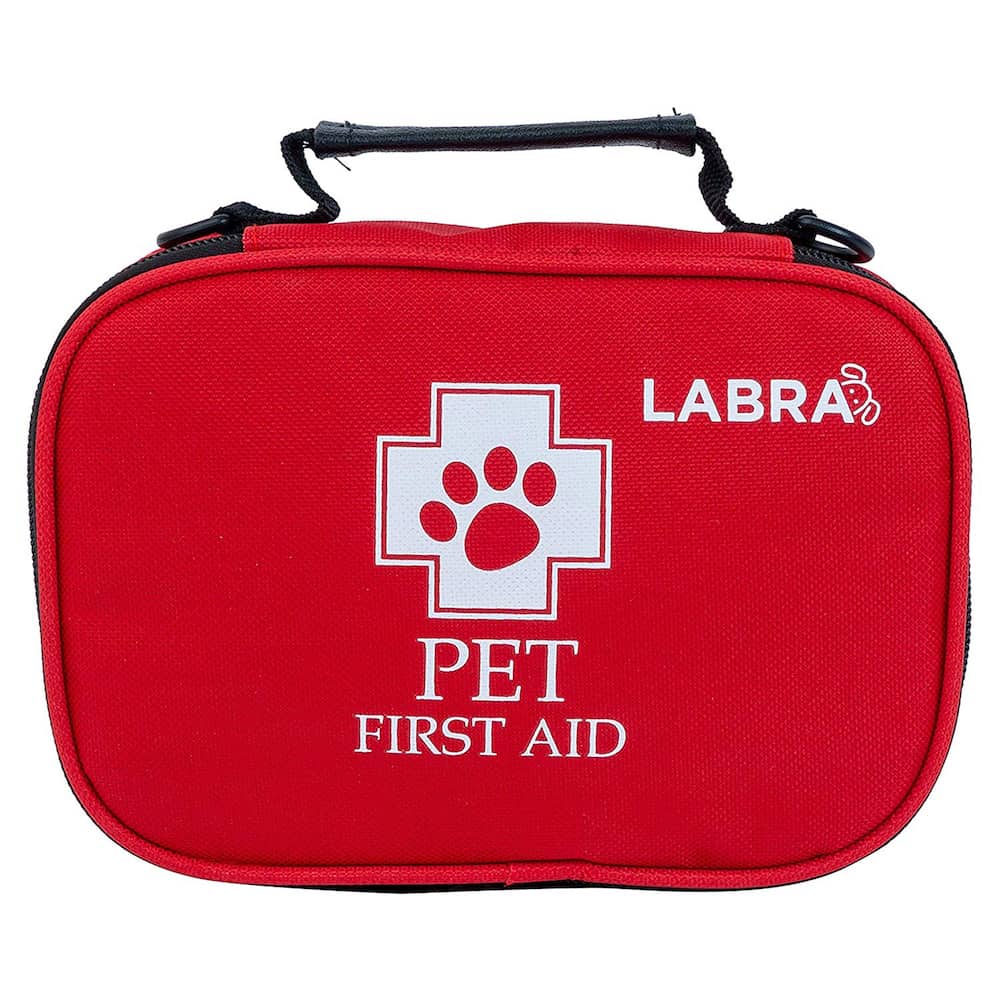
Every car needs a dog first aid kit to use in case of emergency.
You’ll be prepared for injuries and be able to treat cuts, scrapes, sprains and strains, no matter where you are. It’s always better to be safe than sorry.
This useful K9 First aid Kit is compact, sells for a reasonable price, and has all of the essentials. It includes scissors, tweezers, a pet brush, a pair of rubber gloves, antiseptic cleaning wipes, and more.
Or, save money and make your own with a few items from around the house.
Grab a container – a ziplock, drawstring bag or Tupperware works – and throw in the following:
- Hydrogen peroxide
- Antibiotic ointment
- Rubber Gloves
- Wet or Grooming Wipes
13. Be organized
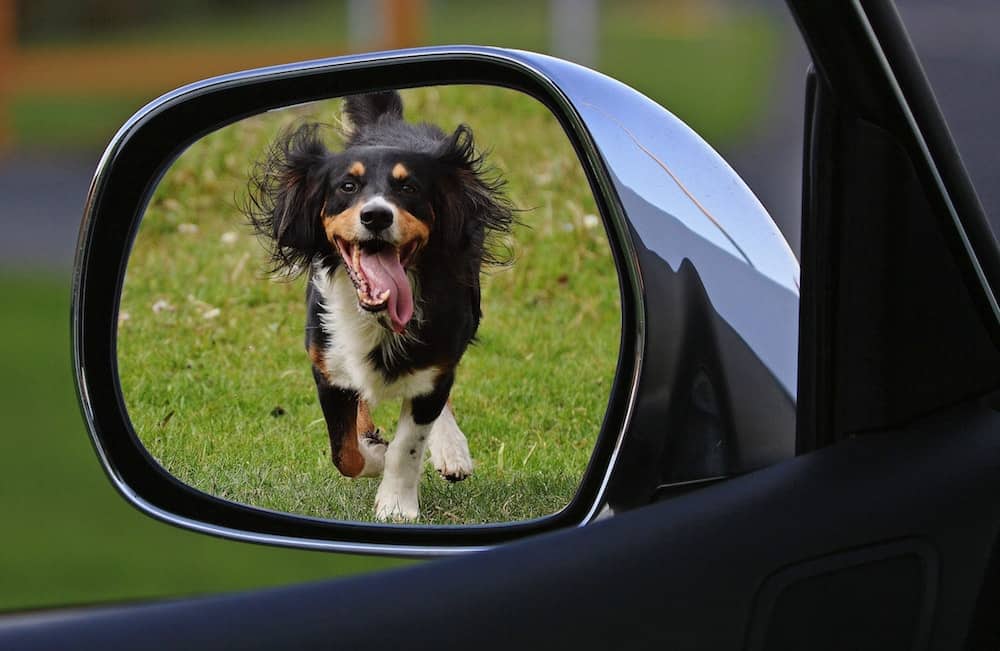
Throwing things in your car feels great until you’ve created a mountain of mess and can’t find something. Avoid this problem entirely by getting organized from the get go.
This strap in collapsible trunk organizer helps you neatly store all of your gear into sturdy, yet flexible compartments. Use it in half mode or open mode, depending on how much stuff you have.
I’m also digging this trunk divider that attaches with velcro and fits into even the most weirdly-shaped nooks of your car. It’s an easy way to secure loose clutter in the back.
14. Keep a packing list

Planning a road trip can be daunting, but you won’t have to worry about leaving things behind if you’ve got a good packing list to refer to.
This packing list works at the beginning of a trip, when you’re packing your bag, and throughout, to make sure you don’t leave anything behind.
Check out our dog travel checklist , and print out a copy for yourself.
15. Map out dog-friendly places to stop along the way

What’s a road trip without fun stops along the way? But with a dog in tow, not every location will be welcoming.
Before heading out, map out dog-friendly stops along your route, so you’re not totally clueless when it comes to breaks. It’ll make potty breaks or activities along the way easier and better.
Plus, doing a bit of research before the trip will help you discover dog-friendly places you never even knew existed.
Here are some helpful places where you and your dog will be welcome:
- The Best Dog-Friendly Places to Stay on a U.S. Road Trip
- Guide to the Ultimate Road Trip with your Dog
16. Soothe nervous dogs
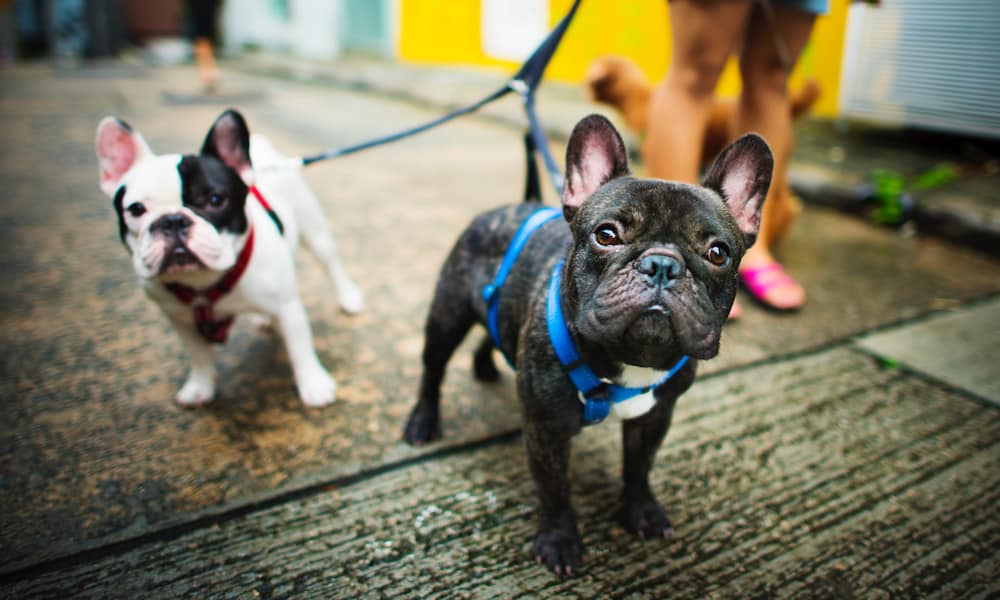
If your dog is nervous in the car, help soothe them so that they can rest and get comfortable.
Here are some tips for road tripping with a nervous dog:
- Bring along your dog’s favorite items, so they have familiar objects around from home. A favorite toy, dog bed or blanket with your scent.
- Put your dog in a thunder jacket; they apply constant pressure on a dog’s torso, similar to a parent swaddling a child.
- Experiment with CBD oil or CBD treats to help your dog remain calm.
- Make sure the car is comfortable and cool – crank the air conditioning and make their crate or the backseat nice and comfy.
- Do shorter rides with a great reward at the end before embarking on a longer trip.
17. Get rid of that wet dog smell

If you’re planning outdoor adventures like hiking or swimming, your dog is guaranteed to get wet and muddy. While that wet dog must is ok around the campfire, it’s not great once it infiltrates your car.
This bamboo charcoal car air freshener naturally absorbs odor like a stink sponge. It’s long lasting and fragrance free, and totally safe for your pets.
18. Keep supplies on hand for dirty paws
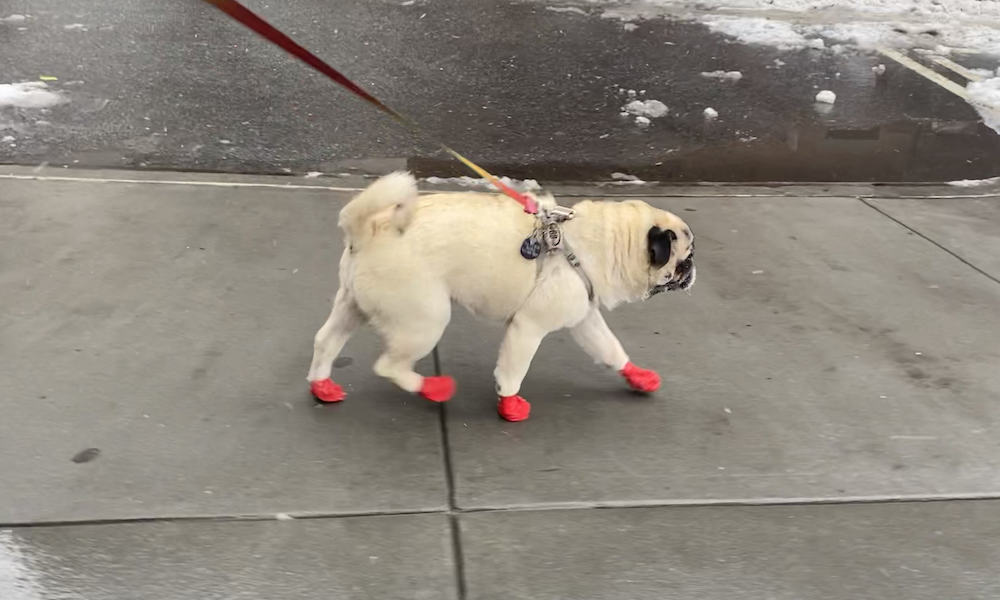
Just as you should wipe off or remove your dirty hiking boots after a trek, do the same for your dog. Dog paws can track in dirt, sand, mud and water that’ll get all over your car.
Keep some supplies on hand to prevent too much mess. A quick dry towel or grooming wipes should do the trick.
Or, make your dog wear dog boots ! They’ll keep your dog’s paws clean and you can take them off before getting in the car.
19. Download helpful apps

There are plenty of apps that can help when on the road with your dog. It’s gotten a lot easier than when I used to travel the world sans iPhone.
- BringFido: This app (and website!) helps you locate pet-friendly hotels, restaurants, parks and activities.
- DogTrekker: DogTrekkers lists dog-friendly places to stay, eat, hike, swim and have fun throughout the state of California.
- USA Rest Stops: This app helps you find the nearest rest stop. It’s great for water and potty breaks.
- Roadtrippers: Roadtrippers offers planning, maps and travel guides for road trips. It’s especially great if you’re camping – you can book campgrounds directly in the app.
- Sniffspot: Sniffspot showcases safe and private dog parks and off leash areas hosted by locals. It was made for reactive dogs, but any dog can use it. Find locations that work for you and book for some play time.
If you’re looking for more, check out this list of the best dog apps available for iOs and Android! We’ve also got a list of our favorite dog podcasts .
20. Plan ahead

Jumping in a car and driving wherever the wind takes you sounds romantic, but it’s not really very practical. You don’t want to be stuck with no place to stay.
Plan ahead! It’s an especially good idea if you prefer the comforts of a hotel or motel, rather than a campsite. Some places don’t allow dogs, while others have weight limits, breed restrictions or big fat pet fees.
Here’s a list of questions to ask dog-friendly hotels, and here’s another with the best dog-friendly places to stay on a road trip .
21. Keep fleas away

If you’re planning to hike or spend time in the woods, you’ll want to be certain your dog has flea, tick and heart worm medication. It would be terrible to pick up fleas, and get them in your car! Plus, they can be dangerous and cause health issues like lime disease.
We tend to pick up organic flea collars before going on a trip. They’re great to have in handy and safer than alternatives. Earth Animal also sells a flea and tick internal powder that comes highly recommended.
22. Reward your dog with a treat along the way!
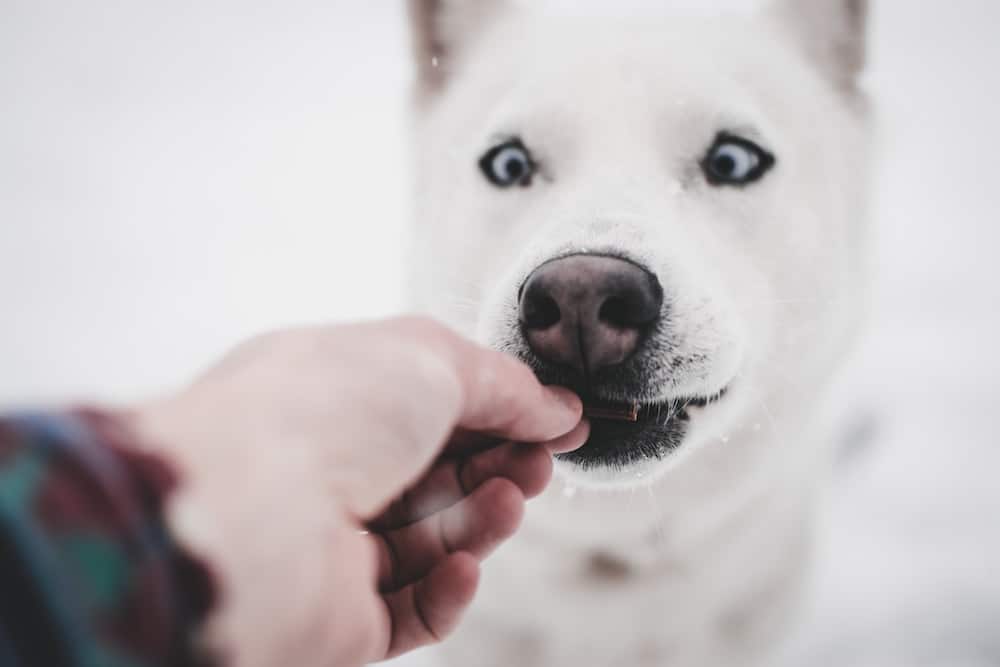
Road trips are fun, and your dog should be in on it. The car is a happy place! It’s taking you to new places, and on new adventures.
Remind your dog of this with positive reinforcement and treats.
When you’re on the road, stop at chains like Dairy Queen and Starbucks; both offer dog treats that you can pick up at the drive through. Dairy Queen has pup cups, and Starbucks has puppucinos .
23. Tired dogs are the best travelers

This is my number one piece of travel advice, whether you’re flying, road tripping or on a train.
Zoomies and a case of the wiggles are best left for wide open spaces. Confined spaces, like a car, mean your dog won’t be able to stretch their legs.
Make sure your dog gets a lot of exercise before doing a long stretch in the car, or stop along the way so they can run around. It’ll make your dog feel better, and make for a much more comfortable trip, for both you and your pup.
24. Use bottled water if you’re crossing state lines
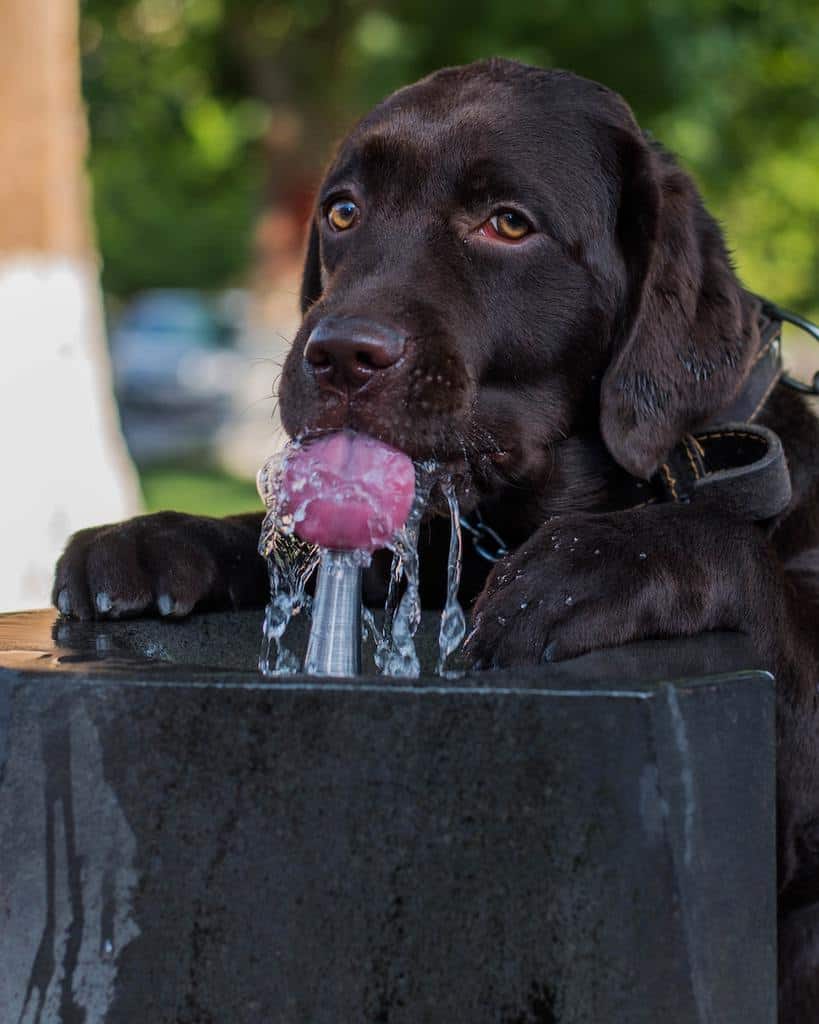
This is a trick I learned from show dogs who have to travel to compete.
Tap water is different in every place, especially when you cross state lines. The change in levels of things like chlorine can upset your dog’s digestion and cause diarrhea.
Take your own water from home, or buy bottled water.
If you bring your own water, gradually add some of the new water to the water from home, or just stick to bottled water the entire time to be safe.
We bought jugs of water at Costco and Walmart and just always kept extras in our trunk. Problem solved!
25. Bring a headlamp to pick up poop in the dark

Let’s be real, picking up dog poop in the dark is a drag.
Sure, you can use your cell phone as a flashlight, but that means you’ll have to do the one handed poop pick up, while you also hold a dog leash and bend over. What a mess!
The chances of falling, tripping or dropping your phone into some fresh poop are high.
And if you’re in a wooded area with grass? Even worse. Camouflaged poop is extra hard to find.
Free up your hands and be prepared with a headlamp! That way you can easily spot the fresh turds all while using both hands. Plus, you can use it for other stuff while in the dark. Stuff that hopefully doesn’t involve poo.
Here are some rechargeable headlamps that come highly rated.
Related:
- Rental Car Company Pet Policies
- This Is The Only Insurance Company That Will Cover Your Pet While Traveling
What other tips do you have for dog-friendly road trips? Let us know in the comments.
Pin for later!

Similar Posts

A Complete List of Dog-Friendly Shopping in New York City
Dogs are the best shoping partners. They’ll never rush you, and they think you look great in everything. Here’s where to find dog-friendly shopping in NYC.
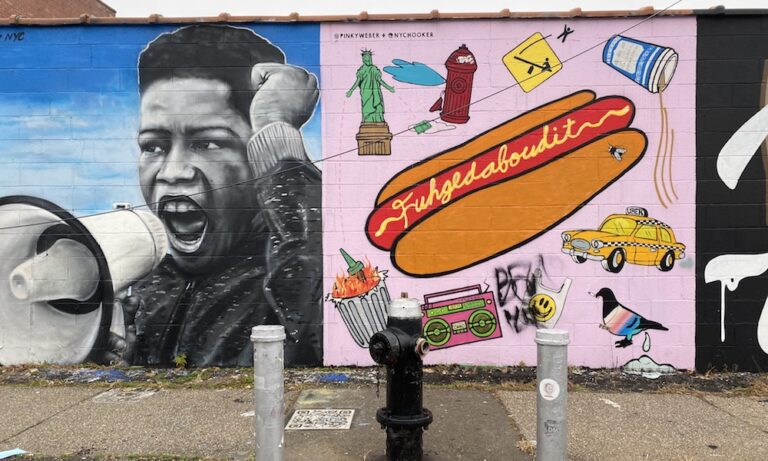
A Dog-Friendly Guide to Astoria, Queens
Astoria, Queens is one of the best neighborhoods in all of NYC. Here are some of our favorite dog-friendly spots in Astoria.

Dog-Friendly Glamping Within Driving Distance of New York City
Glamping combines the joys of nature with the convenience of home. Here are dog-friendly glamping spots near New York City.

Dog-Friendly Wineries in the Hudson Valley
Wine tasting, cute dogs, and beautiful scenery – what’s not to love? Here’s a list of dog-friendly wineries in the Hudson Valley.
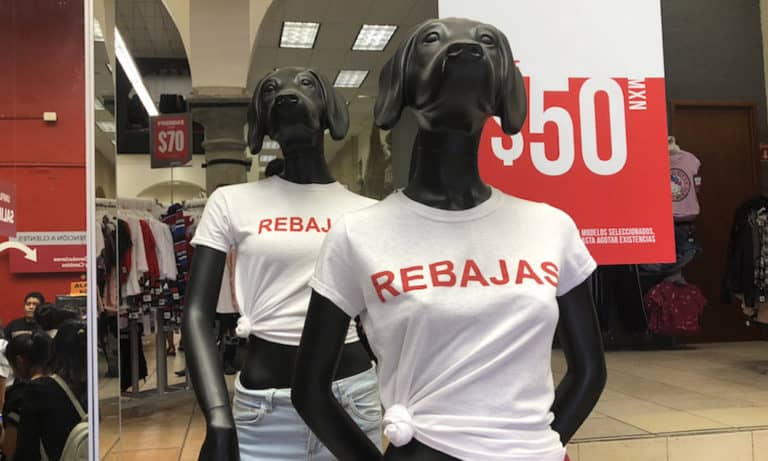
The Best Black Friday Deals for Pets
Black Friday has gone to the dogs! Check out these great Black Friday deals for pets, all available online. Snatch them up this weekend!
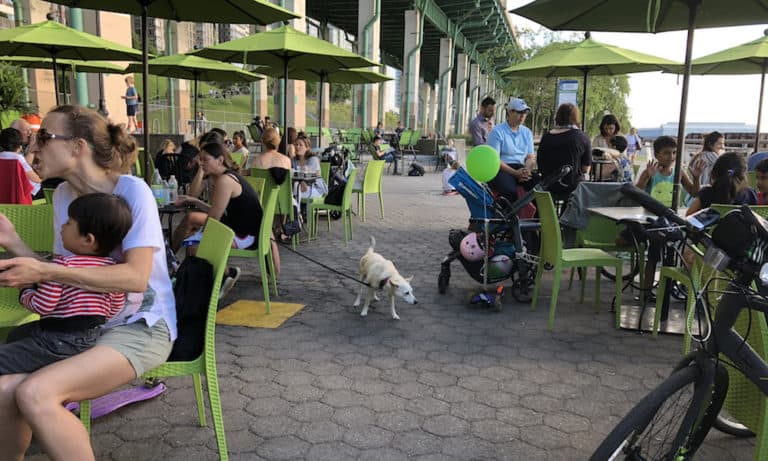
11 Dog-Friendly Places to Eat in NYC
No trip to the Big Apple is complete without checking out the food scene – and now your dog can come too! Here are 11 dog-friendly places to eat in NYC.
GREAT article. thanks
Leave a Reply Cancel reply
Your email address will not be published. Required fields are marked *
Where Have We Been

Dog-Friendly New York City Dog-Friendly Brazil Dog-Friendly Boston Dog-Friendly Philadelphia Dog-Friendly Baltimore
Check It Out
About Privacy Policy Disclosure & Disclaimer Contact
Looking For Something?
Affiliates disclosure.
boogiethepug.com is a participant in the Amazon Services LLC Associates Program, an affiliate advertising program designed to provide a means for website owners to earn advertising fees by advertising and linking to amazon.com, audible.com, and any other website that may be affiliated with Amazon Service LLC Associates Program. As an Amazon Associate, the owner of this site earns a commission from qualifying purchases.
Travel Tips
Get Inspired How To Save For A Trip How To Plan A Dog-Friendly Trip Flying With Your Pet Get The Right Dog Gear Pet Friendly Accommodations Pet Friendly Destinations Roadtrips With Your Pet
Get the Latest Woof in Pet Travel

How to Travel With a Dog in a Car: An Expert Guide
Heading out on the road with your dog soon? Read this guide first to make sure the car ride is an enjoyable, safe experience.
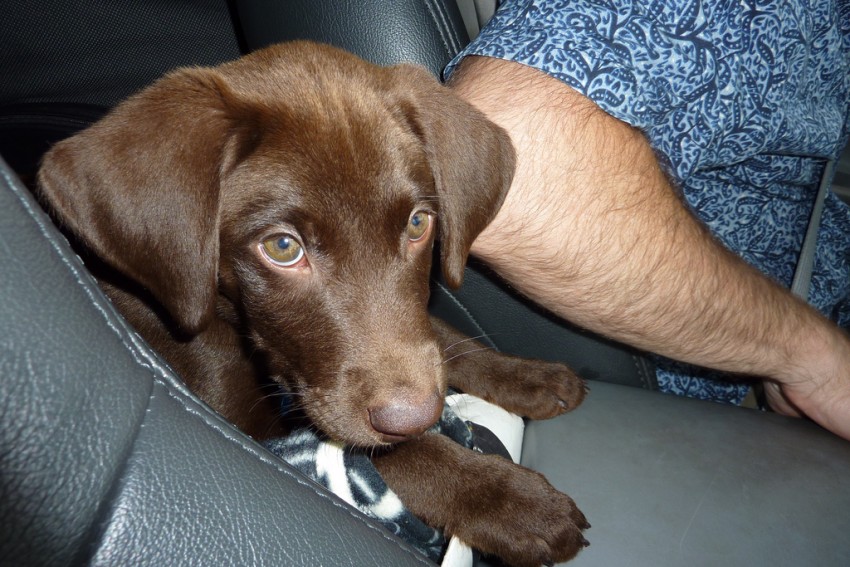
Planning on taking your dog on the road with you?
If so, you may be wondering how to travel with a dog in car — safely and smoothly.
Before you start your trip, read the tips below.
In this expert guide to traveling with a dog in a car, we’ll cover:
- How to keep your dog safe
- Which harnesses or carriers are best for dogs in cars
- Tips for taking a dog on longer trips in a car
- What about letting a dog ride in the back of a pickup truck?
- How you can prevent motion sickness in your dog before a car ride
- And much more!
So buckle up, and let’s begin…
Part 1: How to Keep Your Dog Safe in the Car
Prevent a tragedy — vow right now to make sure your dog is properly restrained whenever you take them with you in the car.
The expense and slight inconvenience of using the appropriate vehicle safety items is well worth the risk.
Plus, restraining the dog also keeps them from moving around the car and distracting you while you’re driving.
Safely Restraining Your Dog in a Car
Dog harness.
First, get a harness for your dog.
If you restrain your dog using only a collar, your pet may get strangled if you get into a wreck, especially if you rear-end someone. A harness may protect the dog’s neck and spine.
We prefer fabric harnesses that wrap around the dog’s neck and torso. Many also have a loop on the top through which you can thread the seat belt.
The PoyPet No-Pull Dog Harness has a reflective vest, a leash connection on both the front and back, and (last we checked) was less than $20. Worth every penny.
Dog seat belts attach to harnesses, keeping your dog immobilized in the back seat.
There are 2 basic models:
- Those that attach to your car’s seat belt
- Those that clip into the “female” end of the seat belt lock
Either kind will work. Choose the one that works best for your car.
This strap from PetSafe is adjustable and easy to use.
Remember: Don’t attach the seat belt to your dog’s collar — attach it to the dog’s harness instead, to avoid strangulation.
Booster Seat
A small dog who loves to look out the car window will enjoy having a booster seat.
Was YOUR Pet Food Recalled?
Check Now: Blue Buffalo • Science Diet • Purina • Wellness • 4health • Canine Carry Outs • Friskies • Taste of the Wild • See 200+ more brands…
CHECK RECALLS NOW!

Designed to fit in your back seat, booster seats are secured with your automobile’s seat belt, around which you clip a dog seat belt that you attach to the harness.
These specialized seats not only provide a safe place for travel but they also act as a comfortable dog bed. Most are made out of sturdy foam core topped with fabric and fleece. Add a blanket, and you’re good to go.
Booster seats provide maximum comfort and a view for your pup. They last a long time.
Here’s a highly rated car booster seat for small dogs sold by a company called Kurgo.
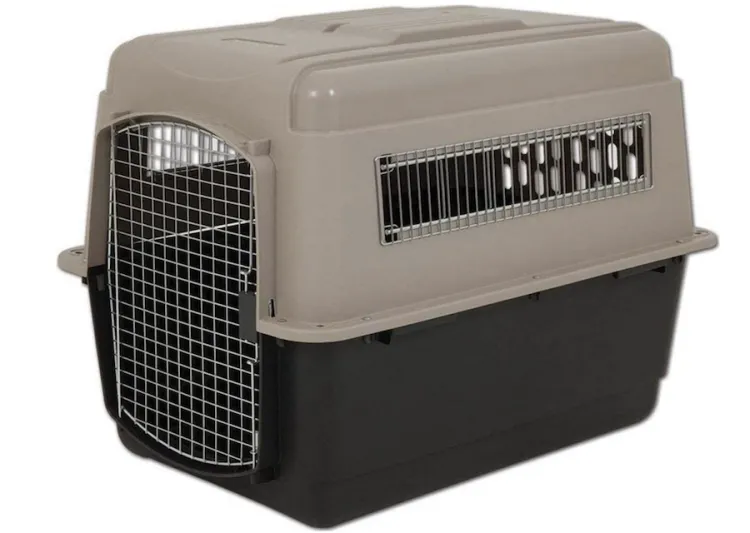
Dog Carrier
The safest way to transport your dog? In the back seat, confined to a hard-sided dog carrier (also called a travel kennel or crate) that you’ve secured with a seat belt.
In the event of a car accident, your dog should be well protected in a carrier.
The Petmate Ultra Vari Kennel is billed as being heavy-duty and secure for a safe and comfortable travel experience.
But according to the Center for Pet Safety (CPS), this exact crate was “far and away the most impressive crate” that this safety organization tested. It “was able to withstand the most significant forces generated in testing,” the CPS reported.
A few dog carrier tips for car travel:
- Make sure that whatever carrier or crate you get is large enough for your dog to stand, sit, lie down and turn around in.
- Place the carrier in the back seat, and then thread the seat belt through the handle. (Unsecured carriers can slide around on the seat.)
- Avoid putting too many items in the carrier that take up space or could cause injury to your dog.
Don’t Take a Chance on Safety
Pets aren’t children, but with respect to car travel, you should treat dogs as you would young kids.
Your dog should always sit in the back seat, secured with a safety restraint. Don’t let them ride in the front seat.
Yes, small dogs are cute and may fit in your lap perfectly, but you should not drive this way or allow your small dog to lie on a dashboard or other areas in the vehicle. This causes a distraction for you and increases your dog’s chances of being injured.
Getting a Dog Used to the Carrier
If your dog is not familiar with a carrier, try using it in the home before your trip to get your dog accustomed to it:
- Leave the door open.
- Place some of your dog’s favorite things inside to spark curiosity.
More Dog Carrier Tips for Car Trips
- Make sure that the carrier has enough ventilation to allow air to pass through freely, either through gated areas or holes.
- If your dog makes a mess inside the carrier during the trip, carry the carrier to a confined area such as a bathroom before letting your dog out. This lets you clean the carrier without the risk of your dog running away.
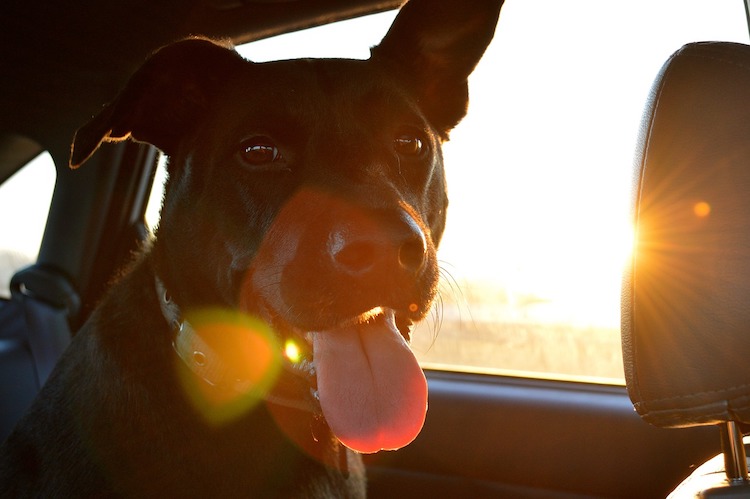
Part 2: Advice for Traveling With a Dog on Longer Car Trips
Be aware of the temperature.
This is an important topic for any pet when it comes to car travel.
Be aware of what the temperature will be at your destination and along the way, and never leave your dog in the car.
It takes only a few minutes for the temperature to rise to dangerous levels inside a vehicle, even in mild temperatures such as 75 degrees Fahrenheit. Lowering the car windows is not an effective way to ventilate the car — and may even allow your dog to escape.
The same can be said for the cold: Dogs can get hypothermia or die from dangerously low temperatures. Keep extra blankets with you, and again — don’t leave your dog in the car.
Hotels, Motels and Camps
If your trip includes staying overnight, check with the place you will be staying to learn about the pet policies, costs and other concerns.
If you plan to find a place to sleep as you go, make a list of dog-friendly places along the way so you know which ones to head to first.
See the Vet Before Long Car Trips With Your Dog
A vet visit is a good idea before a trip, especially for longer trips.
The dog’s veterinarian can check their health and make sure travel will be fine. Discuss sedation with your vet if you feel your dog will be stressed, anxious or have significant issues during travel. (See the next section on ways to prevent motion sickness.)
Do not self-medicate your dog or give your medications created for humans or other animals — these could be deadly.
- Consider getting your dog microchipped before the trip.
- Traveling across states, you may be asked to produce your dog’s rabies vaccination information. Take a copy of your dog’s records, as well as a current photograph in case your dog gets lost.
- Keep a copy of the paperwork and a picture of your pet in 3 places: your car, taped to the carrier and with you at all times. Add your contact information so someone finding your dog can contact you.
- Make sure your dog has a current tag on their collar — and bring an extra one in case it needs to be replaced while you are on the road.
Food and Water
- Limit your dog’s food intake before traveling to reduce the possibility of sickness or nausea.
- Take extra pet food and snacks with you for stops or for when you reach your destination. Stores may not have your dog’s usual brand of food, and changing food during a stressful situation such as travel might be a combination that causes stomach upset, diarrhea or other unpleasantness for your dog.
- Finally, take bottled water — and lots of it — with you on your trip.
- Try to plan stops every 3–4 hours to ensure your dog has ample opportunities to stretch, potty, drink water and get a break from the car.
- Don’t forget to bring along poop bags and/or a scooper to clean up after your dog.
- Keep your dog leashed on walks.
Talk to the Kids
If you are traveling with children, talk to them about allowing the dog to enjoy personal space without distraction.
Discuss behaviors they shouldn’t do, such as:
- Hitting or shaking the carrier
- Feeding the dog their food or snacks
- Teasing, hitting, pulling, or opening the crate — or releasing the harness
Any of these behaviors can add stress to your dog, and the goal is to keep your dog as comfortable and happy as possible while the dog is traveling in the car.

Part 3: How to Prevent Motion Sickness in Your Dog
Did you know 1 in 6 dogs suffers from motion sickness?
If you have a motion-sick dog, then you have our sympathy. Knowing your dog will arrive shivering and salivating (at best!) takes the fun out of a car trip.
Some dogs even learn to anticipate the feelings of nausea, and this makes them reluctant to even get in a car.
If you avoid car travel with your dog or always travel with a full cleanup kit, help is at hand. But don’t expect a quick fix — the answer takes time and dedication.
Positive Associations
Some dogs only have to see a car to start drooling because they link road travel to feeling sick.
This makes them unwilling to get into the car, which means you end up forcing the dog in — which only adds to the dog’s anxiety and feelings of unease.
Put an end to this vicious circle by teaching your dog to associate the car with good things.
- Play with your dog’s favorite toy in the back seat of your parked car.
- End each session on a high by giving them a treat.
- Hop out to go for a walk before they get anxious.
- Reward them for being calm while inside the car with another tasty food treat, and praise their bold behavior.
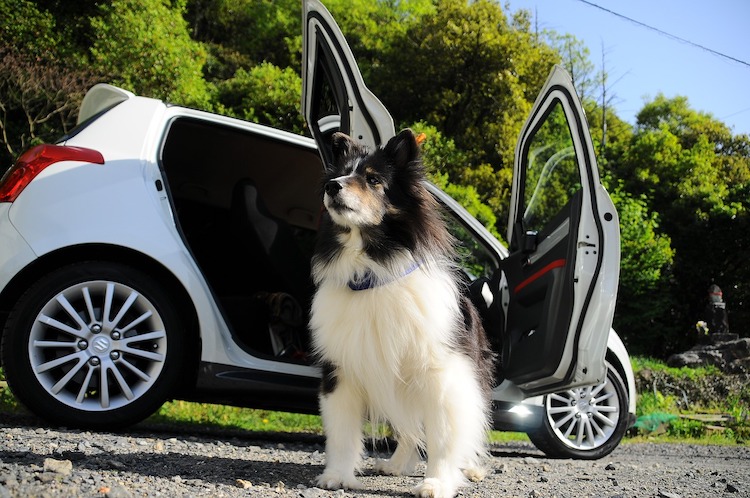
Another option includes spending at least a couple of weeks engaging the dog in a game inside the car but with the doors open so your pet doesn’t feel trapped.
Also try other strategies, such as feeding meals inside the car (perhaps invest in a waterproof seat cover) so your dog sees the car as an extension of the home.
Once the dog is willingly jumping into the vehicle, you’re ready to progress. Take things slow, though — move on to the next stage only when your dog’s tail is in the air rather than between their legs.
Introduce one new change at a time, giving them plenty of time to accept each step.
A retraining journey includes:
- Shutting the car doors
- Starting the engine but keeping the car in park
- Reversing a few feet, then driving back to the parked position
- A short, straight drive up the road
- A short drive around the block, then back into the drive
- A short drive in the neighborhood
All the while, remember the 3 golden rules:
- Praise their calmness.
- Stop before they become distressed.
- End on a positive note.

Car Climate
There’s nothing worse than a hot, stuffy car for making me feel sick when traveling, and the same is true for dogs.
- Make sure the vehicle is cool with fresh air circulating. It also helps some dogs if they can see out of a window — for smaller dogs, consider a booster seat or dog pod.
- Most dogs travel best with a handful of dry biscuits in their stomach, given 1–2 hours beforehand, rather than traveling with a totally empty stomach.
- Stop frequently to let your dog stretch his legs and drink water.
Travel Medications
If you have an urgent journey to make, you may not have the time to desensitize your dog to car travel.
Medication may be your best way forward. At least then the dog will be spared the nausea associated with car travel.
Some people swear by traditional remedies, such as ginger or peppermint. There are also herbal options, such as skullcap and valerian, or quick fixes such as Rescue Remedy.
That said, these are not scientifically proven to be effective, and it’s best not to rely on them, especially for a long trip.
There are also these medications:
- Acepromazine (ACP): This is a sedative with an anti-motion sickness action. ACP isn’t suitable for short journeys, as the dog is groggy for around 8 hours. Also, some dogs have an adverse reaction where they become “hyper” rather than sedated, so test it out before committing to a long journey.
- Maropitant (Cerenia): This drug acts on the nausea center in the brain and turns it off. This makes it the ideal motion sickness tablet — it works for 24 hours without sedating the dog. The only drawback is the price.
Here are a few more great tips from Pet Health Network:

In short, reintroduce the car as a fun place to be, and use medication to stop your dog from feeling sick.
By preventing nausea and building new associations, you’ll find that along this path lies the promise of stress-free car travel with your dog.
Part 4: Why Are Dogs Still Riding in the Back of Trucks?
You’re driving down the road, windows open, hair blowing in the wind and music blaring.
It’s a gorgeous, sunny day that’s absolutely perfect for a road trip.
Until you spot something that puts a knot in your stomach — someone’s dog is freely riding in the bed of their pickup truck.
Not only that, but also you see the driver look down to switch the radio station, only to swerve away from the curb after looking back up. The dog, of course, bumps hard into the side of the truck bed, almost losing balance. The sight makes you cringe.
What do you do? There must be a law against something like this, right?
The straight answer is yes, there are laws against driving with dogs in the back of pickup trucks.
Unfortunately, those laws are sparse and certainly not all-encompassing.
According to the Animal Legal and Historical Center, as of 2017, only 5 U.S. states had laws in place to keep dogs out of truck beds:
- Connecticut
- Massachusetts
- New Hampshire
- Rhode Island
Even in those states, there are exceptions to the law.

How Dangerous Is it to Let a Dog Ride in the Back of a Truck?
DMV.org reports that thousands of dogs are killed each year riding in the back of pickup trucks.
That number doesn’t even account for all the injuries that don’t lead to deaths.
You know how gravel and dirt sometimes spray onto your windshield, resulting in tiny cracks in the glass? A dog riding in a truck bed is susceptible to that same gravel and dirt spray. If it’s forceful enough to crack a windshield, there’s no doubt it can harm a dog’s eyes, nose or even lungs if it’s breathed in.
Of course, there are also more obvious consequences, like a dog being thrown from the truck (or being slammed against the back of the cab) if the driver slams on the brakes or swerves.
How Dogs Can Ride Safely in a Truck
Drivers of pickup trucks should always ride with their dogs in the cab and strap them to the seat with a dog-friendly car restraint.
Yes, there are ways to secure crates to a truck bed, but even then, gravel and dirt could potentially damage a dog’s ears, eyes and throat.
And yes, there are ways to cross-tether a dog in a truck bed to prevent them from falling or jumping, but the same dangers remain.
The only real solution when taking your dog for a ride, no matter what kind of vehicle, is to safely secure them with a dog car seat or harness (in the back seat).
Sure, taking that extra step might delay the trip by a few minutes. But isn’t potentially saving lives worth it?
- Center for Pet Safety. “Gunner Kennel G1 Intermediate.” June 2015. https://www.centerforpetsafety.org/cps-certified/gunner-kennel-g1-intermediate/ .
- Becker, Marty, DVM et al. From Fearful to Fear Free: A Positive Program to Free Your Dog From Anxiety, Fears and Phobias . Fear Free, LLC. 2018.
- Horwitz, Debra, DVM, DACVB, and Gary Landsberg, DVM, DACVB, DECAWBM. “Air and Car Travel.” VCA Hospitals. 2013. https://vcahospitals.com/know-your-pet/dog-behavior-and-training-traveling-air-and-car-travel .
- DMV.org. “Traveling With Your Pet.” https://www.dmv.org/how-to-guides/pet-travelling.php .

Don’t leave your pet’s food safety to chance.
Sign up for petful’s recall alerts today. (it’s 100% free.).

Stay informed. Protect your pets.
Meet Petful
- How We Help
Pet Food Safety
- Free Recall Alerts
- Pet Food Recalls
- Report Problems
- Vet-Approved Recipes
- Adopt a Pet
- Privacy Policy
- Cookie Policy
- Terms & Conditions
© 2024 Petful® / P51 Capital All rights reserved. Petful does not provide medical advice, diagnosis or treatment. More information.
Skip Navigation
Where To Buy Sign Up & Save

- FIND THE RIGHT FOOD FOR YOUR DOG
SHOP BY AGE
- Adult (1-6) Dog Food
- Adult (7+) Dog Food
- Adult (11+) Dog Food
SHOP BY BRAND
- Prescription Diet
- Science Diet
- Bioactive Recipe
COMMON HEALTH CONDITIONS
- Food & Environmental Sensitivities
- FIND THE RIGHT FOOD FOR YOUR CAT
- Kitten Food
- Adult (1-6) Cat Food
- Adult (7+) Cat Food
- Adult (11+) Cat Food
- Skin & Food Sensitivities
- Our Company
- Nutritional Philosophy
- Sustainability
- Ingredients
- Quality & Safety
FOR PET PARENTS
- Information for New Pet Parents
- Articles and Education
- Puppy Nutrition
- Kitten Nutrition
COMMUNITY SUPPORT
- Food, Shelter & Love Program
- Natural Disaster Support
- Shelter Partners
- Pet Adoption Resources
- Contact Hill's
- Frequently Asked Questions
- Chat with Us
- Press Releases

COMUNITY SUPPORT

Traveling With Dogs in a Car: Safety Tips
- routine-care
Learn more about Hill’s commitment to sustainability
Find food that fits your pet’s needs
Find a dog food that fits your pet’s needs, find a cat food that fits your pet’s needs.
Whether you're packing up for an extended road trip or a short drive to the park, riding in the car with your dog can be a fun adventure for both you and your furry companion. However, traveling with dogs in a car can pose some safety concerns. Read on to learn more about safety tips for car travel with dogs.
Bring Health Records
Planning ahead when traveling with dogs in a car is important. Ensure your pup is up to date on vaccinations and has identification tags with current information on their collar. You can also have their veterinarian implant a microchip, which can be scanned and used to help identify your dog in case their collar comes off. Carry a copy of their vaccination records, most recent physical exam and blood work in case of an emergency. If traveling in the car to another state, a health certificate from your vet may be necessary. Get in touch with them to discuss requirements and schedule an appointment in advance of travel, as health certificates can be difficult to obtain last minute. The American Veterinary Medical Association is a great resource for more information about traveling with your dog.
Use a Crate in the Back Seat
When traveling with dogs in a car, the ASPCA recommends securing dogs of all sizes in travel-rated crates or carriers , both for their safety and to prevent distractions to you while driving. If possible, place the crate in the back seat of the vehicle or in the cargo area of an SUV, station wagon or minivan, and secure it so the crate won't slide around if you make any sudden stops. It should be large enough for your dog to stand up, turn around, sit and lie down comfortably. It should also provide plenty of ventilation. You can place blankets or crate pads on the floor of the crate to ensure it's a comfortable and homey environment — as long as your dog isn't a known chewer at risk of ingesting their bedding.
When a Crate Won't Work
Sometimes using a crate may not be an option. Alternatively, you can try a safety harness that buckles directly into the seat belt buckle, securing your dog in the back seat. Another available option for safer car travel with dogs is a mesh or metal barrier made for minivans and SUVs to keep your furry friend confined to the back seat or cargo area. While these options are great for confining your dog so they can't get underfoot while you're driving, they aren't designed to protect them from injury during a crash. Although it might seem like these alternatives provide your dog with more freedom, a crate is always best for their safety.

When Your Car Doesn't Have a Back Seat
While the back seat or cargo area of a vehicle is the safest place for your dog to ride, this may not be an option if you have a regular truck cab or two-seater car, for example. In this case, it's best to secure your dog in a crate in the passenger seat and turn off the passenger-side air bags. If your dog is too large for a crate to fit in the front seat, use a safety harness to secure them instead. Never allow your dog to ride in the back of an open pickup truck.
Reduce Car Travel Anxiety
For some dogs, traveling in the car can be stressful. Here are some steps you can take to help soothe and limit their anxiety :
- Acclimate them to the crate or harness they'll be using prior to travel.
- Start with short car rides, gradually working up to longer periods in the vehicle.
- Make frequent stops — at least once every two hours — to give your dog a break, let them stretch their legs and give them an opportunity to use the bathroom.
- Pack plenty of fresh water and a collapsible bowl to offer during stops.
- Bring a familiar blanket or toy from home.
- Never leave your dog alone in the vehicle, even for brief periods.
- Discuss options for anxiety-reducing medications with your vet if needed.
Remember that these guidelines for traveling with dogs in a car are for your and your dog's comfort and safety. All dogs, no matter how big or small, should be secured while riding in a vehicle. Your small breed dog might be perfectly content to curl up in your lap during the trip, but it's safer for everyone if you resist their charms. With a little planning and a good dose of attention to your dog's needs, you're bound to have a joyful, memorable road trip together.
Contributor Bio

Jean Marie Bauhaus
Jean Marie Bauhaus is a pet parent and pet blogger from Tulsa, Oklahoma, where she usually writes under the supervision of a lapful of furbabies.
How to Travel With a Dog in a Car: 11 Vet-Reviewed Tips

By Nicole Cosgrove
Updated on Feb 23, 2024
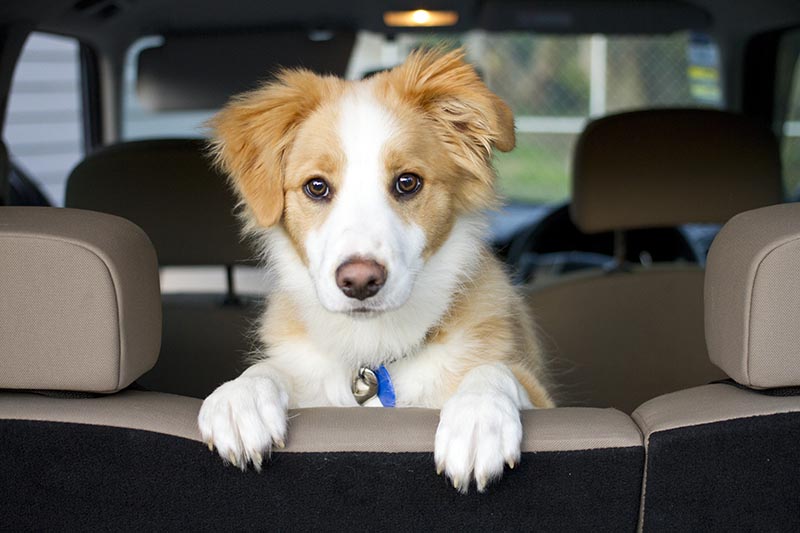
Vet approved
Reviewed & Fact-Checked By
Dr. Lauren Demos
DVM (Veterinarian)
The information is current and up-to-date in accordance with the latest veterinarian research.
Road trips are a great way to get out of the house and enjoy time away from work by exploring. They’re even better when you can take your canine best friend along.
Cars aren’t inherently geared up to be safe for dogs, though, and there are a few things that you need to sort out before you let your dog join you on a long trip. Investing in a sturdy dog seatbelt 1 and making sure the doors and windows are secure are essential, for example.
There are also a few other adjustments to your travel plans that you’ll need to consider to ensure that the journey is as fun for your dog as it is for you.
The 11 Great Tips for Traveling With a Dog in a Car
1. building up to longer trips.
To make a long car ride more comfortable for you and your dog, it’s best to build up their tolerance. Start with short drives around the neighborhood. This will help introduce your dog to the feel of the car in motion and give you an idea of how well they handle car rides in general.
Getting used to the car will help ease their nerves about trips. If they’re a puppy that has never been in a car or they associate car rides with veterinary visits, you need to teach them that car rides are a good thing.
2. Seatbelts or Restraints
For the safety of you, your dog, and everyone else on the road, it’s best if you have a way to keep your dog restrained while the car is in motion. This is important whether you’re driving alone with your dog or you have passengers who can keep them out of trouble for you.
Dog seatbelts are one way to accomplish this. These can either be leashes with seatbelt attachments or straps that hook over the headrest and attach to your dog’s harness. You can also use a dog crate or car seat to keep your dog in one place.
Not only does restraining your dog keep them from jumping around the vehicle while it’s moving, but it’ll also keep them and other passengers safe during an accident, along with helping emergency services tend to the injured without a scared, loose dog threatening their safety.
3. Empty Stomach
Dogs can get carsick just like we do. If you know that your dog suffers from car sickness or just want to make the ride as comfortable as possible for sensitive stomachs, don’t feed them as much before you set out.
For longer car trips, give your dog a small, light meal a few hours before you set off. This will digest easily and still keep your hungry pooch happy while they’re cooped up in the car.
Avoid feeding them big meals during the journey. Take along snacks that they can chew on, but otherwise, wait to feed them their dinner until you’ve reached your destination.
4. Plenty of Water
It might be a bad idea to let your dog eat big meals during car rides, but you need to make sure they drink plenty of water. Driving long distances can make it easy to forget to take breaks, and your dog is unlikely to have free access to water while the car’s moving, especially if you don’t want water spilling everywhere.
Pack a few water bottles and a travel-sized water bowl for your dog, and offer them water every time you stop at gas stations or rest stops. This is especially important if your dog doesn’t like to drink while the car is in motion.
5. Regular Potty Breaks
Car rides can be uncomfortable and boring, for your dog and for you. You might be able to keep yourself distracted from long drives by listening to the radio or chatting with your passengers, but your dog won’t be able to play while they’re restrained in a crate. While you can give them their favorite toys to play with, nothing works as well as taking frequent breaks.
Stopping at rest stops regularly enables you to stretch your legs, take a break from driving, and give your dog much-needed playtime. They’ll be able to go to the bathroom, drink water, and explore for a bit.
A vigorous game of fetch might even wear your dog out enough that they sleep through most of the trip.
6. Not Leaving Them Unattended
Summer, cars, and dogs don’t mix well. Never leave your dog in a locked car unattended, even for just a few minutes. Cars quickly become far too hot on sunny days, and your dog has a fur coat to worry about too. The opposite is true on frigid winter days. Without the heating running in the car, your dog will quickly get too cold.
It’s not just the health of your dog that you should consider. A well-meaning bystander who sees a dog left alone in a car might smash the window to get them out, even if you’ve only been gone for a few seconds.
7. Canine Travel Kit
Whether you’re taking a week-long road trip or just heading out for the day, you’re likely to only pack a few essentials . If you’re traveling alone, this can be limited to one or two small bags. Once your dog is included, though, there are a few other essentials that you need to consider.
Your canine travel kit should include all the basics: poop bags, a collapsible water dish, a dog first aid kit, your dog’s favorite toy, a few chews, and their favorite treats to snack on while you drive. You may also want to take health and vaccination records with you.
The best part is that most of these doggy essentials are lightweight. If you use a harness, you can attach small bags to it, so your dog can carry their own travel kit and everything that they need is always close at hand.
8. Microchipping Your Dog
Your dog should already have a collar and ID tag with your contact information on it, but these aren’t infallible. If your dog loses their collar or tag for any reason, there will be no way for strangers to identify your dog if they get lost. A microchip is a permanent form of identification that is always with your dog.
While it’s not pleasant to consider the possibility of your dog getting lost during your road trip, a microchip will increase the odds of them getting back to you quickly. If someone finds them and takes them to a veterinarian or a shelter, whoever scans the microchip will be able to contact you and get your dog back home.
9. Closed Windows
Many people love to let their dogs stick their heads out of the car windows during long drives. It can be cute and many dogs enjoy it, but it’s a dangerous habit to let your dog develop.
When you’re driving — whether on slow back country roads or busy highways — the wheels kick up a large amount of dirt from the road, and dust can get thrown around by other cars. There’s also the risk of an unrestrained dog spotting a squirrel on the side of the road that they simply must get to immediately.
If you do want to keep the windows open, don’t open them far enough to let your dog stick their head out. Or, only open the windows that your restrained pet can’t reach.
10. No Rides in an Open Truck Bed
Dogs can get muddy and horrifically smelly when you’re adventuring together. In these cases, riding in an enclosed car with them isn’t pleasant. You shouldn’t use this as an excuse to let them ride in the open bed of your truck, though. Packing dry shampoo or wet wipes is often enough to get your dog smelling good enough until you’re back home, or you can even bring a makeshift shower head for on-the-go baths.
If you don’t have enough room in your truck’s cabin for everything that you need to take and your dog, reconsider if you need everything that you’ve packed, find alternative transport, or ask someone to look after your dog while you’re away.
While it’s always sad leaving a dog behind, it’s far safer than risking a serious injury or death by letting them ride in the back of the truck.
11. Local Veterinarians
If you’re in an unfamiliar town, locating a veterinarian can be stressful during emergencies. Unfortunately, accidents happen, and planning ahead is the best way to make a horrible situation easier to handle.
Before you head out on your trip, plan your route. Make a note of all the places that you can stop at for potty breaks and to sleep overnight. For each place, keep a list of numbers for the nearest 24-hour veterinary clinics, especially if you’re unfamiliar with the area you’re road-tripping through. If you’re heading out for a day trip, keep your destination’s local veterinarian’s number handy.
While this might seem excessive, if your dog does get into an accident, you’ll be prepared to handle it.
Final Thoughts
Traveling is fun but stressful , particularly when your dog tags along. While there’s nothing better than going on an adventure with your furry friend, it’s important to keep them safe too. These tips not only will help you keep your dog safe during car rides but also as comfortable as possible. We hope that we have helped you plan for your next trip with your dog!
Related Reads:
- Is It Safe for Dogs to Fly? Flight Options & Preparation
- Benefits of Traveling With Dogs: 10 Advantages & Tips For Your Trip
- https://www.animaltrust.org.uk/blog/how-to-travel-in-the-car-with-your-dog/
- https://www.akc.org/expert-advice/home-living/complete-guide-to-traveling-with-your-dog/
Featured Image Credit: Aarontphotography, Shutterstock
Related Articles
Further Reading
How to Groom a Dalmatian: 7 Expert Tips
Apr 1, 2024 - 5 min read
Newfoundland Dog Grooming: 11 Expert Tips
Apr 2, 2024 - 7 min read
HOWND Plant Powered Dog Superfood Review 2024: Out Vet’s Opinion
By Dr. Karyn
Apr 10, 2024 - 9 min read
Vet Articles
Latest Vet Answers
The latest veterinarians' answers to questions from our database
How Long Does It Take a Cockatiel Egg to Hatch? Vet-Approved Facts
Answered by Dr. Luqman Javed, DVM (Vet)
What Size Tank Should I Use for 2 Goldfish? Our Vet Answers
Can Two Male Betta Fish Live Together? Our Vet Explains
When to See a Veterinary Neurologist for Your Cat
Answered by Dr. Lindsay Bisset, BVSc (Vet)
E. Coli Infection in Cats: Vet Explained Causes, Signs & Treatments
Answered by Dr. Chantal Villeneuve, MS BVetMed (Vet)
7 Neurological Issues in Dogs & Common Signs to Keep in Mind (Vet Approved)
Cat food recalls
Have a cat? Stay on top of cat food recalls here >
Dog food recalls
Have a dog? Stay on top of dog food recalls here >
Have a question? talk to a vet online for advice >

- Cheap and Budget Friendly Recipes
- Health Related Illness Diets
- Homemade Treat Recipes
- Homemade Dog Treats for Health Issues
- Seasonal Recipes
- Can Dogs Eat…
- Dog Diseases & Conditions
- Dog Symptoms
- Dog Grooming
- Caring For Seniors
- Dog Loss & Grieving
- Dog Reproductive Health
- Treatments and Home Remedies
- Dry Dog Food
- Wet Dog Food
- Best Dog Products
- Dog Accessories
- Dog Health Products
- CBD for Dogs
- Toy Dog Breeds
- Working Dog Breeds
- Terrier Dog Breeds
- Sporting Dog Breeds
- Non-Sporting Dog Breeds
- Mixed Breeds
- Hound Dog Breeds
- Livestock and Herding Dog Breeds

15 Safety Tips for Traveling with Dogs in Cars

Table of Contents
1. Never leave your dog alone in the car
2. understand motion sickness, 3. food can trigger motion sickness in dogs, 4. deal with your dog's traveling jitters, 5. use the buddy system, 6. some dogs remember a lot, 7. don’t wait until it’s an emergency, 8. drugs might be a short-term fix, 9. dog carriers and dog crates are safer, 10. buckle up in the back, 11. hide his eyes or distract the nose, 12. more pressure can be a good thing, 13. keep his head in, 14. have identification tags ready, 15. take a dog backpack or carrier.
S ome dogs and their owners definitely come as a pair. They always want to be together. If your dog enjoys going for a ride, traveling with dogs in cars can be a lot of fun. However, there are a few things you'll need to do to keep your pet safe and happy during the car ride.
Don't be upset if your pet doesn't like to ride in cars. Even though the majority of canines love riding in cars, for some dogs, it's just a bit of anxiety that keeps them from enjoying a ride in a car. With a bit of training and a little patience, you can curb your pooch's fear in no time. But how come some dogs simply love riding in cars, then?
CarAndDriver.com asked the experts why most dogs enjoy riding in cars, and it turns out that it's not because of the riding experience itself. The experts say that dogs love cars because they love us, their owners. It's the shared car ride experience .
Nevertheless, nervous jitters aren't going to be your only problem when it comes to traveling with dogs in cars. Your furry friend can also be a big distraction to you while you're driving. You'll need to take the proper steps to keep your dog safe while he's riding inside the vehicle, and that involves keeping him in the cargo hold or a dog car seat .
If your pup is roaming around in the car, he's going to distract you and become a dangerous projectile in the event of a car accident. Not to mention, it's likely that he'll be getting into things or climbing on your passengers. Follow these tips to prevent any of this from happening when traveling with dogs in cars.
ALSO READ: How to Prevent and Treat Car Sickness in Dogs
15 Tips for Traveling with Dogs in Cars
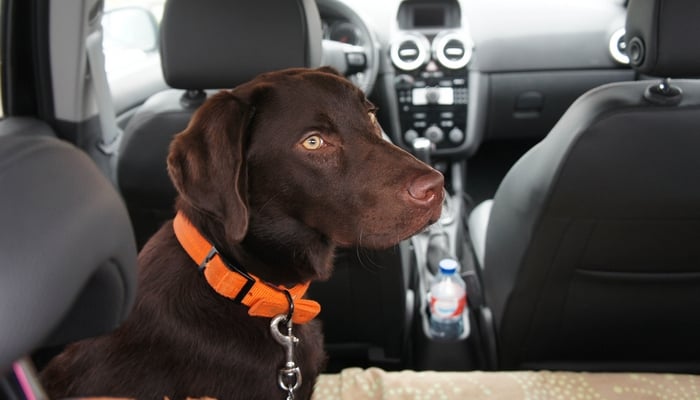
This should go without saying. Dogs can get a heatstroke from being locked in the car, which can be fatal . In many US states, locking your dog in a car may even be against the law or be considered animal abuse to leave your dog inside a vehicle.
The same applies to leaving dogs in cars in winter. When it's cold weather outside, it can eventually get very cold and freezing in a parked car, so make this a year-round rule.
Puppies are more likely to get sick in the car, just like young children. This is probably because their inner ears aren’t fully developed. Try to be aware of how your dog is feeling, and try shorter trips or other techniques until he gets more comfortable.
Symptoms of motion sickness in dogs range from the obvious to the more subtle:
- Extra drooling
- Restlessness
- Vomiting (in the car or shortly after arrival)
Don’t feed your dog in a moving vehicle, at rest stops, or right before a car trip unless he is a really comfortable traveler who never gets any signs of motion sickness. It’s better for the dog to have a light meal a few hours before traveling and not much on any dog treats.
Trust me, the last thing you want to deal with is a dog throwing up as you're driving down the freeway. But just in case you aren't sure whether this is going to happen or not, it's always a good idea to have dog car seat covers on the back seats as well.
It’s a cliché that dogs can’t wait to go out for a ride, but not every dog feels that way. Some dogs find traveling in cars frightening, and that can be a serious inconvenience.
If that's the case with your pooch, then accept that your dog’s fear is real and slowly begin to desensitize him with short, positive experiences, like treats or trips to the park.
For example, if you never travel with your dog to anywhere interesting and only drive together to the vet or the kennel, how interested can your dog be about getting in the car? It's a negative association for him. You’ve got to make it an enjoyable experience for your dog. You may need to start with a reward just for getting into the car.
Don’t push things too hard or fast. Forcing your dog too much only teaches him to expect things to get progressively more difficult and scary. Mix things up: play near the car, encourage him to reach in for a dog treat on the floor or climb over the car seat. Then, go for a quick trip. Just be patient and accept Fido's pace. They need to acclimate.
READ MORE: 10 Tips On How to Calm Down a Dog
If there's a friend with you when traveling with dogs in cars, there will always be someone to hold the dog’s leash when you go in a store or someone to help if there’s an issue.
Just having someone beside him in the back seat might help in the beginning. So try to make it a fun trip and bring more people; for dogs, the more, the merrier.
Dogs can associate streets, landmarks, and what direction the car turns with certain locations. They might get excited on the way to the dog park but frightened if you turn towards the vet’s office. You may need to deal with situations like this with more positive training and rewards.
Ultimately, it's all about training your pooch to adjust to the environment and the procedure of riding in the car: getting in, staying in, and getting out. Dedicate to train him at first and reap the benefits for the rest of the time.
If you need to take your dog on a long car trip or go to the vet, dog groomer, or kennel, start positive: give him rewards and train him as early as you can. Puppies should ideally learn to make a positive association with riding in cars before they leave for their forever homes and are separated from their mothers.
An emergency is stressful enough that you don’t want to take on more than you have to. Car travel preparations can save you a lot of stress and time. It’s better to leave your dog at home, get a dog sitter, or take him to the kennel than jump right into more than your dog’s ready for. Bad associations are harder to deal with than just inexperience.
You don’t want your dog dependent on medication whenever he needs to travel or have him completely sedated. However, something to take the edge off his fear or settle his stomach might help him to be less anxious and start making more positive associations.
There are plenty of drug solutions out there, and you can get some of the best dog anxiety medications to calm your dog before any car ride. Just keep in mind that it's not a long-term solution, and you still need to train your pooch for positive association.

Dog crates have been one of the best solutions when traveling with dogs in cars because many dogs love them (especially after you crate-train your dog) . They feel much calmer in their crates, and pet parents also reap the benefits: it's easy to transport your pooch in a dog crate, and you can also use that crate later once you arrive at your destination.
Not all dog crates work with cars, however. There are some that are specially designed and particularly travel-friendly dog crates , which will be more secure in the car and comfortable for the dog, too.
Airbags are as dangerous for your dog as they would be for a child. Anchor any dog crates or pet carriers with a proper seatbelt or use a dog restraint harness when traveling with dogs in cars to prevent them from shifting around if there is an accident or sudden stop. In some places (Tennessee), it's the law that your dog can’t move freely in your vehicle.
Luckily for pet owners, there are specially designed dog seat belts that work in many different ways: some just restrain a dog (like this EzyDog Restraint Harness) and keep him secure, and some will attach only to an existing dog harness that you've already put on your pooch, and others will also work with dog crates and secure them in the car.
We've done a test and comparison video review to find the most effective solutions for this. Take a look at the results of our best dog car seat belt round-up.

There are also special calming caps or fly masks to limit your dog's vision when traveling in a car. There are things called Dog Appeasing Pheromone collars (or D.A.P. collars). These collars contain special pheromones that calm your dog and provide him comfort. Adaptil is one of the most popular DAP collars out there but search for your own best solution.
Alternatively, you can also try essential oils like lavender or peppermint. Read more on how to use essential oils with dogs and why you should give this natural solution a try.
Some dogs react well to a calming pressure vest or wrap. Think of it like a hug to make your pup feel better. This is why many owners are opting to use calming vests and jackets for dogs to keep them stress-free. There's no science behind this other than it actually works well.
For example, a Thundershirt is the most popular vest for calming dogs, and it's often used for anything—from dealing with separation anxiety in dogs to calming them down during car rides, training, fireworks, loud noises, or all types of travel. There are a few other great quality dog anxiety vests that have been positively reviewed by hundreds of owners.

It has been very popular to allow dogs to keep their heads outside of moving vehicles, but the cold air pushed into their lungs can do some damage to their health. That is without mentioning how he might get hit with something like stones or other debris.
There are actually tons of reasons not to allow your dogs to stick their head out of cars, so maybe don't do it.
Dogs need frequent rest stops on long trips, but never let your dog out of the car or out in public without an identity tag. Keeping your dog on a leash in an unfamiliar place is the best thing you can do to keep him safe, even at the dog park.
Even if your pet is equipped with a dog GPS tracker so you can easily locate him, nothing will be as reliable as an ID tag that you attach to his collar and have your phone number on. Dog ID tags are cheap, small, and simple to put on, so there's no reason not to use them to provide yourself with just a little more peace of mind.
You’ll need certain things while traveling with dogs in cars , like bags for poop, a leash, and a water bowl. At the same time, if you have a smaller breed dog and no dog crate with you, you may want to carry your pooch somewhere where he cannot go himself.
This is where dog backpacks or carrier slings are great because you can store everything, including your dog in them. And it doesn’t hurt to be prepared with a first aid kit for dogs and yourself, towels and paper towels, water, dog food, and whatnot. All, just in case.
READ NEXT: 4 Essential Tips For Traveling With Dogs That Will Keep Them Safe

LATEST FEATURES
Can I Afford A Dog?
How to Get Rid of a Dog: The Right Way
Why Are Dogs So Loyal?
Why Do Pets Make Us Happy?
Dog Names Starting With Z
How Many Dogs Are Too Many?
Can Dogs Get Sick From Humans?
Dandie Dinmont Terrier Breed Profile
Dog Names Starting With Y
Can Dogs Be Blood Donors?

- Terms of Use
- Privacy Policy
- No AI Clause
Didn't find what you need? Use the search!
Pet Keen is reader-supported. When you buy via links on our site, we may earn an affiliate commission at no cost to you. Learn more .
How to Travel by Car With Your Dog: 10 Vet-Approved Tips for Safety & Comfort
Vet approved
Reviewed & Fact-Checked By
Dr. Paola Cuevas
Veterinarian, MVZ
The information is current and up-to-date in accordance with the latest veterinarian research.
We often grow so closely attached to our dogs that it’s hard to imagine a trip or vacation without them. Instead of leaving our beloved pets with a sitter, it’s sometimes more manageable to bring them along for the ride. That said, traveling can be a stressful time for both you and your pet when you aren’t prepared. When you come up with a travel strategy in advance, the journey becomes much more enjoyable.
Whether traveling for pleasure or necessity, there are crucial steps that you must take to prepare for your dog’s needs. Taking the family pet on the road makes the experience more fun for everyone involved, but you want your dog to be as stress-free as possible while you head to your next destination.
- Preparing to Travel by Car With Your Dog
The vet’s office isn’t just for yearly checkups and emergencies. Always take your animal to the vet for a checkup before going on a trip. The vet will make sure your dog’s vaccinations are up to date and supply you with a health certification if you’re traveling across a border. On top of that, veterinarians are equipped with tools and advice for traveling with pets, and they may bring up valid points that you would have missed if you didn’t make the appointment.
You should always be prepared for a road trip emergency and check for a 24-hour hospital at your final destination. If traveling by car, look up a few veterinary clinics on your route so there is always an option in case anything goes wrong.
The last thing that you want to deal with is a lost dog in unfamiliar territory. Make sure both your dog’s leash and collar have tags with the dog’s name, your name and number, and proof of a rabies shot. Give all the information to your vacation host, too so they can pass along the details if necessary. Keep an up-to-date photo of your dog with you, and have a copy of their health records on hand.
The 10 Tips on How to Travel by Car With Your Dog
Preparing for a big trip is already anxiety-inducing, and the stress only gets worse when you have one of your most beloved family members hitting the road with you. These traveling tips can help you out.
- 1. Keep Your Dog Restrained
We have seat belts to keep us safe, and your pet should also have a security measure in place. A dog crate is a smart way to keep your dog secure and protected while on a road trip. It’s also easy to move in and out of buildings, and you can keep your dog out of trouble if you’re staying in a hotel.
Only use a large enough crate that your pet can stand, sit, and lie down in. Try to get a crate with a leak-proof bottom that you can fill with absorbent material in case they have any accidents in the car. Ventilation is highly important, and there shouldn’t be anything blocking the holes that enable air to flow into the crate.
To make your dog more comfortable, throw in a few of their favorite toys, a comfortable mat or bed, and a water bottle in case they get thirsty.
- 2. Get Them Accustomed to Travel
It’s not a wise idea to take your dog on a 10-hour road trip if they’ve never been in your car for longer than 15 minutes. The experience will be better for all involved if you take them on short trips a few months before the big vacation.
Set up your car so your dog is traveling in the same way that it will be for the final journey. On each short trip, gradually increase the amount of time that you spend in the car. Eventually, your dog will grow accustomed to the travel, and the longer trips will be a breeze.
- 3. Stop to Feed Your Dog
Trust us when we say that it’s never a good idea to feed your dog while the car is moving. If sudden car sickness comes on, you’re one turn away from having to stop to clean up vomit.
Give your dog a meal 3 to 4 hours before you hit the road. Whenever it is time for them to eat again, always pull the car over and stop to let them eat and take a bathroom break before resuming.
- 4. Don’t Leave Your Dog in the Car
Do not ever leave your dog in a car unattended. It is a sure way to make your dog freeze or overheat, and it could have deadly consequences. Also, a passerby might view your choice to keep the dog in the car as a poor one and break your window in order to free them.
- 5. Pack a Bag for Them
Humans aren’t the only family members who should have luggage on this trip . You should be prepared for any situation, and there are essential items that you should have stashed in one safe place . Include your pet’s most recent immunization and health records, food, water, bowls, and medications. It’s also smart to come prepared with cleaning supplies, waste bags, and a few toys so they don’t get bored. Last but not least, a pet first-aid kit is a wise investment if you haven’t already bought one.
- 6. Have a Way to Identify Your Pet
You might want to consider getting your dog microchipped if the vet hasn’t already done so. Aside from a collar that could come loose, microchips are embedded into the dog’s skin. If your pet were to get loose and someone took them in, most places would check for a microchip so they can get in contact with you about their whereabouts. If possible, get your dog a GPS tracker so you know where to find them in case they get lost.
- 7. Don’t Let Them Stick Their Head Out the Window
It seems like a fun idea to let your dog feel the breeze blowing through their fur , and we won’t deny that it’s cute, but this puts your pet at major risk of injury. They could get struck by other passing cars, thrown from the vehicle if in a crash, or fall out of the car while it’s moving at high speeds. Your number-one concern on your trip should be safety for all, and that includes your furry friend.
- 8. Have Plenty of Water on Hand
You don’t want your dog drinking from an unfamiliar source on the side of a parking lot. It’s less stressful if you have a case of water in your car that you can grab whenever your dog is feeling thirsty. This way, they get a freshwater source, and you don’t have to go searching for somewhere they can get a drink.
- 9. Protect Your Car
With shedding fur, long nails, and anxiety at an all-time high, it’s a good idea to invest in car seat covers or mats that can protect your car’s interior from damage . You never truly know how your dogs will react while traveling, and the last thing that you want to do is to pay for repairs.
- 10. Ask Your Vet for Medicine
Some dogs travel better than others , and if your pet has a great deal of anxiety, your veterinarian may be able to prescribe helpful medication to ease that anxiety while traveling. These medicines can work wonders if you have a nervous dog, and they can make the trip more enjoyable for you too.
- Final Thoughts
Traveling is exciting, stressful, and demanding all at the same time. The only way to make the ride go as smoothly as possible with your dog is to prepare, prepare, prepare! Envision the entire trip, and try to think of every situation that could happen. You want to be able to handle whatever life throws your way, and if you’re already one step ahead, you’re going to experience a much better car ride with your furry family member than if you winged it from the beginning.
- 15 Tips for Making Your Dog’s First Vacation a Success
- 10 Best Dog-Friendly Vacation Destinations in Canada
Featured Image Credit: Andrey_Popov, Shutterstock
Nicole Cosgrove
Lead Pet Expert & Pet-ditor in Chief
Related articles
How much exercise does an australian shepherd need vet approved advice, when will my labradoodle calm down facts & faq.
Search our database of over 16750 posts with up-to-date information from our experts and veterinarians.
Want to talk to a vet online?
Whether you have concerns about your dog, cat, or other pet, trained vets have the answers!
- PRO Courses Guides New Tech Help Pro Expert Videos About wikiHow Pro Upgrade Sign In
- EDIT Edit this Article
- EXPLORE Tech Help Pro About Us Random Article Quizzes Request a New Article Community Dashboard This Or That Game Popular Categories Arts and Entertainment Artwork Books Movies Computers and Electronics Computers Phone Skills Technology Hacks Health Men's Health Mental Health Women's Health Relationships Dating Love Relationship Issues Hobbies and Crafts Crafts Drawing Games Education & Communication Communication Skills Personal Development Studying Personal Care and Style Fashion Hair Care Personal Hygiene Youth Personal Care School Stuff Dating All Categories Arts and Entertainment Finance and Business Home and Garden Relationship Quizzes Cars & Other Vehicles Food and Entertaining Personal Care and Style Sports and Fitness Computers and Electronics Health Pets and Animals Travel Education & Communication Hobbies and Crafts Philosophy and Religion Work World Family Life Holidays and Traditions Relationships Youth
- Browse Articles
- Learn Something New
- Quizzes Hot
- This Or That Game New
- Train Your Brain
- Explore More
- Support wikiHow
- About wikiHow
- Log in / Sign up
- Pets and Animals
- Transporting Dogs
How to Travel by Car with Your Dog
Last Updated: December 28, 2020 Approved
This article was co-authored by Elisabeth Weiss . Elisabeth Weiss is a Professional Dog Trainer and owner of Dog Relations NYC, a dog training service in New York, New York. Elisabeth relies on science-based, force-free, and reward-based techniques. Elisabeth offers behavior training, puppy manners, body awareness and injury prevention, diet, exercise and dog nutrition services. Her work has been featured in New York Magazine and on the Dog Save the People podcast. She also trained all the dogs in the movie "Heart of a Dog" by Laurie Anderson that features Elisabeth's journey with Laurie Anderson's and Lou Reed's dog Lolabelle and how her passion for playing the keyboards played a significant role in improving her quality of life after being diagnosed with pancreatic cancer. wikiHow marks an article as reader-approved once it receives enough positive feedback. In this case, 100% of readers who voted found the article helpful, earning it our reader-approved status. This article has been viewed 846,933 times.
Some dogs love to ride in cars and it's fun to take them along with you wherever you go. However, this is not the case for all dogs. Here are some safety tips you should think about before traveling by car with your favorite pet, whether they enjoy the journey or not.
Preparing to Travel with Your Dog

- If you don't want to cage your dog, at least find a way to make sure your dog is secure. For instance if you have an estate car, consider confining your dog to the rear of the car. If you do have a large window boot, put up a wire grid to stop your dog jumping over the back of the seats. Line the dog's area with dog blankets or place it's bed in the corner so it can nap comfortably on the journey. Make sure you don't have any heavy loose items, such as bowls or bottles, as those can become dangerous projectiles in an accident. Most dogs find sleeping an easy way to cope with motion sickness.
- You could also purchase a dog safety seat. While it is not as secure as a cage, it will be safer and more comfortable than a car seat for your dog if you turn or stop the car suddenly. The most popular among these are bucket seats. They attach at the back of the front seats, and the top of the back seats, creating a soft well in which your dog, and any liquids (or solids!) they may create, are contained. These can be made with a blanket or purchased cheaply.
- Car seatbelts for dogs are a great tool if you don't want your dogs confined, or if you only have a two-seater car. Make sure to attach them to a harness, and not a collar. They clip into the female buckle of a car seatbelt on one end, and have a standard lead clip on the other. By attaching them to a harness, you ensure the dog is secured by the body, and their neck won't be damaged in an emergency.
- If you use a cage, make sure it is secured. Make sure it is very secure to prevent it from moving if you stop suddenly or get hit. An unsecured cage can be just as, or even more dangerous than an unsecured dog.

- Squeaky toys are also undesirable as they will drive you crazy.

Going on a Long Drive with Your Dog

- This is especially important if your going on a long journey. Four hours is your average dog's absolute limit for driving without a longer break, but as a driver it's recommended you take a break after every two hours of driving. Make sure you stop somewhere grassy and relatively quiet (not right beside the road), lock your car, feed your dog some food and water, and take him for a walk so he can let off some of his excess energy.
- If you stop by the highway your dog MUST be on a lead for his own safety.

- If you stop for a meal, park your car in the shade, and let the windows down about an inch each to let cool air in. Put a bowl of cool water in the car for your dog and unbuckle him or her if in a dog seat. Lock your car doors, and order your food to go.
- Try to spend no more than five minutes away from the car if it is a warm day, as you don't want your dog to overheat. If your stop will take a bit longer, for instance you are waiting in a long queue for food, tie your dog to a post either just inside the front door or just outside in a place where you can see it. At least he or she will be out of the heat while you wait. Make sure to tie the dog with secure knots so it doesn't escape. Tight knots will also mean it will be less likely for someone to steal your dog.

Expert Q&A

- If your dog has a favorite towel or blanket be sure to bring it in order to comfort your pet. Thanks Helpful 6 Not Helpful 0
- Try to have your (non-toy*) puppy's first car rides be "on an empty stomach" by withholding food for 2-4 hours before the ride. Several rides without nausea will help tremendously to prevent the puppy from developing car sickness. Thanks Helpful 4 Not Helpful 0
- If you are traveling more than 24 hours, look beforehand for a pet-friendly hotel for you to unwind and for your dog too. Thanks Helpful 3 Not Helpful 0

- Some dogs can get very queasy. Keep a close eye on it and line the back seat with old blankets or newspaper if you want to be on the safe side. Thanks Helpful 42 Not Helpful 2
You Might Also Like

- ↑ https://www.cesarsway.com/dog-care/travel/dog-is-my-co-pilot
- ↑ https://www.cesarsway.com/dog-care/travel/cesars-travel-tips
- ↑ Elisabeth Weiss. Professional Dog Trainer. Expert Interview. 3 September 2020.
About This Article

To travel by car with your dog, you should restrain it with either a cage, a safety seat, or a seat belt designed for dogs, which will keep it safe and prevent distractions while you’re driving. Before your go for your drive, exercise your dog so that it will be tired and less anxious or hyperactive in the car. Additionally, pack supplies such as water, treats, and a few chew toys to help keep your dog occupied. You should also avoid feeding your dog right before a car trip to prevent it from getting carsick or relieving itself in the car. For more advice from our Veterinary co-author, like how to prepare a hyperactive dog for a car trip, keep reading. Did this summary help you? Yes No
- Send fan mail to authors
Reader Success Stories
Ana Carolina
Aug 10, 2016
Did this article help you?

Cheryl Davis
Apr 30, 2017
Larry Cullop
Jul 20, 2017
Feb 16, 2017
Leanne Chatterton
Aug 15, 2016

Featured Articles

Trending Articles

Watch Articles

- Terms of Use
- Privacy Policy
- Do Not Sell or Share My Info
- Not Selling Info
Get all the best how-tos!
Sign up for wikiHow's weekly email newsletter

Car Travel with Dogs: Plan the Perfect Road Trip!
By Author Tara Schatz
Posted on Published: March 28, 2024
Categories Traveling with Dogs , Gear and Clothing , Planning , Travel Tips
You’re planning a monumental road trip, and you’d love nothing more than to bring along your favorite canine companion to share in your adventures.
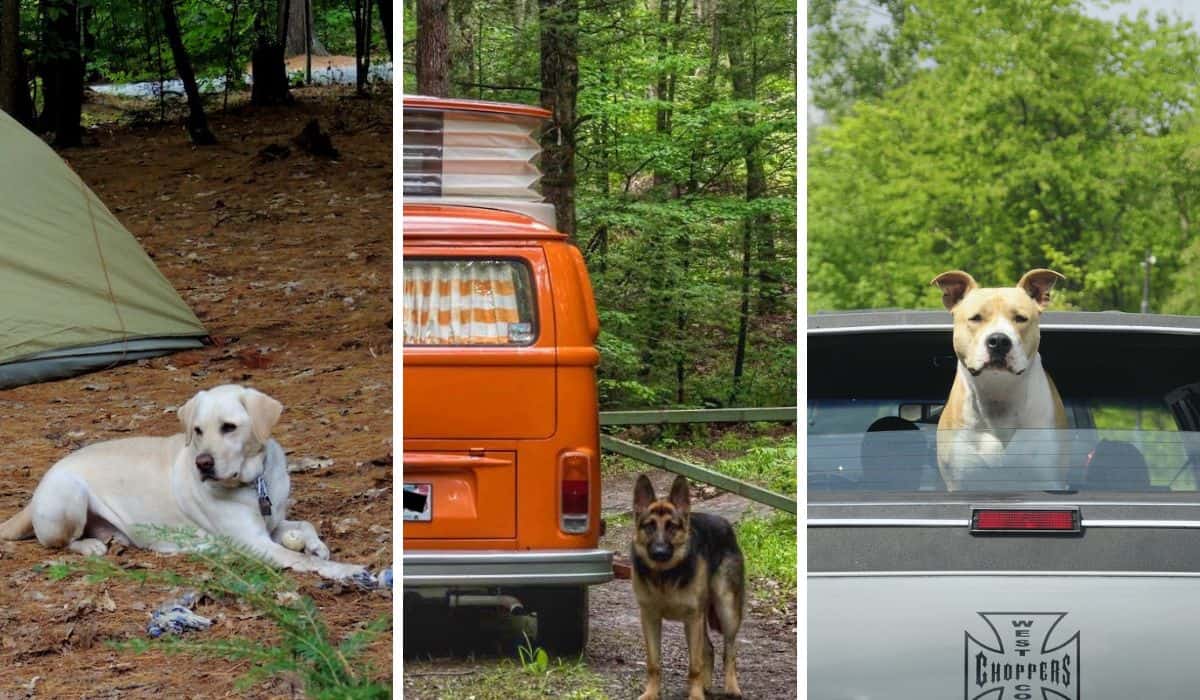
Should you do it? Will your dog cause problems, make your life miserable, and suffer from incredible boredom sitting in the car day after day?
Whether or not you should road trip with dogs depends totally on you, your dogs, and your lifestyle, but I promise that fabulous, inspiring road trips have been achieved with adventurous dogs since the invention of the automobile.
While I won’t be the one to tell you that car travel with dogs is easy, I will absolutely advocate for traveling with dogs in the right circumstances.
We have taken numerous road trips with our dogs over the years and currently travel with our two amazing black labs, Flynn and Malinda. They love riding in the car, exploring new places, and checking out the best restaurant patios.
Kind of like us!

For the most part, dogs love traveling, and there’s no doubt that your pup cherishes time with you above everything else, so let’s try to make it work.
First, let’s decide if car travel with dogs is right for you and your favorite companion.
You Should Absolutely Take a Road Trip With Your Dog if…
- You have room in your car, RV, or camper .
- Your dog enjoys traveling and doesn’t get car sick.
- Your pup is up-to-date on vaccinations.
- Your dog responds to basic commands and is socialized to people and other dogs.
- You are passionate about an active lifestyle.
- You are willing to do some research to find lodging and restaurants that will accommodate your dog.
- You are willing to skip over attractions and destinations that aren’t dog-friendly.
- You are able to make arrangements so that your dog does not have to sit in a hot car while you shop, eat, or explore.
- You’re planning on staying at campgrounds and doing a lot of hiking, swimming, and other activities that are just more fun with dogs.
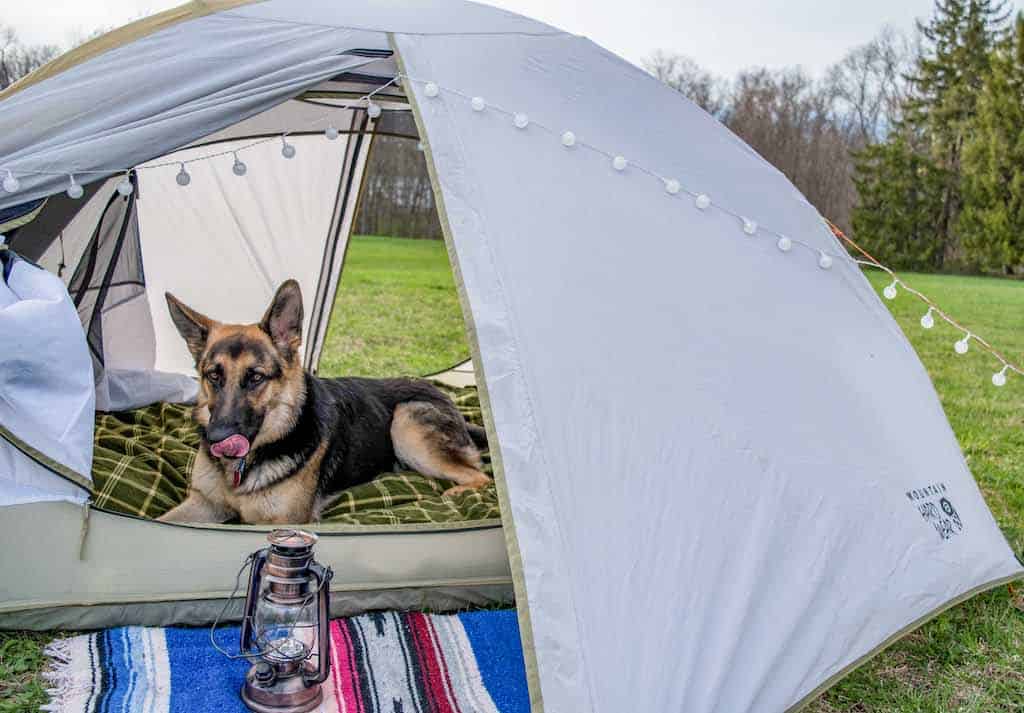
You Should Think Very Carefully About Car Travel with Dogs if…
- Your dog won’t have much room in your car, RV, or camper.
- You don’t think you’ll have time to give your dog the exercise and attention he needs.
- Your dog doesn’t respond to or follow basic commands.
- You plan to spend a lot of time in big cities, national parks, or other destinations that aren’t dog-friendly.
- Your dog gets car sick.
- Your dog loves being at home and you have someone who is willing to care for him.
You Should Definitely Not Travel with Your Dog if…
- Your dog is aggressive with people or other dogs.
- Your dog is not trained and hasn’t been socialized.
- Your dog suffers from anxiety or another illness that would make traveling painful for both of you.
Every dog is different, and it’s important to think carefully about logistics before planning a road trip with dogs. If your dog is up for the adventure, and you’re willing to plan your trip around your dog’s needs, I say go for it!
If the thought of adjusting every aspect of your trip around your dog makes you cringe, you may want to reconsider, but as far as I’m concerned, most road trips are simply better with dogs!
To plan a successful road trip with dogs, it’s important to consider your pup’s needs from the very beginning. We have had the best luck road-tripping with dogs on vacations that focus on outdoor activities, at least in part.
Outdoor vacations work for us because our whole family prefers being outside. That’s not to say that you can’t plan for other indoor-based activities while road-tripping with your dog, it will just take a little more work.
Here are some planning tips that will help you plan for a fabulous dog-friendly road trip.
Where to Stay with Your Dog on Your Road Trip
The biggest piece to the road-tripping puzzle, whether you travel with dogs or not, is deciding where to stay.
If you’re road-tripping in the USA, you will be happy to know that hotels and other accommodations are becoming more and more dog-friendly. There are even hotel chains where pets always stay free.
Where you choose to spend the night with your dog on your road trip will depend a lot on the level of comfort you want and the price you’re willing to pay, but here are some great ideas for lodging with pets while traveling.
Camp with Your Dog Inside Your RV or Camper at a Campground
If this is your situation, you’re in good shape. Your dog can have free run of the camper, can be left alone, provided that it’s not too hot, and will be able to frolic in the great outdoors with you by his side.
Taking an RV or camper on a road trip with your dog is a win-win for everyone involved, and will probably create the least hassle too.
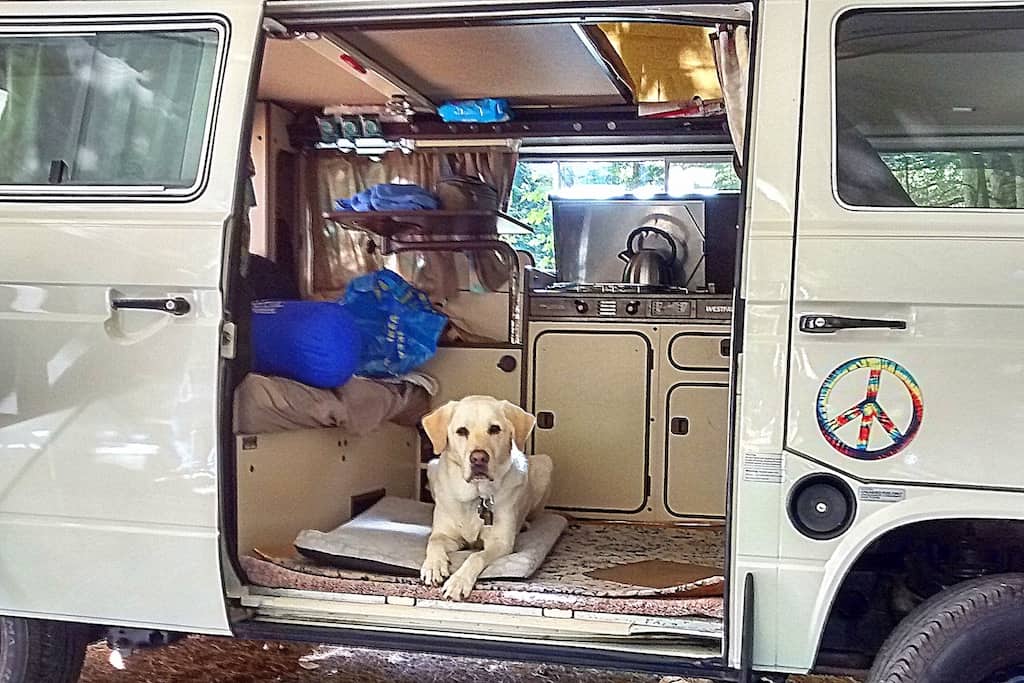
Camp with Your dog Inside a Tent at a Campground
Tent camping while on a road trip is an inexpensive way to see the country, and it’s probably our favorite way to road trip with dogs. We prefer car travel to RVs, and we often travel on a budget.
When tent camping, both dogs and people get plenty of exercise, which makes long days on the road much more tolerable. There are, however, a few downsides to tent camping with dogs.
Have you ever slept in a tent with a wet dog? I promise you, this won’t be high on your list of favorite activities !
The other thing to know is that most campgrounds don’t allow you to leave your dog unattended, which means, for better or worse, your furry friend will be by your side on every excursion you take.
Still, tent camping is our favorite way to stretch a dollar while road-tripping , whether we’re traveling with dogs or not.
Camping may not come naturally to your dog, so I recommend doing some trial runs close to home before setting out on a camping road trip with your dog.
Also Read: The Complete Guide to Camping with Dogs
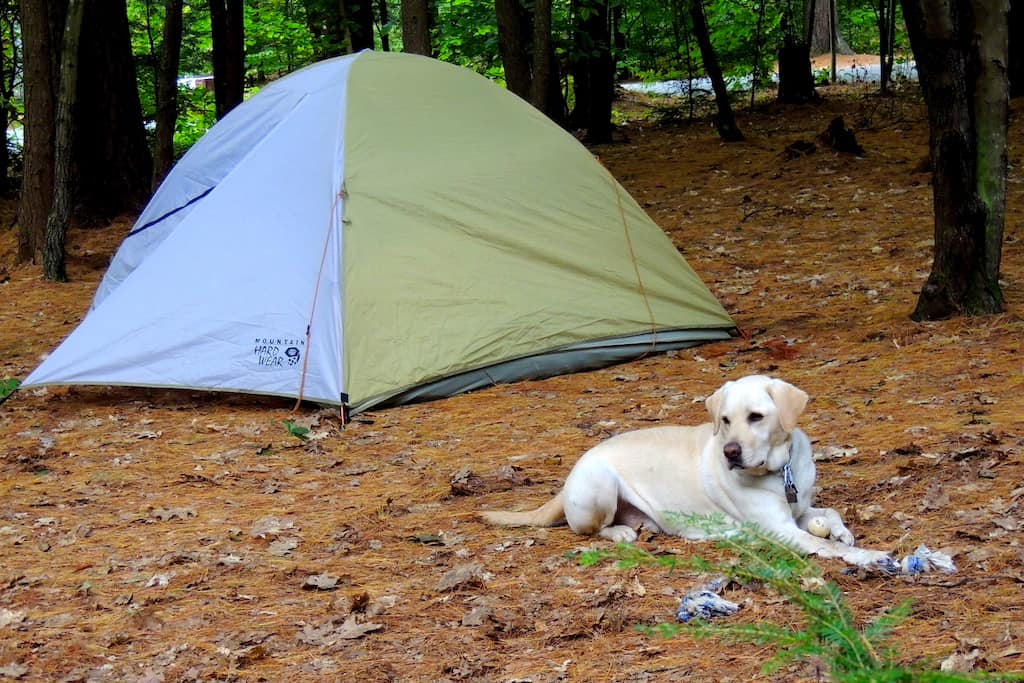
Stay with Your Dog in a Cabin at a Campground
Cabin camping with dogs is an option well worth exploring, especially if tent camping seems a bit overwhelming. Many park cabins don’t permit dogs, but over the past few years, it’s been easier to find dog-friendly spots.
Be sure to do your research ahead of time, and you may find some great options for you and your pooch.
Stay with Your Dog in a Dog-Friendly Hotel

If you’re just passing through, any hotel or motel that allows dogs will serve its purpose, but some places go above and beyond, making your dog feel like the family member that he is.
Bringfido.com helps you search for dog-friendly lodging, and it’s available as a mobile app so you can find hotels on the fly.
Our favorite dog-friendly hotel chain is Kimpton, where dogs always stay free, and there are no size or breed restrictions. Kimpton Hotels go above and beyond to make you and your dogs feel welcome. 100% worth paying a little extra!
When staying with dogs in a hotel, we always bring a crate and we always ask for a room on the ground floor so we can get in and out easily.
Stay with Your Dog in a Vacation Rental
There are some real benefits to staying in vacation rentals (like Airbnb or VRBO ) when traveling with dogs, especially if you plan to spend more than a single night in the places you visit.
We love having a kitchen to cook our meals, and being able to occasionally leave our dogs behind so that we can go to museums, shopping, etc.
Dog-friendly vacation rentals make traveling a little bit easier, but the cost is often higher than staying in a hotel.
Bonus: staying in a vacation rental with your puppy is also a great learning opportunity that can help pups grow into confident, well-mannered dogs.
What to Pack for Car Travel with Dogs
Planning and packing for your dog-friendly road trip is part of the fun (at least for me it is). Here’s everything you need to keep your dog happy and healthy on the road.
- Dog food – Ask your dog, and he’ll tell you that his food is the most important thing for you to pack. If you’re taking your dog on a long trip, you may also want to buy a special dog kibble carrier, which will keep odors down and help you save room on your road trip.
- Vaccination information – Many hotels and campgrounds require that you provide them with your dog’s most up-to-date vaccination records. Don’t leave home without them. You don’t need a hard copy, just take a photo of the records and keep them on your phone.
- Flea, tick, and heartworm prevention – No matter where you travel, there’s a good chance you’ll run into biting insects, and ticks that carry Lyme disease are now found in 49 states. Whatever method you use for prevention, be sure to pack it when you road trip with your dog.
- A travel bed – If you have room in your vehicle, your dog’s regular bed from home will be just fine. If you’re short on space, check out this awesome dog travel bed from ChuckIt! , which comes with its own stuff sack. This bed is one of our best purchases. It’s cheap, water-resistant, and washable, and your dog will feel more comfortable knowing he has is own space when you stop for the night.
- Bones and toys – Bones are great for chewing in the car, and balls and toys can be useful when you reach your destination. What you buy will depend on what your dog enjoys, but our labs never outgrow their Nylabones and Benebones.
- Food and water bowls – They don’t take up much space, but if every square inch counts, check out the Kurgo collapsible travel bowl . It’s totally packable and perfect for hiking and canoe trips too.
- Poop bags. For obvious reasons.
Tips for Car Travel with Dogs
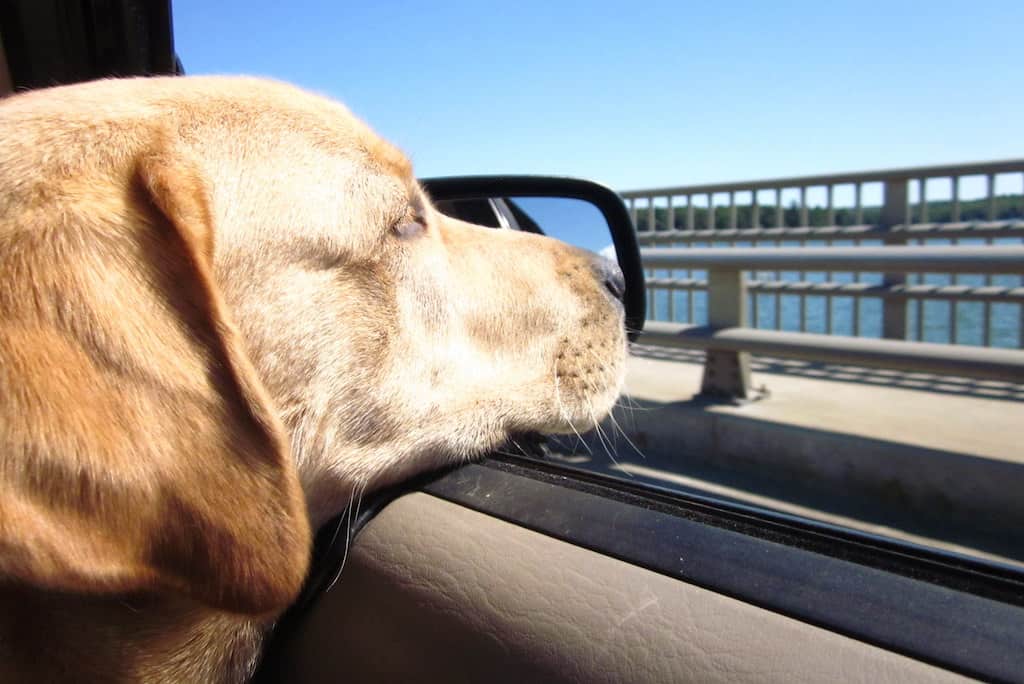
Take some of the stress out of your road trip by planning for what to do if your dog gets sick or lost while traveling. Here are a few tips for car travel with dogs.
- Make sure your dog wears his tags . The tag should include your name, address, and phone number. Don’t forget to include your cell phone number in case your dog is lost on the road.
- Keep your dog leashed or under your voice command at all times. Traveling can be a stressful experience for your dog, and even dogs that stay close to you at home may wander when traveling. That’s why it’s extremely important to keep your dog leashed at all times. Well-trained dogs that respond immediately to your voice command will earn more freedom, just use your best judgment.
- Get your pooch microchipped. According to Petfinder , only 22% of lost dogs that entered animal shelters found their way home to their families, while 58% of microchipped dogs were reunited with their loved ones. A microchip is no bigger than a grain of rice, but it could save you and your dog a lot of heartache at home and on the road.
- Prevent car sickness. Did you know that mild cases of nausea and car sickness can be prevented with ginger snaps? This was news to me, but our shepherd puppy just couldn’t deal with the long, winding roads that we love. Someone recommended ginger snaps before long car rides, and our pup has been fine ever since. I recommend one a half hour before travel, and another when you get in the car.
- Keep your dog safe while driving. According to the Whole Dog Journal , the safest way to travel with a dog in the car is by securing them in a dog travel crate. in the car for your dog is within a secure crate or a harness restraint in the back seat. If you have room for a crate in your car, this is definitely what we’d recommend. Here are some dog travel crates to choose from for your next road trip.
- Don’t have room for a crate? Use a seat belt harness – We travel in a small car, so we have never had room for a large travel crate. Instead, we use a seatbelt harness with our dogs, which keeps them restrained while we’re driving.
- Get plenty of exercise. This will make long trips bearable for you and your dog. Start each morning with a brisk walk, jog, swim, or hike together. Take shorter walks throughout the day, and another vigorous romp before bed.
- Chew toys make car rides a lot more fun. Dogs are like toddlers sometimes — they can get bored and antsy in the back seat. Protect your sanity, and perhaps your seat cushions, by investing in a stash of chew toys for the trip. Whether your dog loves real bones, Nylabones, or Kongs stuffed with peanut butter, you can keep a stash of his favorites hidden away. When things start to get dicey, break out the goods. Everyone will be happier for it .
For Those Times When You Need a Break from Your Dog

Depending on the nature of your road trip, there’s a good chance you’re going to encounter places that just aren’t dog-friendly.
National parks come to mind, although we’ve visited several of them successfully with dogs. Dogs aren’t welcome in most amusement parks, zoos, shopping centers, museums, and many other places.
Big cities can be hard to navigate with dogs too. Does this mean you have to forgo all these potentially exciting destinations or leave your dog at home? Of course not.
You can easily make use of pet sitters along the way. Rover is the Airbnb of the canine world. Their network includes more than 15,000 sitters across the United States. To make use of this incredible resource, simply create an account before you hit the road, and search by zip code when you need a sitter.
Whether you’re heading to Disneyland for a weekend or just a day in the big city, Rover will match you with the perfect dog sitter at prices that are often cheaper than traditional kennels.
Final Thoughts on Car Travel with Dogs
Embarking on a road trip with your dog is a truly rewarding experience, provided you’ve planned ahead. The important thing is to make accommodations that reflect your pup’s needs.
A trip that focuses on outdoor adventure will probably garner the most tail-wagging, but when it comes down to it, your dog just wants to be by your side.
Read more tips for adventuring with dogs:
- The Complete Guide to Canoeing and Kayaking with Dogs
- Everything You Need to Know About Camping with Dogs
- Our Best Tips for Snowshoeing and Skiing with Dogs
- Summer Adventures are Better with Dogs
Follow us on social media!
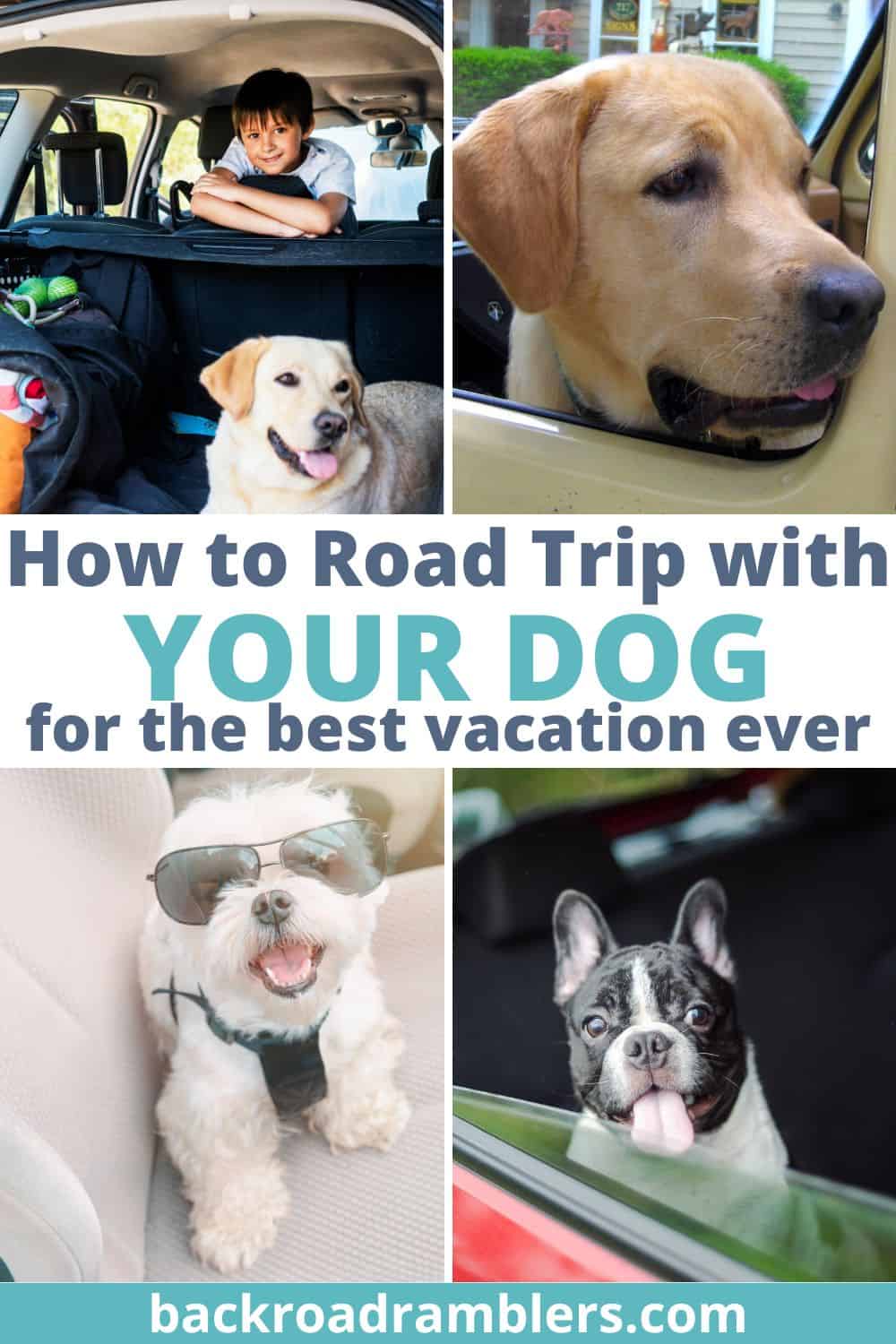
Tara is a freelance writer and travel blogger with a passion for outdoor adventures. She is the co-author of AMC’s Best Day Hikes in Vermont and currently blogs at Back Road Ramblers and Vermont Explored , where she shares travel tips, adventure destinations, and vacation ideas for the wanderer in everyone.
Monday 30th of May 2022
I'm glad you mentioned to think about of where you're going will be good for your dog. I love to take my dogs everywhere but last year went on a trip to see wild horses in Northern Colorado and left my dog at home. Having a dog while approaching wild horses wouldn't have been smart. The ground had a lot of small cacti which would have been horrible in her feet. I had no regrets leaving her home. I spent a year trying to figure out how I wanted to roadtrip with my dog.

Road Trip! Guide to Traveling with Dogs in a Car Long Distance
A cross country trip with a dog should be fun, not stressful. We show you how to travel with a dog in a car.
Depending on your dog’s temperament and experience traveling by car, the thought of taking a long distance road trip with your pal can either conjure up feelings of freedom and adventure on the open road, or instill dread or even panic. Not to worry. We have you covered from start to finish of your journey.
Should you take your dog on a cross country road trip?
Your first consideration should be whether traveling long distance in a car with your dog is even a good idea. Sometimes it’s just not worth the hassle, and letting them stay with a trusted friend or boarding service is the better option.
Some dogs simply hate riding in a car, and if you are unable to help the dog overcome its fears or discomfort on shorter trips, then it makes no sense to try to do this on a long trip. There’s a good chance it will be a miserable experience for both of you.
Another reason to think twice about bringing your dog along is if your road trip involves lots of stops along the way (other than for gas, food, and lodging) or involves events at your destination where you can’t spend enough time with them or provide them with adequate care and supervision. For instance, driving cross country to a wedding may seem fine, but where will the dog stay all day during the wedding?
Thinking ahead and anticipating your daily schedule may lead you realize that bringing the dog along will be more complicated than it’s worth. It also might lead you to solve these logistical problems, and plan ahead accordingly! More on that below.
Well ahead of your trip, you should:
- Plan all aspects of your trip that involve your dog
- Make a list of all essentials you’ll need to bring
- Prep your dog for the trip.
Planning your trip
Do your homework and have a list of dog friendly hotels, restaurants and other places you plan on stopping along the way. It’s better to plan your trip more rigidly than you might otherwise and have the comfort of knowing in advance that your pup is welcome. A late night search for a pet friendly motel is no fun (nor is getting caught sneaking your dog in one where they are prohibited). Fortunately, the number of pet friendly places is greater than ever, and that list is growing rapidly.
Arrange for care of your dog at your destination. If you are attending an event or visiting a tourist attraction that will take you away from your dog for a period of time, you should locate a day care or boarding service in advance.
Leaving your dog unattended is simply not an option. In addition to safety issues, a new environment can stress out your dog, so make sure you have an individual or facility to take care of them. Lots of information regarding pet friendly resources at your destination can be found online. You can also ask for recommendations from the accommodations where you are staying, or family and friends you might know in the area.
Create a dog road trip packing list
It’s good to create a master packing list for your dog so that you can use it each time you travel. You may need to purchase some items to complete it, but once you have them, you’ll be ready in the future to go on short notice.
Pack a separate travel bag for your dog. Just like with our own luggage, we find that it’s easier to access what you need when you’re on the road if thing are organized.
Here’s a list of essentials from which to start.. You can modify it as needed.
Adequate food and water
Make sure you have more than enough food for your dog in case you get delayed or there’s an emergency. The last thing you want to do is have to switch your dog’s food while traveling and risk the upset stomach that commonly occurs when you switch brands or types of food suddenly.
We suggest bringing your own water, either in bottles or larger jugs/container, depending on the dog’s size. While local water may be easier, water from a new source can upset your dog’s stomach, and can also taste different enough that your dog may be reluctant to drink it. Water is as essential as it gets, so no reason to take a chance.
Food and water bowls
You’ll need bowls for both food and water. There are some great collapsible bowls that take up less space. You can also get a dog water bottle , which is convenient at rest stops and doesn’t require a bowl. Just make sure your dog is familiar with it before heading out on your trip.
Leash and collar/harness
Don’t laugh — a leash is commonly forgotten when loading a dog directly into a car from the house.
The collar should have i.d. and license tags attached. Make sure your dog’s info is up to date on the identification tags, with the correct phone number being that of the mobile phone you are carrying and not a number back home (where you will not be if the dog were to get lost). It’s also a good idea to add a second number of a friend on the tag as an extra precaution, especially when traveling.
Toys and bones
Just because he’s traveling doesn’t mean your dog doesn’t need his usual items of distraction. In fact, just like people, he may need them even more on the road to keep him occupied. Remember, it’s a long trip for them, too, and they don’t have audio books to entertain them. Also, a favorite security toy or bone can go a long way towards easing any travel jitters.

Medications
Have an ample supply of all of your dog’s medications, including any motion sickness medicine, topicals and supplements. Like food, have extra in case you get delayed on your trip or have an emergency. If any of your dog’s meds need to be refrigerated, plan ahead by bringing a cooler.
If you are headed to a different climate or an area with unfamiliar geographical characteristics, check with your vet to see if there are any special medical precautions you should take. Even though conditions such as Lyme disease, heartworm, and tick borne diseases can be transmitted anywhere, they are prone to occur in some areas more than others, and your dog may need a vaccine or preventative medication.
Note about dog motion sickness :
Dogs are susceptible to motion sickness. If your dog has ever had issues, or is new enough to you that you’re not sure, check with your vet before leaving on your trip to see if she can recommend an over-the-counter medication or prescribe one if needed. A sick dog in the middle of a car trip can quickly put a damper on the excursion.
Vaccination records
Make sure your pup is up to date on vaccinations. Generally, it’s a good idea to have a copy of their rabies vaccination if you’re crossing state lines. Laws differ from state to state, and a simple photocopy of the record can save you a big hassle in certain situations. Just leave it in your dog’s travel “go bag.”
Bring plenty to last the whole trip. No need to tell you that you should always clean up after your dog. Right?
If you run into wet weather, you will want to be able to dry your dog off and clean its paws before getting back into the car. We find shammies work well because they are super absorbent and don’t take up much space.
Familiar bedding
Whether your dog sleeps in its crate or on the floor, you will want to provide familiar, comfortable bedding to sleep on. We like to use the Petspective Pet Mat because it’s waterproof, easy to clean, and rolls up nicely to pack in the car (plus our dogs vouch for its comfort!).
Protective clothing
If your dog wears any kind of protective boots or outerwear like sweaters or raincoats, don’t forget to pack it.
Thunder Shirt
If your dog wears a Thunder Shirt for anxiety (fireworks/thunderstorm induced or just general uneasiness), bring it along. If your dog does encounter a stressful situation, you’ll be happy you have it to help calm her if it’s something that you already know works.
Stain and odor eliminator
If your dog has an accident, it’s nice to be able to clean it up properly with a good stain and odor remover and not leave a hotel room soiled. It’ll likely earn you K9 Karma points.
First aid kit
There are all shapes and sizes of medical kits, but you should bring the equivalent of whatever you use at home.

Take a test road trip with your dog
If your dog has never traveled long distances in a car, you should definitely go for a “test drive” or two well before you plan to leave on your road trip. Make it a couple of hours so you can simulate the long drive experience.
This allows you to identify any issues and address them before the long haul. Make an afternoon out of it and go somewhere fun! Try to simulate the experience, including having your dog ride restrained (more about this below) and taking some rest stops to let your dog relieve herself and have a drink of water. It’s a good time to establish road trip rules for the dog.
How to travel with a dog cross country
Exercise your dogs before you load them into the car to leave. A tired dog is a better traveler than an energetic one.
Don’t feed your dog immediately before traveling. Try to feed them 3-4 hours prior to departure to avoid an upset stomach from motion sickness.
What is best in a car — a crate, dog car seat, or dog seat belt?
Whatever you do, don’t let your dog loose in the car while driving. An accident can easily cause them to be launched, endangering both them and you.
Dogs are also known to easily distract drivers, a leading cause of car crashes. Just like people, they need to be restrained for safety while driving.
Ideally, your dog will travel in a properly sized crate anchored to the vehicle with a strap or seatbelt. A crated dog is the safest solution (especially in a crash-tested model of crate).
Dog seat belts, while helping to keep a dog distanced from the driver, are not safe at protecting dogs during a car crash.
If a crate is impossible for reasons of size, then a dog car seat is the next best option, though not ideal.
What NEVER to do with your dog in a car
Never put a dog in the back of a pickup truck, even when in crates. Amazingly, we still see this occasionally.

Never let your dog ride in the front seat. If airbags are deployed, they can injure your dog, even if they are in a crate. Regardless of how your dog is restrained while driving, it should always be in the back seat or cargo area.
Never allow your dog to stick its head out of the window, cute as it is and as happy as they might seem taking in all the smells. Believe us, your dog is smelling lots of new scents with the window closed.

Road rules for your dog
It’s best to maintain your dog’s routine as closely as you can during a road trip. Stay on schedule for meals, walks, and bedtime. Dogs love routine, and you’re already altering that routine a lot by traveling, so the more familiar the better.
Make plenty of stops to rest and air your dog. Dogs usually won’t tell you when they need to relieve themselves until they are near the panic point.
Every dog has different stretching needs , so be sure to give your dog adequate time to do so. There’s no need to make a dog jump out of the car and rush into action without stretching first. Just like us, sitting in a car for a long period of time can make them stiff or cramped.
Provide fresh water and let them eliminate. Clean up after them, of course.
Always keep them on leash, and with an id tag on their collar. A roadside rest stop or interstate exit gas station is a terrible place to have a dog running loose or getting lost. Consider having your dog microchipped if you haven’t already.
We find it best to generally avoid other dogs at these highly trafficked areas. The risks — aggressive dogs biting yours, transmission of parasites or disease, etc. — are just not worth the brief canine chit chat when traveling.
If possible, try to travel with another person who can help with the pet. It makes life easier on the road, especially when you want to use a restroom or get food so you can leave the dog supervised.
Dogs left in hot cars
We shouldn’t have to tell you this, but never leave your pet alone in the car. NO EXCEPTIONS! The number of reports of dogs getting sick or dying from being left inside a car is troubling. And it is safe to say that their owners didn’t think they were leaving their pets in a dangerous situation.
We are always inclined to think that it’s “somebody else” that does this, and that we are more careful and prudent than others when we leave our dogs “with the windows cracked open” and “just for a minute.”
The inside of a car can be much hotter than outside. A car’s interior can go from 75 degrees to 116 degrees in an hour. Studies have shown that rolling down windows has minimal effect on the interior temperature. Even with the windows cracked open, temperatures can rise from 85 degrees to 101 in 10 minutes!
In many places, it is illegal to leave your pet in the car regardless of the weather . 31 states now have laws against leaving dogs in cars. See a detailed rundown of each state here .
Obviously, there can situations where it is unavoidable, like traveling alone and having to use the bathroom. If you absolutely must leave your dog alone for a couple of minutes:
Park in the shade and lower the windows just enough to allow air in. But don’t lower them enough to let someone unlock the door. Even though it won’t keep your car much cooler, air is better than no air.
Lock your car. Dogs can be stolen (and so can your car).
Keep your dog restrained . Dogs can easily injure themselves by getting a paw stuck between seats, choking after getting tangled in a seatbelt, etc. This also prevents them from biting a stranger if they stick their hand in the car to pet.
It also prevents some “friendly” traveler from offering your dog ood through the window. We don’t want that. (I once briefly left my car to register to camp at a state park, only to later find my dog in his crate chewing a rawhide that someone must have offered him through the cracked rear window I had never once given him a rawhide, so it wasn’t me just forgetting!)
Make it as fast as possible . A few minutes to use bathroom or order food. Ordering food and returning to the car and then picking food up is a good option. Using a drive-through is an even better option.
Bring your dog with you into dog-friendly stores
An option to leaving your dog in the car is to bring them into a store with you. Many stores allow dogs inside as long as they are leashed (or held in a purse or carrier) and well behaved. Here’s a list of dog-friendly stores and some advice on making the experience positive for everybody involved, including you, your dog, store employees, and other shoppers.

Dog etiquette at hotels and motels
Make sure the establishment allows dogs. Duh. Confirm in advance whether there are any dog fees and how much they are. You don’t want surprises.
Also, be accurate when you tell them your dog’s size. As nonsensical as it is that hotels prefer small dogs to large ones, it’s better to clear that up in advance and avoid any potential problems. The definition of “large dog” varies tremendously. If there is any issue, offer to pay a deposit to put the establishment at ease.
Never leave your dog alone in a room. Even the most well behaved dogs can get stressed in an unfamiliar environment. Barking and destructive behavior are common responses to fear and anxiety.
Bring in your dog’s crate or a bed for it to sleep in. The more you can make your dog feel at home, the better. If your dog sleeps on the bed with you, make sure to bring a sheet or other cover to separate her from the bedspread (which, as we all have learned from tv investIgative reporting, are rarely if ever washed).
Don’t give your dog a bath in the shower/tub. It’s a hotel room, not an animal grooming facility.
Do your best to keep your dog from barking. Many non-barkers suddenly become barkers in motels and hotels. Everything is new and different, and they are put on high alert. Be considerate of the guests in the room next to you who paid for a good night’s sleep.
If your dog makes a mess on the carpet, clean it up (remember the stain and odor eliminator your packed?). If you can’t do so successfully, or your dog damages the room in any way, report it to the front desk when you check out. Better to resolve the problem with open communication than have the hotel coming after you later.
Crate your dog or take him for a walk when housekeeping comes. Or just ask that housekeeping skips your room during your stay. A housekeeper may not like dogs (and your dog may not like housekeepers), and it’s not part of their job to work with and get along with pets.
Finally, don’t use the ice bucket as a water bowl!
Campgrounds are a viable alternative to motels when traveling with dogs. They are cheaper, much more dog-friendly, and likely far more enjoyable for your dog, too. Of course, you have to set up a tent (see tents suitable for dogs ) and travel with some more gear, but it may end up being an easier option depending on your dog’s (and your) temperament.
Again, plan ahead to make sure there convenient campgrounds on your route, and that they have availability on your travel dates. Just like motels, be sure to make reservations in advance.
As you can see, there’s lots to think about when traveling with dogs long distance in a car. But with proper planning and foresight, you’ll quickly be able to find a routine and rhythm with your pup out on the open road. The key is to keep things as normal as you can, and with as few stressors as possible. Our idea of adventure is much different than that of our dogs. Keep that in mind and your dog will be an easy rider in no time.
Superb Dog Editor
Add comment, cancel reply.
Save my name, email, and website in this browser for the next time I comment.
You may also like

Which Stores Allow Dogs? A Guide to Pet-Friendly Retailers (2022)
Dogs are accompanying their owners in stores more than ever. Here's a guide to which stores allow dogs and how to provide the best experience for everyone involved.

The Best Tents for Camping With Dogs
Many dogs love going camping, and they'll enjoy it even more if you provide the proper tent. Use our guide to choose the best tent for your dog.

Best Bike Baskets for Dogs
Bringing your dog along on a bike ride can be both fun and convenient. We look at the best dog bike basket carriers.
A Dog’s Life
Recent posts.

Can Dogs Be Retarded or Mentally Challenged?

My Dog Was Bitten By Another Dog: What Do I Do?

My Dog Chewed a Lidocaine Patch. Should I Be Worried?

My Dog Died and I Feel Empty. What Should I Do?

Why Is My Adult Dog Pooping in the House Suddenly?

My Dog Ate Kong Rubber – What Should I Do?

What To Do If a Dog Bites You: Steps To Take Immediately

My Dog Bit Someone. What Should I Do?

What Should I Do if My Dog Ate Wax Paper?

"Every Dog is a Superb Dog"
Providing advice, opinion, humor, information, and product reviews.
Become a Superbanite!
Wanna boost your dog's superpowers? Or maybe receive positive K9 Karma? Then join our exclusive club! (You'll also get inside info and cool deals.)
- Disclosures
- Privacy Policy
Copyright © 2024 · Superb Dog
Most popular

Is the Kong Classic the Best Dog Toy Ever?

Fetch Machines for Fetch Machines! The Best Automatic Ball Launchers for Dogs

Is Tug of War Bad for Dogs?

Are Nylabones Safe for Dogs and Puppies?

How Long Should I Play with My Puppy? Puppy Playtime Guidelines
Most discussed.

How to Travel With Your Dog: The Ultimate Guide

In This Article
Though there are great pet sitters and boarding facilities available, nothing beats a road trip with your pup.
These fur-filled getaways—especially the first one—take preparation. So, how can you get ready for your trip? Here's what you need to know to keep your fur baby safe and comfortable on the road.

Speak With Your Veterinarian
Dr. Jana Bryant , DVM, a veterinarian at CityVet in Las Colinas, Texas, has two large Labradors .
Her kids beg her to take the pups on every trip, big or small. According to Bryant, loop your vet into your plans before hitting the road with your dog .
Get Essential Vaccinations
“Ask your vet if your pet needs any additional vaccinations,” Bryant says. For example, if you’re traveling to the Northeast United States ( where deer tick populations are highest ), make sure that your dog is prepared with a Lyme vaccine and tick preventative .
For trips to the southern parts of the United States, dogs should receive leptospirosis vaccinations.
Get a Health Certificate
Dog health certificates state that your vet has examined your fur baby and they don’t appear to have any potentially contagious diseases.
Health certificates are typically good for 30 days, though some airlines require a health certificate dated within 10 days of travel.
Update Your Medical Records and Microchip ID
Ask for an electronic copy and/or a printed copy of your pup’s most recent medical records. This is also a good time to ensure your dog's microchip information is accurate, too.
Get Ahead of Motion Sickness
About half of pet parents and their dogs travel by car , and some of those pups experience motion sickness .
Signs of motion sickness include excessive drooling, licking of the paws, whining, or yawning. If this sounds like your dog, Bryant suggests asking your vet if an anti-motion sickness medication could help.
“Many puppies will grow out of motion sickness. However, we want to prevent them from feeling nauseous in the car, as it can lead to a negative association with car rides as they grow older,” she says.
Does Your Dog Need Calming Aids or Sedatives?
If your dog is easily excitable, anxious , or reactive , consider whether a trip is the best choice for them. If your pup must travel, it’s very important to consult with your vet before purchasing any calming supplements or aids .
“There are many over-the-counter supplements that aren't tested for safety or purity," Bryant says.
Your vet may prescribe medications to help your dog sleep through car or train rides.
However, your vet may not recommend giving your pup a sedative if they have any underlying health conditions before flying, such as liver or heart disease .
Alternatively, sedatives may not be allowed by the airline, as sedatives can increase the risk of issues in a pup’s ears during pressure changes, as well as lung and heart problems.
Do Your Research
Plan your route.
Leigh Siegfried, a dog behaviorist, and founder of Opportunity Barks , maps out her route before taking a trip with her pup. She makes sure to plan a few potty stops for her dog.
While rest stops are convenient, they are often along major highways and lack green space. She recommends adding a park to your route. “Let your dog stretch, do some scent work , and really get a good amount of exercise ,” Siegfried says.
Locate Emergency Veterinary Offices
Make sure to have the name and number of a few urgent care vet clinics along your route and near your destination.
If you’re visiting friends or family, they may know of a trustworthy emergency vet. If they can refer a vet, give the office a call and ask them about their walk-in policy and what documentation you should have on hand.
Bryant also recommends packing a first aid kit with a minimum of these essentials:
Understand the Rules of Your Airline or Train Agency
In 1990, Gayle Martz helped change airline policies to allow some pets in passenger cabins.
If a dog’s carrier can’t find under the seat, pet parents can purchase a seat for their furry companions.
“Destinations, airlines, and rail lines all have their own rules and regulations,” Martz says. “That's why I do my research before traveling with my pup.”
For example, dogs traveling with American Airlines must be at least 8 weeks old and cannot be on tranquilizers or sedatives. Additionally, brachycephalic breeds are not permitted to travel in cargo.
Dogs can’t be exposed to air temperatures above 85 degrees Fahrenheit or below 45 degrees Fahrenheit for more than four hours.
If the weather is too hot or too cold at your departing airport or destination, your dog won't be allowed to fly, even when meeting the above requirements.
Here are a few other factors to take into consideration:
Make a reservation for your dog . Airlines and train agencies typically have a limited number of spaces for pets in the passenger cabin.
Your dog must be up to date on their vaccinations . Flying internationally with a pet may require additional vaccines and/or documentation. Your pup may need their health certificate approved by the USDA’s Animal and Plant fit Health Inspection Service (APHIS) .
Your dog must be in a carrier for the duration of the flight or train ride . However, you may need to take your pet out of the carrier while passing through security so that their bag can be scanned. “Airport security will tell you how to proceed,” she says. “It’s important to be discreet, compliant, and respectful with your pet.”
There may be pet fees . The amount varies by airline or train agency. Contact the company you’re traveling with to see how much you can expect to pay.
Prepare Your Pup
You don’t want to wait until the day of your big trip to introduce your dog to their travel gear.
Siegfried stresses that they should be comfortable with their gear before you take them on the road.
For example, your dog should be prepared for the confinement and limited movement of a seat belt tether before clipping them in.
The first step is letting your dog sniff and investigate their gear.
Then, put the gear on your dog for short periods in your house. Create positive associations by praising them, playing with them, or giving them a treat while they use the equipment.
Slowly work up to taking your dog outside in the gear, clipping them into their seat, or securing them inside their crate in the car.
Pack the Essentials for Your Pup
Whether you and your pooch are taking off for an overnight trip or a weeklong getaway, be sure to check off the must-haves on our dog-friendly packing list:
Toys . When traveling with your dog, it’s important to pack a few items that they love and will help them feel comfortable and entertained. “I like to pack enrichment toys that I can stuff with food ,” Siegfried says. Other items to consider are your dog’s favorite stuffed animal , tug toys , and a ball for playing fetch . If you’re flying, be sure to pack a few (non-squeaky) options in your carry-on.
Water and a travel doggy water bottle and/or collapsible bowl. No matter the temperature, water bottles and bowls are always essential. “An excited dog is typically too busy sniffing to remember to drink, so you may need to wait until they calm down to encourage them to have some water,” Bryant says.
Food and a travel food bowl. Using a kibble carrier (rather than lugging a bag of kibble around) helps cut down on the amount of luggage you’re carrying and will help keep your dog’s food fresh. Make sure to purchase a travel food bowl for your pup as well.
Medication . Your dog’s medications are essential, and they’re even more important on a road trip. Bring extra doses in case the road trip goes longer than originally anticipated or you misplace it. If your dog’s medication needs to be refrigerated, ensure your pet-friendly accommodation has an in-room or community refrigerator. While traveling with the medication, be sure to keep those meds cool by placing them in a refrigerated backpack or cooler.
Treats . Spoiling your pup with a handful of treats just before a car ride or take-off isn't a great idea. However, pack high-reward training treats to reinforce positive behavior throughout your trip. Zukes , Vital Essentials , and Fruitables are all good options.
Bathroom essentials . You can never be too prepared for accidents, so consider throwing an enzyme cleaning solution in the car, poop bags , and a few extra potty pads in your carry-on. Grab a plastic trash bag or two for any soiled pee pads.
Crate . Not all dogs are trained to rest or travel in crates. If your dog is crate-trained , buy a good crate that's collapsible . This can help your pup feel at ease, especially if you’re able to use it at your destination. Add all the necessities that your dog requires to be comfortable in their crate, such as a quilted mat or a battery-operated fan if it's warm.
Bedding . With all the excitement of travel, your pup is sure to want somewhere cozy to nap. Travel beds are typically machine washable, quick-dry, and come with a carrying case that’s small enough to serve as a carry-on. A portable sound machine may also help your pup get a restful night of sleep.
Find the Right Travel Carrier
When traveling with your pet, it’s important to choose a carrier that meets the size requirements of the airline or train agency you will be using.
Amtrak requires that dog carriers be no larger than 19 inches long, 14 inches wide, and 10.5 inches high, while United Airlines restricts hard-sided carriers to 17.5 inches long, 12 inches wide, and 7.5 inches tall.
In addition to regulation size, there are a few other essential features to look for in a dog carrier:
A leak-proof bottom to prevent accidents
Good ventilation to keep your pet cool and comfortable
Fit under the seat in front of you (depending on your pup’s size)
Enough space for your pet to stand up and turn around
Martz's favorite pet carrier for travel is the Sherpa carrier , which she created out of love for her dog Sherpa.
The Sherpa carrier meets the requirements of most major airlines and is even backed by the Worldwise Guaranteed On-Board™ program .
This program will refund the cost of your airline flight and your pet airline travel fee if you can't board a flight because of your carrier.
Stay at Pet-Friendly Places
Choosing the right accommodations is important for anyone, but it's especially important when your pup is in the mix.
When it comes to finding pet-friendly accommodations, there are a few tips and tricks to make the search easier.
Use a pet-friendly travel website or app . These include BringFido and GoPetFriendly , though Airbnb and Vrbo also have pet-friendly filters.
Contact the accommodation directly . Even if a property doesn't advertise itself as pet-friendly, it's always worth a call to see if they'll make an exception for your fur baby.
Ask your friends, family, and social media contacts for recommendations . People who have traveled with their pets before will likely have some good recommendations for pet-friendly places.
Choosing to stay at a pet-friendly accommodation while traveling with your dog ensures they’re welcome and that you’ll have everything you need to make their stay comfortable.
Even though a hotel is pet-friendly, you should still call ahead to ask what their pet policies are.
Understand the Cost and Budget Accordingly
It’s important to understand the cost of traveling with your pet, which can vary depending on your means of travel and the airline or train line, the destination, and the size of your dog.
Pet Travel FAQs
Can i travel with a dog internationally.
If you want to include your dog in your international travel plans, contact the visiting nation’s embassy or consulate to find out what their customs policies are.
Some countries (and Hawaii ) require pets to undergo a quarantine period to reduce the spread or introduction of diseases such as rabies , which means additional lodging costs for the traveler.
Using a pet travel agency such as Pet Airways or PetAir can help you find a pet-friendly flight, book your tickets, and make sure your pup meets all the requirements.
If I’m traveling to a distant destination, can I travel with my dog in the car?
Pets can travel long distances by car safely if they are properly prepared . They should be secured in a crate, carrier, booster seat , or seat belt harness that’s the right size for them.
Featured Image: Stock.adobe.com/FedBul
USDA APHIS | Care and Handling of Pets During Air Travel—Instructions (Lesson 2). Usda.gov. Published 2020. Accessed September 7, 2023.

Freelance Writer
Help us make PetMD better
Was this article helpful?
Related Articles

Subscribe to Our Newsletter
Sign up for weekly pet health tips and insights from our veterinarians.

Traveling Cross Country with a Dog: Great Travel Hacks + Guide
Disclosure: This article contains affiliate links and is a member of Amazon Services LLC Associates Program, meaning when you make a purchase, I earn a small commission. Affiliate links cost you nothing to use, and help keep my content free. It’s a win-win for us both! For more info, see the Privacy Policy
I can totally guess your favorite dog breeds based on how you travel
Take this quiz to see which breeds match your style!
Have you been wondering about the best ways to take a cross country road trip with your dog?
We have driven over 100,000 miles on the road with our dogs. We crossed borders, traveled top to bottom, and coast to coast within the United States. Our dogs have been along (lucky us!) for the journey. We have also done this in a car that only has space for us, our dogs, and the stuff we need for the trip. It doesn’t have to be anything fancy for you to have a great trip, but there are a few things that make a huge difference!
This guide weaves together our own experience as well as some of the professional recommendations that the AKC and the Center for Pet Safety provide for traveling with dogs. It is a huge topic, but I really wanted to focus on the things that are in your control and can make a difference between a chaotic trip and a smooth one.
My goal is for this to be useful whether this is your first cross country tip, or you just want some tips and tools to make your next trip go better than the last. Even for veterans there are some tools (see our packing list and food calculator ) that can help plan your cross country trip.
I hope this helps you on towards a great cross country road trip with your dog!

First, if in the back of your mind you are wondering “is it really so complicated you have to write a whole article?” then you are in the right place. As you will see, the actual “how to” is pretty straightforward. However, it is a lot of distance to cover, a lot of things can happen, so I want you to make the best of this trip. If you are like me, you want to know how to do this safely, comfortably, and efficiently.
A quick guide for a cross country road trip with a dog
This section is a quick review of the basic parts of a road trip. Skim through this part to make sure you didn’t miss anything, then keep reading to get to our hacks .
It helps to look at the simplest scenario: a solo cross country road trip where you are just trying to get coast to coast as quickly and as safely possible. Whether it is for fun or for necessity (like moving to a new place or an unexpected life event), a cross country road trip requires both you and precious pup to drive…and drive…and drive all the way across the map.
To achieve this you:
1) Plan your route 2) Drive 3) Make pits stops for food, water, bathroom, car fuel 4) Find and stay in accommodations that allow pets
Road trip essentials
So now with the power of the internet and some common sense, here is a quick guide to traveling cross country with a dog:
Plan and pack for your trip
- Use google maps or Wayze to plan your route
- Break the trip up into daily segments based on how long you can drive without getting tired (be conservative, this is a marathon not a sprint)
- Use the pet friendly filter on Expedia.com or Booking.com to find and book accommodations that allow dogs*
- Pack the basic dog necessities ( food , water, leash, poop bags, bedding, medicines)
- Pack your own travel necessities (clothes, toiletries, etc)
- Use a traveling harness or crate to keep your dog safe**
Hit the road
- Load up the car, get your dog comfy and secure
- Drive (so much driving!)
- Take breaks to keep you and your dog hydrated, fed, alert, relaxed and comfortable. Truck/travel are great pit stops usually with shade and good amenities
- Use shade, climate control, cooling devices/strategies, etc to keep your dog safe when you have to go inside without them (be very careful!)
- Check in to your accommodation. Sleep. Then begin again. * Accommodation is a huge topic all of its own but on trips where you spend one night in each place a hotel is usually your best bet for cost and convenience ** We will cover the benefits of safety restraints in more detail, but is also good to know that there are a growing number of states that by law require dogs to be restrained in your vehicle .
Yes. That’s it! Obviously, for your own trip this list might not be complete. If you are camping, or biking, or touring as a wandering minstrel and circus show … you’ll know best the special things and activities you require for your own adventure.
What should you pack for such a long trip with a dog?
If you have completed any kind of road trip with your dog already, I have good news! You probably have the essentials, but you might need a few extra things that are helpful on the road. If you want to double check that you have everything you need for a road trip, we put together a checklist for you. Our packing list is pretty comprehensive. Rather than exploding this post with long list, we put that at the end, and you can jump to that here if you want.
The checklist is also organized as a system, so the most frequent items are right at hand for you and your doggo, while the important but less used items are off out of the way.

Secure your dog with a Safety Harness or Crate
Both the AKC and the Center for Pet Safety are very clear that the best thing you can do to keep your pet safe is to secure them in a crash tested safety restraint such as a harness or crate. Since you will be spending a lot of time driving, it is one of the best things to minimize movement and distraction for you and your dog.
This can be a challenging topic, but we have a great Travel Hack that has worked really well for us (see Travel Hack #1 ).
TIP : Here is a surprising fact that has been true for all of our dogs. Safety restraints help our dogs settle into “driving mode “. If you help them get used to the setup, it becomes a familiar and even calming routine for them. We have terriers, folks, so if a terrier can get on board, yours can too.
What we have found most surprising is that when they are NOT in their harness or crate, they are more agitated, stressed and active. So bottom line in our car: we wear seatbelts, they wear seatbelts or go in a crate …it is just a part of safe and smooth driving.
3 Great Travel Hacks for a Road Trip With a Dog
Next let’s move next into the heart of this guide, and what I hope you’re really here for: how to maximize comfort, ease and safety.
There is no way around it, you are looking down the road at some serious amounts of travel and driving time. It can be a fun adventure. You might also find yourself wondering what if my dog gets anxious or how do I go to the bathroom if I’m solo driving and one of the biggest questions, what do I do if I need to leave my dog in the car?
So now let’s focus on how to make this trip safe and comfortable for everyone involved. Here are our 3 travel hacks that have really made a difference for us and we hope will for you too.
Travel Hack #1: Our Favorite Crash Tested Restraint
Since crates can take up more room in the back of the car, our first big tip is to use a crash tested safety harness for dogs up to 75 lbs.

We found that SleepyPod Clickit harness is the best for freedom of movement and flexibility while also being secure. We are able to use it as a harness both in the car and for walks. Sam is fine wearing it for long hikes. So it is both comfortable and very solidly constructed. This harness has sizes that fit larger dogs, so even labs can wear it.

For smaller dogs like Denver, a harness will not protect them. We found that the Sleepypod Air is also great. It is comfortable and is built to be secured by the seatbelt. Because it is made to sit in the car seat, we can move Denver in and out of it easily.
We don’t have personal experience with crates that get tied down in the back of a car. However, for larger dogs or to free up your backseat for other passengers, you may need a crate. The Center for Pet Safety tested and approved Cabela ‘s, Gunner , Lucky Duck , and Rock Creek Crates .

While none of these products are cheap, they are built with safety first. The reason why we like the safety harness is because it is one of the more affordable and flexible options.
There’s a great Facebook group for learning how to set up your crate in your vehicle.
Tip : Crates have different purposes and are not interchangeable. Wire house crates and plastic airline crates will not hold up to the impact of a crash
So to sum up here are some of the many reasons to use safety restraints. The biggest is to protect your most precious cargo. They deserve it!
- Safety : Protects your pup and passengers in case of an accident.
- Traffic Laws : Some states require safety restraints!
- Distraction Prevention : Keeps the dog from distracting the driver.
- Comfort : Ensures a more comfortable ride for your canine traveler.
- Stress Reduction : Lessens anxiety for both you and your pet.
- Emergency Preparedness : Easier to manage in unexpected situations.
- Vehicle Cleanliness : Keeps the dog hair, paw prints, etc in one consistent spot
Now do some dogs and their humans have a tough time with this equipment? YES , and yet dogs can learn to make it work. Traveling is a set of skills that almost every dog can master (more on this later).
Travel Hack #2: The Best Pit Stops for Traveling Solo with a Dog
The most efficient routes across the country are also major trucking routes. Gas stations that are built for truckers also make for great places to to take a break with your dog.
Recommended gas stations
Love’s are a pet parent favorite because they often have fenced dog parks TA Travel and Pilot are all over the United States Wawa and Sheetz are popular in many eastern states (and they have often superchargers) Buc-ees are great if you are down South
Our dogs may have seen Niagara Falls and the Golden Gate Bridge , but some of their favorite things have been grass patches at rest stops. I guess there’s a lot of “pee-mail”.
Dog-friendly retail stores are a lifesaver
There is a big problem when traveling solo, since travel stops serve food, you can’t take your dog inside . When the weather is extreme or when you are worried about the safety and security of your dog, retail stores are a great alternative!
Petco, Petsmart, Home Depot , Lowes , and TJ Maxx are just a few of the places that you can usually take your pet. They are large enough so that you can stretch your legs walking around. Home Depot and Lowes typically have big spacious bathrooms right near the entrance.
Note that many of these retailers have pet policies on a store by store basis, but we generally have not had any trouble just waltzing on in (thank you big box retailers!)
Tips for Leaving Your Dog in the Car (Travel Hack #3)
At some point, you will need to leave your dog unattended in the vehicle. It is almost unavoidable, especially if you are traveling solo. There are a few things people do that can really help when you need to leave your dog in the car to use the bathroom, grab something to eat, etc.
The method that works best for you will depend on the type of car you have.
- Remote Start : turn on climate controls while outside of the vehicle (newer cars)
- Physical Key : leave the fob in the car to keep it running, take the physical key out and lock it
- Tesla Dog Mode (This is a life saver. Never heard of it? Well, read on…)
- 3rd party vehicle cooling systems : these are especially popular with sprinter vans and RVs, but you can use them in a regular car too.
- Park in the shade: even on cool days, direct sun can make your car crazy hot
Please be very careful , even with automatic climate controls like Dog Mode, there are some risks to leaving your dog alone in the car especially in extreme heat.
Tips for what to look for in a vehicle
Most folks will just be using the vehicle that they have for their road trip. It is such a big ticket item and car rental prices can be stiff, so most of the time you just go with what you have. However, if you find yourself needing to rent a vehicle or actually are planning on getting a car that is great for traveling with a dog, then it is worth spending a little time on the topic. It is the MAIN piece of gear for your road trip.
Obviously we will only touch the surface here. Cars, trucks, vans all are such a huge topic that depend heavily on budget, style of travel and the size of your dogs. But I have been surprised at how little the “Top Vehicles for Dogs” articles focus on the things that are actually useful for traveling with a dog.
So here are our major features to pay attention to:
- Cargo Space : very important for dogs traveling in crates. You need generous space AND the seats need to lie completely flat
- Remote Start : most new cars will have this, helps keep your dog safe in a pinch
- Automatic Doors : easier to get in and out with your pup and all the stuff
- Configurable Space : seats that easily fold, seats that lie flat (for crates). Sometimes you need to have space for your dog(s), sometimes you need it for people.
- Easy to Clean : dog hair, muddy paws, you know the drill. Can the materials handle it?
Benefits of EV cars like Teslas when traveling with a dog
Dog Mode: this is amazing! It allows you to set the climate of the car to stay the same while you are away. Your dogs can stay comfy in their car while you grab a bite to eat or pop into a store. Using the Tesla App you can monitor the car to make sure the climate is staying on.
Safety Features: Tesla is also the safest vehicle on the road as independently tested by a bunch of different organizations. It has both active and passive safety features to protect you and your pups.
The main drawback – Charging . Our experience with EV Charging is mixed. Charging can be a hassle and in the middle states, the charging infrastructure is sparse. On the flip side more and more hotels are adding charging stations. So forget the gas station, if your hotel has EV charging you can be all fueled up and ready to go in the morning. So there are both pluses and minuses. Interested to learn more? Take one for a test drive ! You can both get some perks and send some thanks my way by using my referral code when you do a test drive or if you go all the way and get one for yourself! Use this link :

Traveling is a skill and your dog can learn it (Bonus Tip)
One last tip is a special combo that can really help your dog become a great traveler on the road and in life in general. A safe space helps your dog keep something familiar through all the changes. A learning mindset helps both you and your dog adjust to all these changes.
A safe space might simply be a favorite blanket and/or toy. The ideal safe space can easily be moved from the car to the room where you are staying. Your dog’s safe space can also be very useful when working on travel skills that help your pup become a happy camper.
The two main skills that will really help your pup make the journey are riding in the car and crate training . Your dog’s safe space can bring comfort and confidence to your dog as they take on these skills. It is a virtuous cycle.
Some dogs will naturally be good travelers, but many dogs have to learn how to travel. Others will have a negative experience and traveling with them can become a nightmare. In most cases this can be avoided.
Car training skills to practice
If this is your first big road trip with your dog, there is a lot you can do ahead of time to get them ready. This section is primarily for those making their first big trip with their dog. But even for folks with few trips under your belt, let’s do a quick sanity check. Here are skills that a well rounded dog will have that really help with traveling:
- Can they settle themselves down and sleep in the car when driving or stopped?
- Can they go for long stretches of driving without getting restless and crazy?
- Can you leave them to stay calm in an unfamiliar place (like a crate in a hotel room)?
- Are they fine to pee and poo on different surfaces and under a variety of conditions?
- Do they eat and drink easily in an unfamiliar place?
Why is this such a big deal? Because if your dog is miserable, than you will also probably be miserable and have fewer options when traveling. The more your dog knows, the more freedoms you both have to enjoy the experience. Since our goal is for and your dog to be comfortable and safe, teaching your dog traveling skills will really help.
Riding in the car : I know it sounds a little silly that riding in the car is a skill, but think about it. It can be bumpy, noisy, nauseating and scary to a dog. Wearing a safety harness or traveling in a crate will also be something your furry friend will need to get used to.
Crate training : this is a lifelong skill that will help your pup deal with separation, learn to calm themselves down, get used to relax in confined spaces, and to be patient. It is a true game changer.
While it is too long a subject to go through here, our post about dogs that refuse to get in the car provides more of a deep dive into some of the issues dogs face while traveling. You can also learn more about what panting in the car might mean for your dog. Most of these skills can fit naturally into your day. Like with anything useful it just takes a small adjustment but can bring a big payoff in the end.

Road trip packing list for your dog
We organize our gear into three categories. 1) things we use all the time, so it just stays right near the dog in a door cubby or footwell 2) things we use daily/nightly, we try to fit those all in one “overnight bag” 3) gear that is useful for longer stays, or used less often If you want to see a brief talk through of our stuff, here’s a video I threw together (plus Denver cameo)

What to pack: what we need all the time
- Water bottle
- Travel Harness /Crate
- Treats and Snacks
- Belly Band / Diapers (for Sam our senior dog)
What to pack: the daily/overnight bag
- Blankets (Pawtect Waterproof is great!) and/or Dog Bed
- Dog Bowls for Water Food
- Towels/Rags for spills and paws
- Stain Remover for spills and accidents
- Collapsible Dog Crate – this one pops open like a tent (fast setup/teardown)
- Toothbrush and Toothpaste
What to pack: important, but bulky or less frequent
- Collapsible Wire Dog Pen : outdoor use, for yards without fences, parks, etc
- Mr Peanuts Dog Packpack : for public transport or carrying dog on long outings
- Collapsible Soft Dog Pen : used inside as a sleeping area
- Grooming Kit
- Bulky Dog Bed
- Refills on frequent items (poop bags, snacks, wipes, etc)
How much dog food do I need for my road trip? Dog Food Calculator

Dog Food Calculator for Your Trip
Do’s and don’ts for traveling in a car with a dog.
To summarize, let’s touch on some dos and dont’s to be aware of. As a start, here is a condensed list of important things to consider for the road ahead.
- Get Records from Your Vet : Ensure vaccinations and medications are up-to-date. Keep your records with you! You can’t plan for everything and there are many dog services (doggy daycare, grooming, etc) that require the records
- Consult a Mechanic : Is your car ready and are your tires in good health?
- Create a Safe Space : A divider, favorite blanket or dog bed can help your dog relax in the car
- Use a Safety Restraint : Our recommendation is a crash test-certified harnesses.
- Have FUN! : Get some great audio books, podcasts and playlists for yourself. Bring toys and chews for the doggo. Take breaks for walks, site seeing, play games!
- Book Longer Stays in Advance : Good pet-friendly Airbnb and Vacation Rentals go fast in popular destinations. Book a few months ahead to beat the crowds
- Get Real Time data with Navigation Apps: Wayze, google maps, etc
- Prepare for Weather : Layers to manage temperatures, umbrellas/raincoats for rain
- Pack a First Aid Kit : Like with the weather, best to be prepared
- Always have a Jug of Water: Stay hydrated, keep it full especially in summer.
- Use Belly Bands or Diapers for Seniors or Puppies: the change and stress of a trip can cause a dog to lose some of the control they normally have. Disposable diapers can help keep everything clean and keep things moving.
DON’T
- Don’t Drive Drowsy, Angry or Distracted : It is as dangerous as driving under the influence. Pull over, take a break. Recharge. Take a nap if you need to.
- Don’t Ignore Signs of Stress : Be aware of your dog’s comfort and health. Take a break and check your dog out if they are showing signs of distress.
- Don’t Get Nailed by Crazy Pet Fees or Policies : Read the fine print, call to confirm, look through all of the house rules and policy sections on Airbnb, Vrbo, etc. The pet fee amount on 3rd party booking sites is often missing or incorrect. You may need to check with the hotel directly.
Wrapping Up: How to Travel Cross Country with a Dog
Planning a successful cross-country road trip with your dog can be intimidating, but with a little preparation and smart packing, you can be on your way. We hope that this guide helps you get ready for the road ahead.
We’ve learned a lot through research and planning, but most experience just came from hitting the road and learning from there. So I hope you have what you need for an enjoyable and memorable adventure across the country with your faithful companion.
Resource Guide for Travel with a Dog
🧳 What’s the best carrier for my dog when traveling?
You need different carriers for different types of travel
This is my favorite carrier for a small dog – Sleepypod Air
This is my favorite car harness for medium-large dogs – Sleepypod Clickit
This is the best for a large dog on a plane – Skymate Kennel
This is my favorite backpack for a small-medium sized dog – Mr. Penuts Tahoe
You can read more about my r eview of types of dog carriers for travel here .
🏨 What’s the best site to find cheap pet-friendly hotels?
To find cheap hotels, I recommend Expedia
Vacation Rentals are often the best option for people with pets VRBO
Stay for free or have someone watch your pet with Trusted Housesitters!
—–We love traveling and we love our dogs
It’s not always easy to combine the two especially when that means getting on flights or crossing borders. We brought our first dog from Kenya to California, and a few years later she went with us to Ecuador before returning to California where we settled down for a while. Now we are gearing up for a new adventure as we look to bring Sam and Denver on our next global journey. This site is a gift of love to my dogs and to others who love their pets so much, they can’t imagine leaving them behind
Similar Posts

Dog Road Trip Essentials
What needs to be included in your packing list for dog road trip essentials? We’ve driven over 10,000 miles with our two terriers. Sometimes we go on day trips or…

Traveling to Italy with a Dog from the USA: The Ultimate Guide
Have you been wondering about flying a dog to Italy in the EU from the USA? Bringing a Dog from the United States to countries in the European Union (EU)…

Dog Friendly Moab: An Insider’s Guide
Is Moab, Utah a good place to bring my dog? Moab in Utah is the gateway to Arches National Park and Canyonlands National Park. It’s an outdoor enthusiast’s paradise with…

Airlines That Allow Snub-nosed Dogs and Cats: How to Fly With a Pug, French Bulldog, Persian Cat, or Other Brachycephalic Breeds
There are ways you can fly with your snub-nosed pet, especially if they are a smaller breed. This guide can help you take on the challenge of finding an airline…

Dog Friendly Savannah: A Local’s Guide
Is Savannah Georgia a good place to visit with my dog? Savannah, Georgia is a city where Southern charm meets historic beauty, creating an enchanting backdrop for both two and…
![dogs travel in car TJ Maxx Dog Friendly – What is their pet policy? [2024]](https://petsaroundtheworld.org/wp-content/uploads/2023/08/TJ-Maxx-300x150.jpg)
TJ Maxx Dog Friendly – What is their pet policy? [2024]
Does TJ Maxx allow dogs? Do you love taking your pup out on adventures with you? Whether it’s a few blocks to explore the neighborhood or a cross-country trip, having…
A comprehensive guide to traveling with pets

Traveling with a pet, especially for the first time, is a daunting and stressful task — for both you as well as your furry companion. (That's why we typically suggest only traveling with your pet when necessary.)
Of course, some animals don't mind the jet-set life and make great travel buddies. Just like humans, each pet is a unique individual that adapts to the world differently. Whether it's your pet's first flight or they're a seasoned, four-legged world traveler, these tips will help guarantee you and your furry friend have a seamless journey.
For more curated TPG travel tips and recommendations delivered each morning to your inbox, sign up for our free daily newsletter .
Before You Go
First, and most importantly, make sure your pet is fit to travel. Some animals simply cannot handle travel due to age, illness, injury or temperament. If you're unsure, consult with your veterinarian for an expert opinion.
Identification
Get ready to travel by making sure you have all of the proper identification for your travel buddy. Purchase an ID tag for your pet's collar that lists your home address and cellphone number, as well as a temporary tag with the location and phone number of the hotel you plan to stay at.
If you haven't already, now is a good time to microchip your pet. Microchipping is a safe and permanent form of identification that can be extremely useful if your pet wrests free from his or her collar. If your companion is already microchipped, confirm that all the contact information registered on the chip is accurate and up to date before your departure.
Important documents
Take photos of your pet's medical history documents and save them on your phone. In the event of a medical emergency, these documents could be useful for the vet treating your fur baby. Note that some states require specific documentation , such as a Certificate of Veterinary Inspection, an Official Health Certificate or proof of rabies vaccines — so a quick trip to the vet may be necessary even before traveling around the country. And if you plan on traveling frequently within Europe, it may be a good idea to get your pet its own EU Pet Passport .
Accessories
Your pet's travel crate or carrier should be well-ventilated and must be large enough for your pet to stand, sit, turn around and lie down. Always introduce your pet to the new carrier at home before using it on a trip — and be sure to check your airline's pet carrier size guidelines and specifications before purchasing any new gear. Sherpa-brand carriers are well regarded and some sizes are approved for use on most U.S. airlines.
Hitting the Road
Whether you travel by car, plane or train, one way to calm animals is to tire them out before departure. Play a wild game of fetch or take your four-legged friend on a long walk before leaving — it will help them sleep through the trek. And be sure to cushion your pet's carrier with a favorite blanket, or a T-shirt with your scent. A sense of familiarity can relax a distressed pet.
Before em- barking (see what we did there?) on a long road trip, give your pet time to become familiar with spending time in a car. Sit with your buddy inside a parked car with the engine off. Once your pet is comfortable being in the car, you can start taking short drives to a local park for playtime — not to the vet. This will create a positive association between car rides and fun. You should reward your pet with treats and praise after each ride. As your pet becomes more accustomed to car travel, start to gradually increase the length of your trips.
And, of course, pets are not excluded from the old adage to buckle up for safety! Make sure your pet is safe and secure in the back seat. You can invest in a pet car seat, travel crate or seat belt leash to keep your dog restrained in the back. Preventing your pet from wandering freely around the car will not only keep them safe, but it will reduce distraction for the driver as well. A travel crate is a great option, as it provides extra protection in the event of a crash.
No matter how much you love cuddling with your pet, never let him or her sit on your lap when you're behind the wheel. Not only is it a major distraction, but it's also extremely dangerous for your favorite canine (or feline). A slam on the breaks could squish them between you and the steering wheel. And even the most well-behaved lapdog can be startled by a noise and decide to hop down to the floor between the pedals.
Please, keep all paws inside the moving vehicle. As adorable as it is to see a furry face hanging out a car window, we do not recommend allowing your dog to do so. Another car, a tree branch or an unexpected obstacle could come too close and injure your pup.
Give your pet a light meal no less than four hours before leaving on your journey, and refrain from feeding Fido in the car to prevent motion sickness. Make pit stops every two to three hours to allow time for bathroom breaks and exercise. If your pet is notorious for, well, leaving their mark, invest in a waterproof seat cover and rubberized floor mat.
Keep your companion comfortable by regulating the temperature. Make sure the air is circulating in the back where your sidekick is sitting. If your car is capable of isolating the radio, keep the sound up front for the humans so you don't irritate your pet's sensitive ears . It's bad enough they have to listen to your singing during the road trip.
This should go without saying but never leave your animal alone in a parked vehicle. Even with the windows cracked, the inside of a car can reach 104 degrees in just 10 minutes on an 85-degree day.

In-cabin air travel
Small animals, generally around 20 pounds or less, are permitted to travel in the cabin with an adult. Only a limited number of animals are allowed on each flight, so contact the airline as soon as possible to reserve a spot. If your travel plans are flexible, opt for a midweek flight, which will likely be less crowded.
Avoid flying with your pet during the holidays and take a nonstop flight whenever possible. If you do have a layover, let your dog stretch its legs and use the bathroom at a pet relief station (available at many major airports). Always be prepared for flight delays, and keep extra food and toys in your carry-on. It could be a lifesaver if your checked baggage gets lost en route to your destination.
Once you board, place your airline-friendly pet carrier under the seat or in a designated spot (if you fly first or business class on an American Airlines A321T , for example, you'll have to put your pooch in a special open compartment during taxi, takeoff, landing and turbulence). Never put your pet in the overhead bin , even if you're told to by airline staff.
Give your pet a bit of water or an ice cube during takeoff. Swallowing can help unpop their ears while the plane is ascending and alleviate any discomfort.
Tranquilizing an animal is not recommended prior to flying, as it could hinder breathing. Most airlines won't even accept a tranquilized animal. If you're worried about your pet becoming anxious mid-flight, try the Thunder Shirt, which has worked wonders for nervous, traveling pets. Consult your veterinarian, and see if they can offer any specific advice or medication for your pet.
Cargo air travel
We do not recommend flying your pet in cargo, but sometimes it's unavoidable. If you must bring a large animal on a flight, you'll have to check them underneath the passenger cabin. Many airlines forbid snub-nosed breeds of dogs and cats — which are susceptible to breathing difficulties — from traveling in cargo. Some airlines do not fly pets in the cargo hold at all, so check with your airline to confirm that your pet will be welcomed aboard. A separate booking is required for any pets flying cargo.
It's also important to avoid traveling when it's extremely hot or cold. Most airlines will not fly pets in cargo during the summer months. Even though the cargo hold is temperature controlled, your pet will have to endure the extreme temperatures during loading and unloading on the tarmac. Book a direct flight to reduce the amount of handling. (Layovers allow the opportunity for your pet to be left out on the ground or mishandled by the baggage crew.)
Make sure your pet's crate is clearly labeled with a "live animal" sticker and your contact information, including your name, cellphone number, address and phone number for your ultimate destination. If you happen to be traveling to an international location, you should also translate "live animal" to the local language, so baggage handlers understand they're dealing with precious cargo.
Invest in a crate with a sturdy metal door (which some airlines require over plastic) that allows your pet plenty of room to completely stand up and turn around. The crate should provide adequate ventilation and a waterproof bottom with a spring lock door. Patty from the TPG Lounge suggested keeping your pet hydrated during the flight by freezing a water bowl to place inside the crate. This prevents spillage during handling before the flight.
Travelers should also request that the gate agent notify you once your pet has been loaded on the plane. When you board, alert the cabin crew that you have a live animal in the hold so they know to keep an extra close eye on the cargo pressure and temperature.

Booking a pet-friendly hotel stay
Do your research before you go, and make sure you're selecting a pet-friendly hotel before booking. In addition to noting special amenities and programs, be aware of fees that may be associated with bedding down with a pet in tow.
Request a room by an exit on the ground floor to conveniently take your dog for a walk, and note that some hotels do not allow pets on the furniture. You should always abide by the rules, but just in case your pet doesn't, grab an extra towel and drape it over the furniture to avoid any rips or scratches. Even if your dog is potty-trained, an unfamiliar setting could leave them anxious and susceptible to having an accident. Put down a pee pad in the room, just in case. Better safe than paying a hefty cleaning fee.
Photo by Richard Atrero de Guzman/Anadolu Agency/Getty Images
Best Dog Harnesses for Car Travel: Crash-Tested Car Safety for Spot!
WRITTEN BY:
April 18, 2024
34 Comments
K9 of Mine is reader-supported, which means we may earn a small commission through products purchased using links on this page. Here’s how it works .

Many dogs love riding in cars, as it gives them a chance to check out the scenery, enjoy novel odors, and bark at the motorists in adjacent lanes!
Owners often love having a canine co-pilot too, so you’ll see plenty of pooches riding down the street on any given day.
But while car rides are usually fun for dogs and their drivers, few people understand that four-legged passengers can make driving much more dangerous than normal (and, let’s face it – driving is pretty hazardous in even the best of circumstances).
In fact, dogs not only raise your risk of having an accident, they can make accidents more dangerous too. So, you have to keep safety in mind!
Fortunately, there are ways you can help mitigate these dangers and keep your beloved bestie safe when riding around town.
Crash-tested car crates and dog car seats (which are more for canine comfort than actual safety) are both good solutions when riding in the car with your dog , but today, we’ll discuss harnesses designed to keep your pup safe during car trips.
No time to read the full article? Here are our top picks!

You may notice that while we only recommend five car harnesses, some other sites have published articles detailing 10 or more.
We’d gladly include more options, but we want to help owners keep their pups safe!
And unfortunately, the vast majority of car harnesses on the market simply haven’t been tested rigorously enough for our standards.
As mentioned, we do include one harness that doesn’t quite live up to the standards we’d prefer, but we do so only because we wanted to include an affordable option for cash-strapped owners.
If you come across any crash-tested car harnesses we’ve missed, please share them in the comment section below! We’ll check ’em out and add them if we think they’re up to par.
Best Dog Harnesses for Car Travel
If you drive with your dog frequently, you’ll want to select a good car harness, which has been crash-test certified and provides all of the things you’d want in a harness.
The following three are the best available options and the only harnesses that have been crash-test certified by the CPS. These are the safest car harnesses out there!
1. ZuGoPet Rocketeer Pack

A crash-tested, "upright" dog car harness system that doubles as a dog carrier once you arrive at your destination.
About : The ZuGoPet Rocketeer Pack is a complete car harness kit, which is designed to keep your dog safe, secure, and comfortable while riding in your automobile.
The really nifty thing about this harness is that you can take it with you upon reaching your destination and use it as a wearable dog-carrier.
The ZuGoPet Rocketeer Pack is designed for fairly small pups, but it does come in five different sizes. This helps ensure you’ll end up with the perfect fit for your pooch.
The sizes vary based on your dog’s body length, so be sure to get out the tape measure before hitting the “buy now” button.
- Secures your dog in an “upright” orientation for maximum safety and security
- High-quality metal buckles are easy to operate, yet strong
- Available in 5 sizes, including extra-small, small, medium, large, and extra-large
Crash Testing Info : Earned a 5-star rating from the Center for Pet Safety .
Connection Method : This is a two-part rig. You’ll attach the anchor portion to the backseat of your car (rather than using the seatbelt connectors) and fit the harness portion to your dog. From there, you’ll use the Velcro patches to hold your dog in place while you wrap the included canine seatbelts around your pet.
- Four-point restraint system is awesome for keeping your dog secure
- It’s quite comfortable for dogs
- Works well with a variety of breeds
- The largest size is only certified for dogs weighing 25 pounds or less
- Frequently out of stock, so you’ll need to grab one when available
2. Sleepypod Clickit Sport Utility Safety Harness

A highly rated, crash-tested dog car harness that's available in several sizes and your choice of eye-popping colors.
About : The Sleepypod Clickit Safety Harness uses a minimalist, yet effective design to keep your dog safe during road trips.
Specifically designed to spread and distribute potentially dangerous forces across your dog’s body, this harness is especially wide, which helps keep your dog comfortable while traveling.
The Sport Utility is one of the few crash-test-certified car harnesses available in a variety of colors. It can also function as a walking harness, thanks to the included D-ring on the back of the neck.
Sleepypod also manufactures one of the few crash-test-certified dog car crates as well, so they really know their stuff when it comes to keeping your fur baby safe.
- Automotive-grade seatbelt webbing and ballistic nylon exterior
- Manufactured in four colors, including Jet Black, Orange Dream, Robin Egg Blue, and Strawberry Red
- Available in four sizes, including small, medium, large, and extra-large
Connection Method : This is a one-piece safety system. You’ll put the harness on your doggo and then slide your car’s seatbelt strap through the harness’s included Infinity Loop system.
- Relatively affordable
- Keeps canines comfy and safe at the same time
- It’s a small thing, but we appreciate that it’s available in multiple colors
- Specifically designed to spread the impact force throughout your dog’s entire torso
- A few owners complained that the harness bunched around their dog’s legs
- Some other harnesses utilize one more point of restraint
3. EzyDog Drive Dog Car Harness

A unique take on canine car harnesses, this model is designed in a way that eliminates the need to make adjustments every trip.
About : The EzyDog Drive is a premium-quality car harness for canines that’s been designed to be compliant with USA (FMVSS 213) testing.
To keep your pooch safe, EzyDog has incorporated aluminum alloy tri-glides, the webbing is all made from seat belt materials, and the chest plate is padded for additional pupper protection.
But this dog car harness is not only designed with safety in mind, the manufacturer also kept pet-parent convenience in mind too.
For example, you only need to fit this harness to your hound once, and then it’ll be ready to go every time you need it — no more having to make adjustments for each car trip (see the video to the right).
For whatever reason, EzyDog has elected not to host their crash-test videos on YouTube, Vimeo, or any other third-party platform. Accordingly, we can’t share them with you here — you’ll have to go to their site to check them out.
- Comes with Dual SR buckle closure system for maximum convenience
- Ergonomic, molded chest plate protects your pooch in the event of an accident
- Available in 3 sizes; the large is suitable for dogs in the 65-pound range
Crash Testing Info : Tested by the Automotive Safety Engineering in Australia and confirmed to meet USA (FMVSS 213) requirements .
Connection Method : The EzyDog is pretty easy to attach to your car. You’ll simply put the harness on your pooch and then thread your car’s seatbelt through both of the back handles.
- Owners rave about the “one-time fit” nature of the harness
- It’s available in sizes suitable for pretty big doggos
- Several owners report that it feels solid when held, which made them feel better
- We wish the Center for Pet Safety tested it
- A few owners had trouble achieving a great fit
4. Kurgo Tru-Fit Enhanced Strength Dog Harness
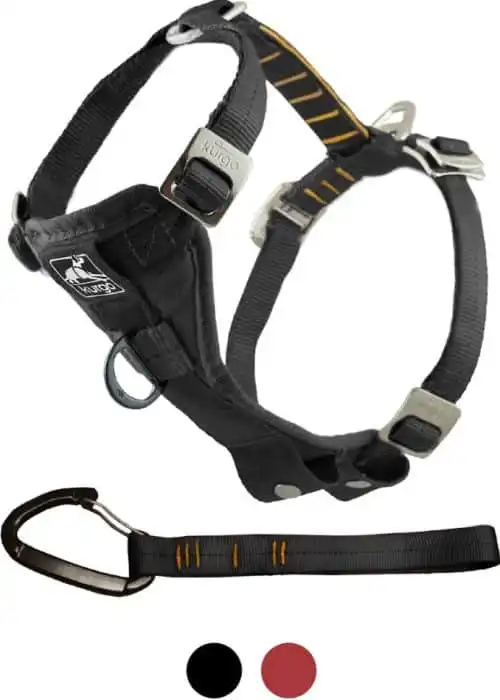
A lightweight, durable dog car harness that makes it easy to hook your dog to a seatbelt when it's road trip time.
About : Kurgo is a pretty well-known dog-gear manufacturer, who makes a ton of different dog-care items. But one of the things they’re best known for are their harnesses. So, it shouldn’t come as a surprise that they make one specifically for car use.
Known as the Tru-Fit Enhanced Strength Dog Harness , this piece of safety equipment will help your dog remain safe during car rides, and it doubles as an everyday walking harness too!
Crash-tested at Calspan Corporation , the Tru-Fit is super easy to use.
Simply hook one end of the included seatbelt attachment strap to the harness and the other to one of your car’s seatbelts — voila! Spot is safe and ready to ride!
- Crash-tested for dogs weighing up to 75 pounds
- Like all Kurgo products, the Tru-Fit is backed by the manufacturer’s lifetime warranty
- Available in 5 sizes and 2 colors
Crash Testing Info : Passed tests conducted by the Calspan Corporation .
Connection Method : You’ll put the harness on your dog and then use the included carabiner to clip your dog to both the waist and chest straps of the seatbelt.
- This car harness has better owner reviews than any other we’ve encountered
- Lightweight design will be more comfortable for some canines
- Extremely affordable
- We love Kurgo’s lifetime warranty policy
- As with the EzyDog, we wish this were tested by the Center for Pet Safety
- There’s no real padding involved
Our staff dog behaviorist and van-life enthusiast Kayla Fratt uses the Kurgo harness when traveling across North America in her Sprinter van!
Check out Kayla’s full list of 31 tips for van life with a dog if you too have the #vanlife bug!
5. Sleepypod Clickit Terrain Safety Harness

A great option for dogs who hate putting on their harness -- this one will keep your doggo safe in the car AND while walking.
About : The Terrain Safety Harness is another high-end car harness made by Sleepypod.
Built with all of the high-end features you’d want in a safety harness; the Terrain helps keep your dog secure and comfortable while riding in the backseat of your car.
It even features shock-absorbing “sleeves” to help reduce the strain on your dog’s body during sudden braking or collisions.
However, the Terrain Safety Harness is also designed (and strength-tested) to work as an everyday walking harness too.
- Three-point restraint securely grips your dog’s torso
- Shock-absorbing webbing sleeves reduce the chances your dog will suffer an injury
- Available in 4 sizes, including small, medium, large, and extra-large
Connection Method : Like the Clickit Sport, the Clickit Terrain is a one-piece safety harness. You’ll put the main part of the harness on your doggo and then slide your car’s seatbelt strap through the harness’s included Infinity Loop system.
- We love the padded, shock-absorbing design
- Quick-release connectors offer additional convenience
- The ability to use it as a walking harness will be a game-changer for some owners
- It doesn’t appear to work well with greyhounds or other long-and-lean breeds
- Using it for walks and car rides means it’ll wear out more quickly than car-only options
Crash-Testing Car Harnesses: Fact and Fiction

Unfortunately, a lot of car harness manufacturers use deceptive marketing practices when advertising their products. This can lull you into a false sense of security and give you the impression that your dog is safer than you think she is.
For example, many manufacturers label their harnesses as having been crash tested. However, this does not mean they passed such tests – only that they were put through the testing procedure.
Instead, you’ll want to find a harness that specifically is labeled as having passed crash test studies.
Other manufacturers may get their harness to pass a crash test, but the test was performed by their own employees or a subsidiary – hardly a way to get non-biased results. These types of studies are rarely published in detail, so it is impossible to determine if they were valid studies or not.
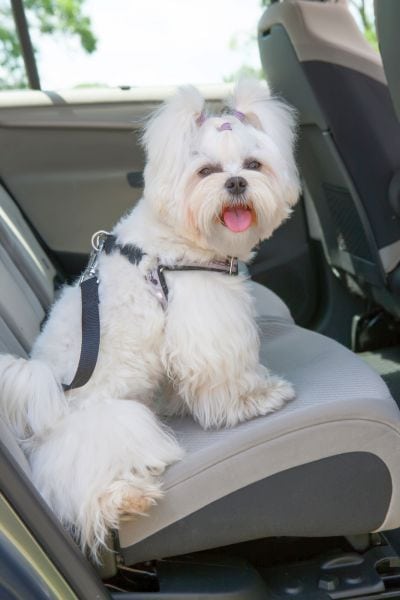
Instead, you want a harness that has been tested by a third-party group, and has passed the test – hopefully with flying colors.
Fortunately, the Center for Pet Safety (CPS) conducts exactly these types of tests and publishes their testing protocols and results so that pet owners can make informed choices.
Currently, there are only three car harnesses that have been crash test certified by the CPS .
However, we’ve also found two other harnesses that have been put through testing protocols we’re at least partially comfortable with. Neither was tested by the CPS, but we believe they still warrant inclusion .
One manufacturer had a university conduct the tests, and we’d generally consider it a safe option. The other only utilized their own testing protocol, so we’re a little less confident about that one. However, budget-limited owners may not have many other options, so we’ve included it anyway .
After all, just about any dog harness for car travel is better than no harness for car travel .
We certainly hold those that’ve been through CPS’s testing protocol to the others, but we wanted to be able to share several options with our readers. It is up to individual pet owners to weigh the various crash-testing procedures employed and make the best possible decision on behalf of their pets.
Things to Look for in a Good Car Harness
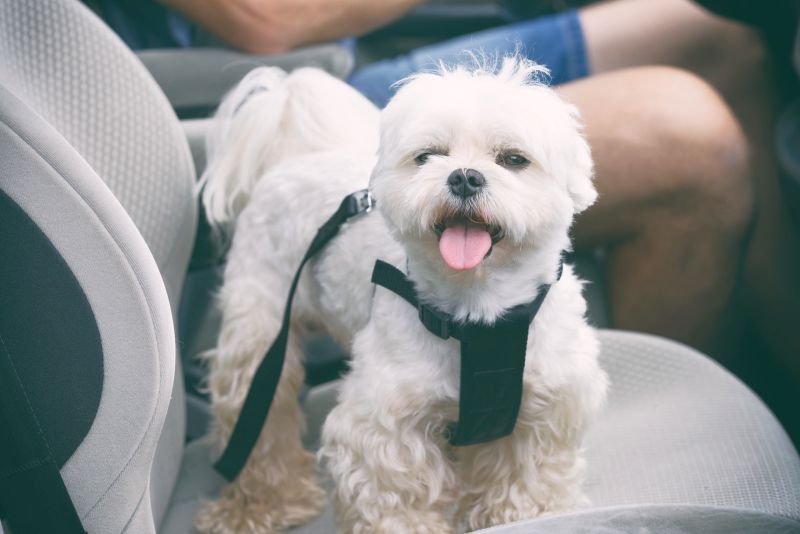
Aside from selecting a harness that’s been crash-test certified by the CPS, you’ll want to look for one that satisfies a few additional characteristics and features. Some of the most important considerations include:
- Look for harnesses that are easy to adjust . A proper fit is imperative for safety, so you want to select a harness that provides several different places for adjustment. This will help ensure your dog fits well in the harness, no matter her size and shape. This is especially important for thin, lanky breeds, such as greyhounds and a few others.
- Look for harnesses that have dual functionality . Some of the best car harnesses are easy to take out of the car, allowing them to be used as a normal harness. This makes it much easier to get your dog strapped in, especially if you must let her hop in and out several times over the course of a single trip.
- Look for harnesses that have comfortable, wide straps . Although safety (and passing common safety standards) is the most important aspect of a car harness, you’ll also want to make sure it fits your dog comfortably and doesn’t cause discomfort. Wide straps help spread out the forces on your dog and provide a much more comfortable fit than narrow straps do.
- Look for harnesses that are available in the appropriate sizes . Unfortunately, some of the best car harnesses for dogs are only made in sizes suitable for small dogs. Big dogs are at just as much risk of injury during an accident (and, as explained previously, they represent more of a danger to you), so a good harness is just as important for them as it is their smaller counterparts.
Understanding the Danger For Dogs in Cars
Driving or riding in a car is a dangerous practice in any situation, and it is probably the most dangerous activity in which most people engage on a regular basis. But adding a furry four-footer to the mix makes you more likely to have an accident, primarily because dogs have a tendency to distract drivers .
In fact, 65% of drivers in one survey , who bring their dogs along in the car admit to engaging in at least one potentially distracting activity – and that’s only the ones who admit it! Many others probably become distracted without having the courage to admit it.
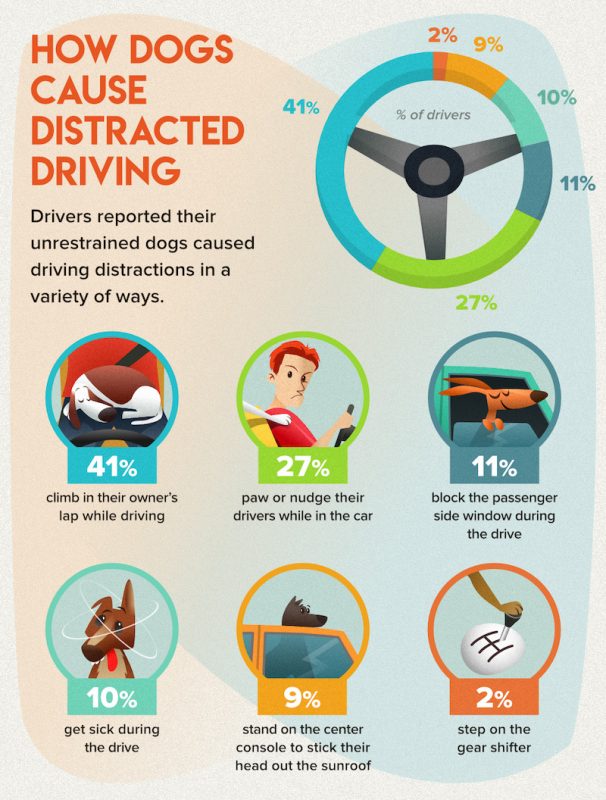
These types of distractions can occur if your dog simply moves around while the car is in motion, or if you pet her or give her a treat. And because taking your eyes off the road for as little as two seconds doubles your risk for having an accident , this is a serious problem, which must be avoided as much as is possible.
But dogs aren’t just a distraction that increases the chances that you’ll have an accident – they can also cause additional damage and injuries if you are in a fender bender. That’s because unrestrained dogs may fly through the cab of your car or truck if you are in a wreck.
In a best-case scenario, your dog will only slam into you and give you a few bruises; but in a worst-case scenario, your dog may crash into you with enough force to cause serious bodily harm. Even a 10-pound dog will create 500 pounds of force in a 50-mile-per-hour accident. Big dogs are even more dangerous: An 80-pound dog in a 30-mile-per-hour crash can impart 2,400 pounds of force.
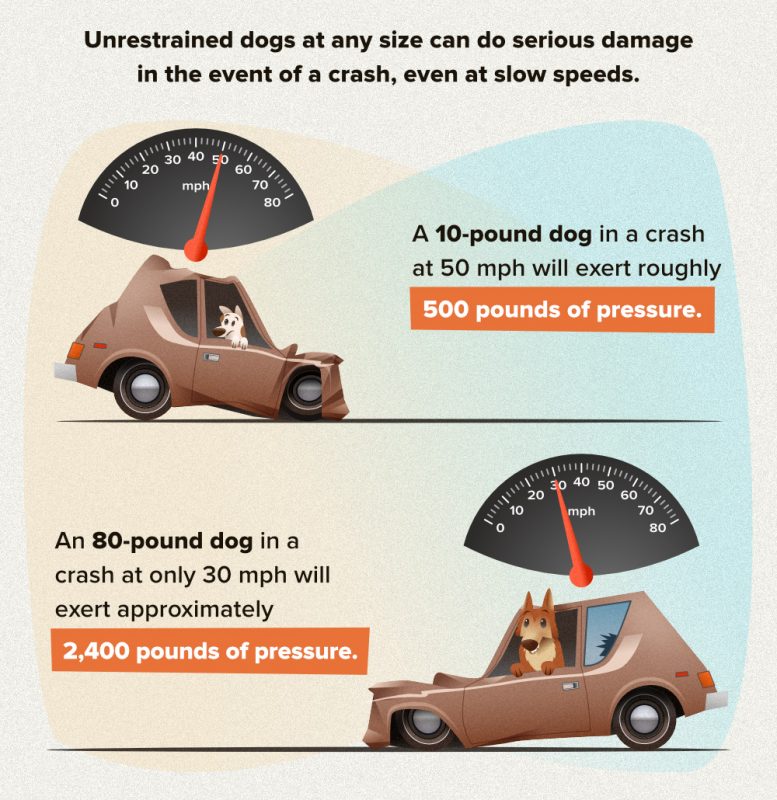
These types of forces can certainly injure you, and they’ll likely hurt your dog badly too. But, it is also possible that your dog will hit a window instead of you. This could effectively launch them from the vehicle, which will certainly lead to catastrophic injuries.
It’s the Law (in Some Places): Buckle Your Dog Up!
In some states it’s actually against the law to have an unrestrained dog in your car.
States that have laws stating that your dog must wear a canine-specific restraint in a vehicle include:
- Massachusetts
- New Hampshire
- Rhode Island
- Connecticut
Hawaii actually forbids drivers from having a dog on their lap. Several other states have regulations regarding unrestrained pets in truck beds.
Just be sure to investigate the laws in your state, as some may require (for example) that dogs wear harnesses that use leash attachments to connect directly to the car’s seatbelts, while others may require you to use crates.
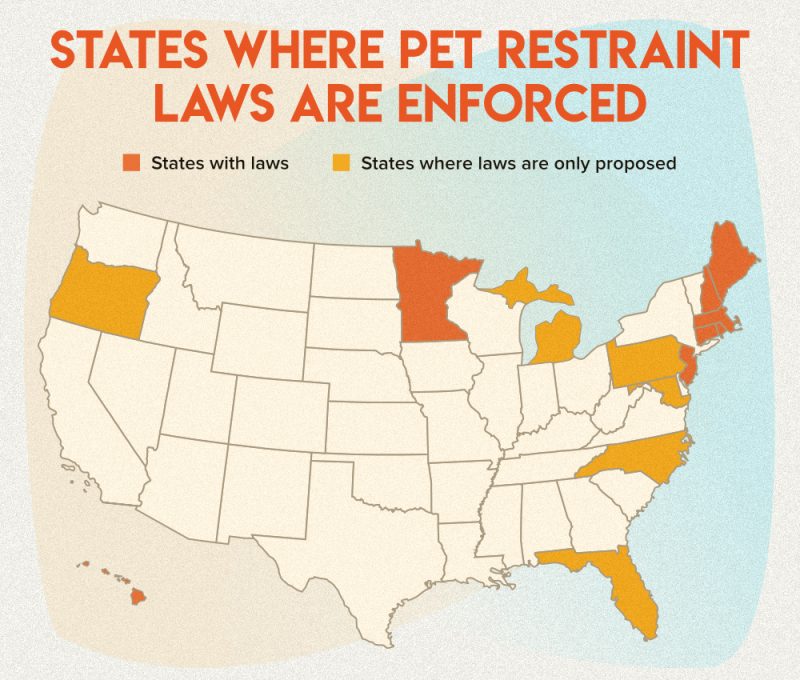
Where Should Your Dog Ride In The Car?
In many ways, you’ll want to treat your dog like you would a baby or small child. This means not only using an appropriate harness but also making sure that they ride in the safest part of the car.
Generally, this means the back seat.
The back seat of a car provides the most protection for your dog, as she’ll be contained between and shielded by both rows of seats . Additionally, by being secured in the back seat, you can prevent your dog from crawling around the cab and distracting you.
For dogs who get car anxiety , this back seat also tends to induce less stress; it allows your pup to be positioned fairly close and allow her to see you, which can be a lot less stressful than being in the back cargo area.
By contrast, the rear cargo portion of most SUVs is a crumple zone , which is specifically designed to deform in the case of an accident. This makes the cargo area a very bad place to allow your dog to ride. The front seat is also problematic, as your dog is not shielded from the windshield, and airbags can often injure dogs when they deploy – especially small dogs.
So, be sure to strap your dog in with a good harness, and have her ride in the backseat to keep you both as safe as possible.
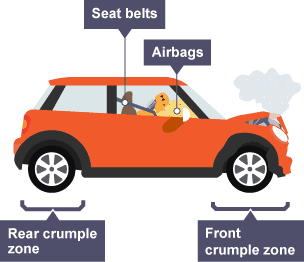
Whether You Use a Harness, Crate, or Some Other Kind of Restraint, Secure Your Dog!
Restraint harnesses aren’t the only methods for securing your dog in the car. Dog hammocks, zip lines, booster seats, cage barriers, and car crates are all alternative methods for restraining your dog in the car.
However, it’s worth noting that only harnesses and car crates have been evaluated with any kind of crash test from the Center for Pet Safety .
Other types of restraints — while still worthwhile for keeping your dog from distracting you — are unlikely to provide very much protection in the event of an accident. Nevertheless, using a zip line or one of the other alternative restraint methods is still better than using nothing.
Dog Harnesses for Car Travel: FAQ
There’s a ton to learn about car harnesses before picking one out and hitting the road. So, we’ll try to answer some of the most common questions about them to make the process easier!
How do dog car harnesses attach to your vehicle?
Car harnesses for dogs can be attached to cars in a couple of different ways. However, most either use the car’s seatbelts to remain connected or they feature straps that wrap directly around the car seats.
What is the best dog harness for car travel?
Ultimately, the *best* dog harness for car travel will depend on the specific needs of you and your pet. However, we thing that the ZuGoPet Rocketeer Pack is the best overall choice. However, large dog owners will be better served by the Sleepypod Clickit Sport .
What is the safest car harness for dogs?
We think that any of the three CPS-tested car harnesses discussed above — the ZuGoPet Rocketeer Pack, the Clickit Sport, and the Clickit Terrain — would arguably qualify as the “safest” car harness.
Can I use a regular dog harness in the car?
This is a tough question to answer, given the incredible variety of dog harnesses on the market. Many will keep your pet safer than wearing no harness at all, but some may actually put your dog at higher risk of injury or death in the event of an accident.
Accordingly, the best solution is to go with a purpose-built, crash-tested dog harness that is specifically designed for car travel.
Do you have a good car harness for your dog? We’d love to hear about the model you use and your experiences with it. We’d also love to know how strict our readers are about strapping their dog in and keeping safety in mind when riding around.
Like it? Share it!

Recommended For You
Taste of the Wild vs Blue Buffalo: A Head-to-Head Comparison
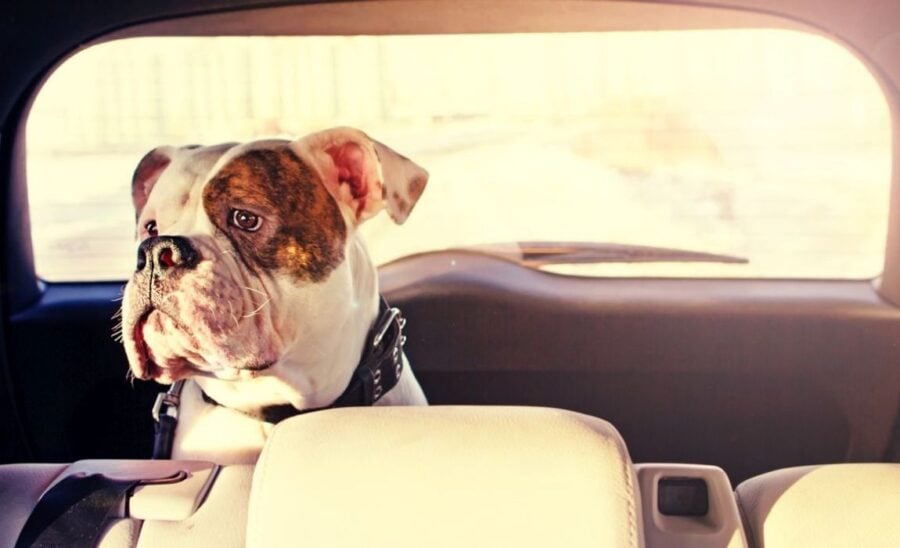
19 Ways to Cure Dog Car Anxiety
Join our pup pack!
Get tons of great dog training tutorials, canine gear guides, and the latest doggy discounts.

34 comments
Leave a comment cancel reply.
Save my name, email, and website in this browser for the next time I comment.
This site uses Akismet to reduce spam. Learn how your comment data is processed .
We just pre-ordered a new design of harness by ICOE Smart Harness. We are so excited. We’ve tried dozens of different harnesses, but none felt safe enough to use in our Jeep when the roof is off. Our dog is 136 pounds. Most of the harnesses are designed to attach to a tether. How strong is that ring on the harness? Our dog has broken many rings, they’ve just split open. I’ve seen a lot of people on Instagram showing you how to attach a tether to a collar. It is so dangerous. There seems to be a lack of education out there regarding dogs and vehicles. Thank you for this article. Very well researched. I will update my comment after we receive it and test it out.
Thanks for the kind words, Rebbeca — we’re glad you appreciated the article.
The ICOE looks pretty interesting, and I love that it has three different D rings and a handle. We can’t wait to hear how it works out for you and your pooch! 🙂
Great article you shared, Thanks for sharing such type of precious article.
EZY Drive car harness is excellent for medium to large dogs. It has been crash test approved in EU, AUS, & CN. I think it was not submitted for testing in US because it was not available at the time the product was developed. The straps are made from seat belt webbing & are continuous limiting any weak points in which contact points might become detached when under duress. This harness is better for bigger dogs as it is fairly stiff but softens up a bit with use.
Thanks for sharing, Wendy! We’ll check it out next time we update the article. 🙂
Hi Ben, I was looking at the EzyDog Drive car harness as well. It seems like it might be better than SleepyPod because it ensures sure the harness covers a large surface area and distributes the weight evenly. Although, it’s not padded.
According to Pups Pal and the Ezy Dog website, the harness was tested USA (FMVSS 213), Europe (ECE Regulation 21), Australia (ADR42/04) for certification of Child Safety Seats. It’s unclear if they “passed,” haha, but maybe you’ll have better luck than me.
https://pupspal.com/best-dog-car-harnesses/
https://store.ezydog.com/safety-tested-vehicle-harness/
I’d love to hear what you think of the harness and its certifications (or lack thereof).
Hey, John. Let me look into it and I’ll get back to you with my thoughts! Thanks for checking out the site.
You listed certain breeds that two of the harnesses do not work well for. Would this also include a Belgian malinois ?
I was hoping for a review that was not slanted toward just one product and one seller.
Not much we could do about that! There are only so many harnesses (especially crash-tested models) on the market. But thanks for checking out the site!
my dog keeps unbuckling the seatbelt. Are there safe alteratives that attach to the headrest?
Hey, Karrn. You may want to check out Kurgo’s Zipline Tether System . It may be a helpful workaround for your pooch. Best of luck!
I’ve used the Big Dog Seat Belt on my 80 lb Golden Retriever for 2 years. He runs, walks, and swims in it. I feel he is very safe riding in the front seat (air bag switched off) of my single cab truck. Very satisfied. Check it out. https://bigdogseatbeltcompany.com/
Thanks for the tip, Mike. We’ll check it out.
I have a dachshund. He is 17 lbs and very hard to find a harness that fits him well due to his girth. They are either to small or too big.
We have had excellent results with the Champion Canine Seatbelt System with our basset hounds (50-65 pounds). We have used these products for more than 10 years and have had no problems with the products and no injuries to our dogs. USA K9 Outfitters offer a number of different sizes and their system also includes straps and links to hook your canine friend into the seatbelts or other secured points. They also have an even larger size for 80 – 200 pound dogs.
http://usak9outfitters.com/CCSS.htm
I am in no way affiliated with the manufacturer or any retailer of this product.
Thanks for the info, Matt! We’ll check ’em out!
What did you do to my home state of Michigan on your map?!
It would appear that Michigan was involved in some sort of terrible Photoshop accident. We meant no offense and apologize to the entire Wolverine State. 😉
I think something that may be worthy to note; very few crash tests have actually been done. The Center for Pet Safety did this single study way back in 2013. While I don’t necessarily question the safety of the products listed, I do question the relevance of the Center for Pets Safety. In the last 6 years there have been many changes in the industry; new products have been designed and companies that failed to pass in 2013 have since made many changes and advancements. For this reason, I do not trust the results since there is no accurate comparison of products that are listed on the market today. I do not think consumers can look to the Center for Pet Safety for any up-to-date information for car safety.
I volunteer as a Pet Adviser for the Dachshund Breed Council and I am horrified that the Rocketeer is being recommended for all breeds of small dogs. Dachshunds are known to be the breed at the highest risk for intervertebral disc disease, with up to 25% affected at some point in their lives. Sitting upright like that for extended periods of time is highly likely to put significant additional pressure on their discs and increase the odds of them being affected. So whilst it might be one of the safest harnesses in a crash, the odds of such an event are way, way lower than the risk that such a harness will increase the chances of a back condition that may cause intense pain, paralysis and even death.
I have a 60 lb medical service dog who needs to be in front seat. I am looking for options for restraint device that still allows him to do his job.
Regarding greyhounds and slender breeds, the safest thing to do is use a crash tested travel crate. Crash tested products can be found here https://www.centerforpetsafety.org/cps-certified/
Hey Julie – all the harnesses we detail here are crash tested by the CPS (Center for Pet Safety), which is the group you are linking to! We only selected harnesses that were crash tested by the trusted CPS.
Good info. Only problem is I have a greyhound. Any recommendations for her- she runs between 58-60lbs.
Hey, Casey.
Unfortunately, there don’t seem to be any great options for greyhounds (and other lanky breeds) on the market at the moment. At least, none that we could find that were crash-test certified.
So, I’d recommend just going with one of the non-crash-tested options until somebody starts addressing this gap in the marketplace. Just make sure to have your pooch ride in the back seat and drive carefully in the interim.
The Pawaboo Harness looks to be pretty good for a non-crash-tested product, and there were a few photos posted by owners of skinny dogs with pseudo-greyhound builds.
Let us know how it works out! Sorry there isn’t a better option!
ZuGoPet Rocketeer Pack is not crash tested as you state in the article . Their website clearly state it isn’t a safety device, (under faq)
Hey, William. The Rocketeer Pack is crash tested — the Jetsetter (a different product) is the one that is not intended as a safety device. Kudos for looking out for your pooch though!
I ordered a Sleepypod for my small schnauzer and could not get it small enough to fit her. I ordered a small but apparently needed x-small which they don’t make. Any recommendations?
I am looking for a car harness for my daughter’s dog. Do the harnesses you recommend allow him to sit up and lay down while traveling?
Looked at a lot of harnesses. Which one would be best for a husky.
If you want one that will actually keep your dog safe in the car, it really has to be one of the harnesses listed here. If you’re just looking for walking harness, that’s a different situation (and we’d probably say go with something from Ruffwear).
Thanks for the good info. If you make another video though, please be sure the background music is off d/t it is very distracting and makes it hard to hear you.
I have the Zugopet, And We love it!
Also Worth Your Time
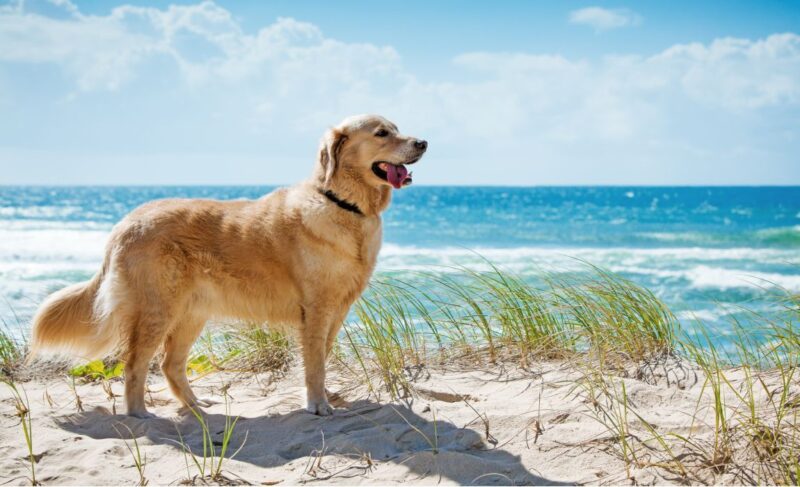
The Best Dog-Friendly Beaches in Florida: Sand, Sun, & Spot!
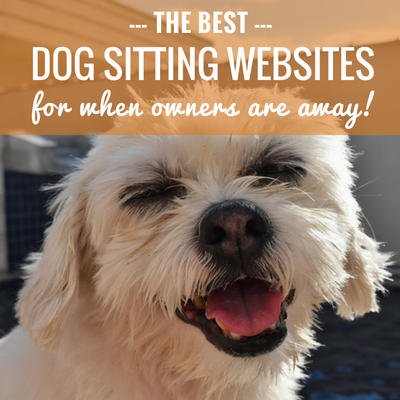
Best Dog Sitting Sites For Traveling Fur Parents!
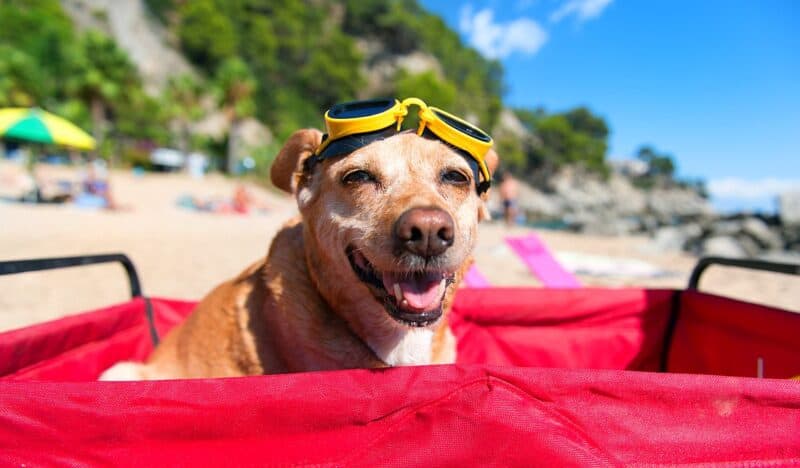
Dog Care Pet Travel
Best Dog-Friendly Vacation Destinations: 37 Pawesome Places
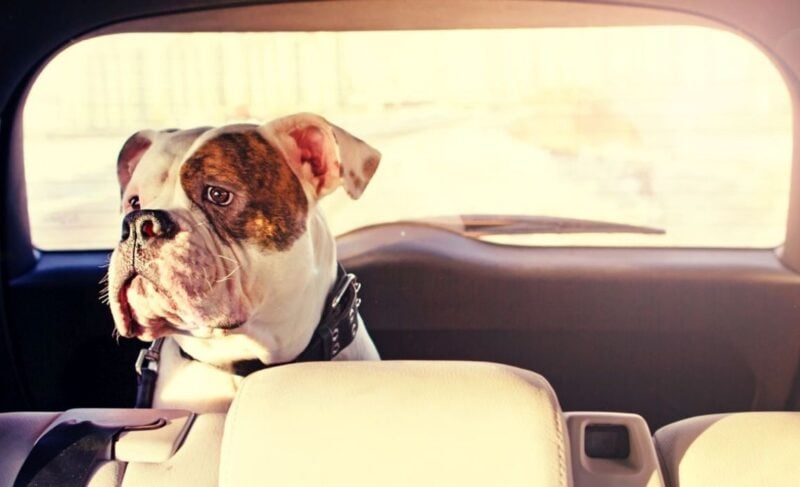
Waggle RV & Car Temperature Monitor for Pets: Our Hands-On Review
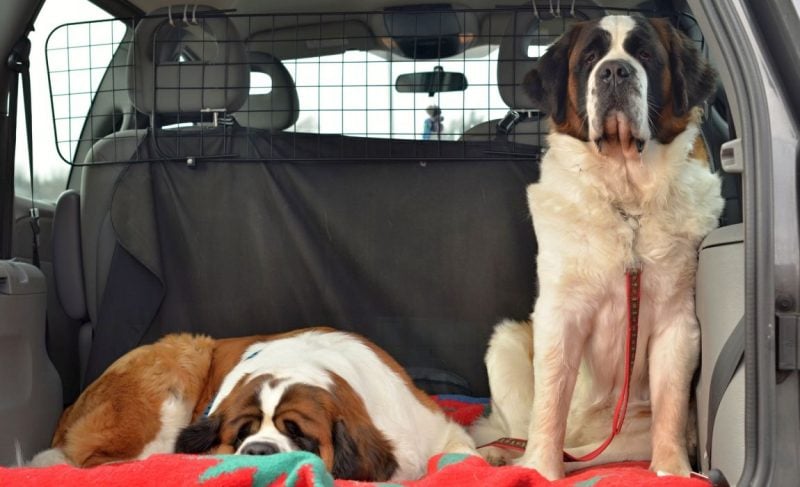
12 Best Dog Car Barriers: Keeping Pups in the Back Seat!
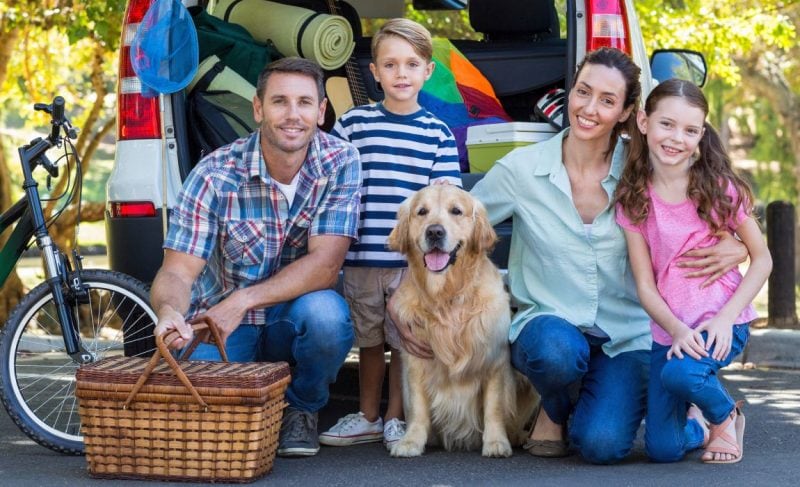
How to Road Trip with a Dog: Tips for Safety & Success!
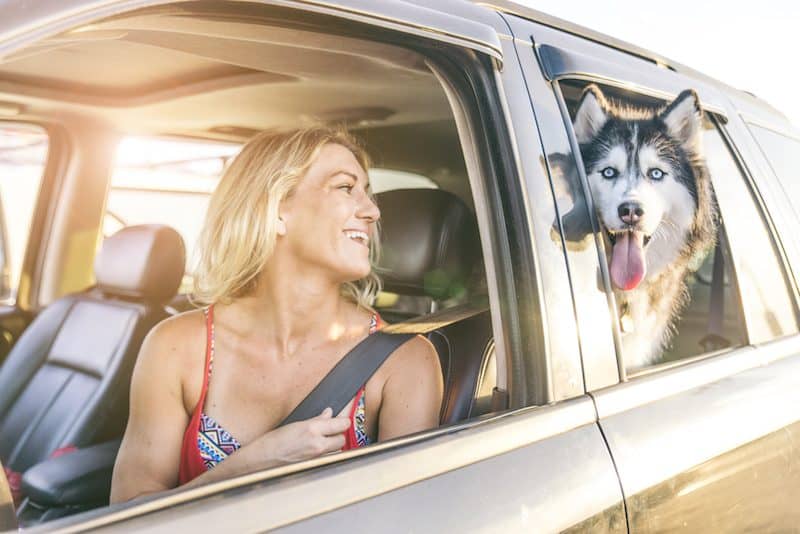
How to Keep Your Dog Cool in the Car During the Summer!

+1 (512) 720-6136
[email protected]
Marrsipan Media LLC 5900 Balcones Drive #17677 Austin, TX 78731, USA
© Copyright 2024 by K9 Of Mine / Marrsipan Media LLC
USEFUL LINKS
About K9 of Mine
Privacy Policy
Terms of Use
K9ofMine.com is a participant in the Amazon Services LLC Associates Program, an affiliate advertising program designed to provide a means for sites to earn advertising fees by advertising and linking to Amazon.com. Additionally, K9ofMine.com participates in various other affiliate programs, and we sometimes get a commission through purchases made through our links.
K9ofMine.com does not intend to provide veterinary advice. While we provide information resourced and canine education, the content here is not a substitute for veterinary guidance.
When you use links on our website, we may earn a fee.
Best Dog Crates for Car Travel of 2024
Taking your pup on a road trip can be a fun experience but only if you have one of the safest dog crates for car travel. Even if you’re not traveling cross-country, a crash-tested carrier is one of the most important purchases to keep them safe for long-haul car trips and even a quick jaunt to the vet.
We selected crates and carriers that are crash-tested and certified by the Center for Pet Safety (CPS), a nonprofit that evaluates the safety of pet travel products. To aid in our selection, we also enlisted the guidance of a dog trainer who helped inform us about the importance of pet safety when traveling in a vehicle. Our list of the best dog crates for car travel has something to make every dog’s next road trip a success.
Table of Contents
- Best Dog Crates for Car Travel
- Things To Consider When Buying
- How We Chose
Gunner G1 Kennel »

Crash-tested and certified by CPS
Double-walled
Available in four sizes
Proven to protect pets in serious accidents
Tie-down straps sold separately
Not chew-proof
When traveling with your pet, keeping them safe in the car is the biggest priority. While there are plenty of travel crates on the market, the most effective are crash-tested and certified by CPS. This nonprofit evaluates the safety claims of pet travel products. Passing crash tests is no small feat, and only a handful of products receive the CPS’s seal of approval. One of those products is the Gunner G1 Kennel.
Available in four sizes – though the large size hasn’t been tested and certified by CPS – for puppies to large breeds, the Gunner G1 Kennel has a double-walled design to keep pets safe in an accident. Its double walls also have the added benefit of providing temperature regulation, keeping your pup cool even in hot weather. The crate has built-in pins for tie-down straps to secure the crate in a vehicle, although customers must purchase the straps separately.
Crash-test certification is an excellent feature and something pet parents should prioritize when searching for a travel crate. However, it does come at a cost. The Gunner G1 Kennel is on the higher end of travel crates and one of the most expensive options. Aside from its cost, some users take issue with the crate’s weight, which ranges from 27 pounds for the small kennel to 72 pounds for the large kennel. Sturdiness and durability are important in a travel crate, so we don’t necessarily consider this to be a con. However, a heavy crate can be an inconvenience.
Sleepypod Atom »

More affordable option
Features top and side entries
Available in six colors
Not as much ventilation
Only suitable for pets up to 12 pounds
A budget dog crate for car travel is hard to come by, especially if you’re looking for a crash-tested and certified model, but the Sleepypod Atom is one of the safest options that doesn’t cost a few hundred dollars. This carrier features comfortable bedding for your pet to relax in, is suitable for the back seat of a car, and fits under the seats of most airplanes. The Atom also sports top and side entry points to make getting in and out a breeze for your pet. Plus, like all Sleepypod carriers, the Atom is available in various colors.
A downside of this crate is that it isn’t suitable for larger pets. With a weight limit of 12 pounds, only toy breeds can take advantage of this carrier. However, that doesn’t mean you can’t find a great car restraint for larger pets with a smaller budget. Sleepypod also makes one of the best car seat belts to keep large dogs safe and comfortable in a vehicle.
Sleepypod Mini »

Suitable for puppies and kittens up to 7 pounds
Doubles as a bed
Can fit under airplane seat
Available in nine colors
Some users had sizing issues
Zipper that connects cover to bed can be flimsy
The correct size of travel crate is essential for keeping your pet safe during transit, says Nicole Ellis, a professional dog trainer and pet lifestyle expert for rover.com. When traveling, a dog should touch three of the four walls of the crate or carrier to minimize the chance of movement during a collision. Getting a tiny crate that fits a puppy properly can be challenging, but the Sleepypod Mini is ideal for pint-sized pups with a weight capacity of 7 pounds. Beyond being crash-tested and certified by the CPS, this carrier can be used with cats and allows you to carry your furry friend with you on an airplane. (However, always check individual airline recommendations before flying with your pet.)
Regardless of how you’re traveling, this carrier will keep your pet cozy, comfortable, and safe. The included bed can be used as your pup’s primary sleeping place when not jet-setting around the world, which may help acclimate your puppy to being contained in a small carrier during travel times.
While the Sleepypod Mini suits most teacup pups, some users struggled to get the correct fit, as Sleepypod also makes the Mobile Pet Bed, a medium-sized equivalent of the Mini. We recommend measuring before purchasing to ensure you get the right fit for your four-legged friend.
Away The Pet Carrier »

Compact but safe for smaller pups
Clip to secure your pet within carrier
Airline-approved
Removable bedding
Only suitable for pets up to 18 pounds
Not as soft as some soft-sided carriers
Small breeds can be easier to travel with because they don’t take up as much space, but the travel is only simple if you have the right gear. The Pet Carrier by luggage brand Away is the ideal soft-sided crate for transporting small dogs in a car. Its features include top and side entry points for your animal, removable bedding for comfort, a retractable mesh privacy screen, and a collar clip to keep your pup from springing out of the carrier when opened. It also has a firm bottom, which stops the carrier from folding during transit – a feature Ellis says is important to prevent your dog from sliding around in the crate.
Car travel is a breeze with this carrier: Just secure it to your vehicle’s back seat via a belt around the headrest. Traveling by air with your pet? This carrier can sit snugly on top of your luggage , securing to the handle of any Away suitcase via a trolley sleeve. (For travelers who do take their pups on planes, note that while the material is soft, some users found it wasn't flexible enough to fit under every airline seat.) The downside of this carrier is that it’s only suitable for small breeds weighing less than 18 pounds, so medium and large pets are out of luck.
Lucky Duck Lucky Kennel »

Suitable for pets up to 110 pounds (large size)
Drainage holes for easy cleanup
Lightweight
Bed pad sold separately
Finding a dog crate for car travel that suits big breeds can be tough, but Lucky Duck makes one of our favorite kennels ideal for medium to large dogs. With a capacity to hold pups as big as 110 pounds, the large version of the Lucky Kennel can keep up with large dogs without weighing you down. Unlike most crash-tested travel crates, this kennel is lightweight at only 45 pounds, making it much more accessible to lift in and out of a vehicle. Another nice feature is its drainage and ventilation holes. The drainage holes are excellent to have in the event of a potty accident, as any liquid in the kennel is directed to the drainage holes via the slightly pitched floor of the crate .
The drain holes are a nice plus, but they make it difficult to place a bed within the crate. As such, Lucky Dog offers its own bed to fit inside – a nice-to-have feature to ensure your pup’s comfort during travel. However, if you want to purchase the bed pad for your dog, you’ll have to do so separately. Lucky Dog also requires the separate purchase of ratchet straps – a type of restraint that keeps the crate tied down to a vehicle – instead of providing them with the kennel. Remember this when purchasing this crate because Lucky Dog kennels are only crash-tested and certified by the CPS in combination with these tie-down straps.
Paravel Cabana Pet Carrier »

Smaller footprint than most carriers
Folds flat for easy storage
Made from recycled materials
Only fits pets up to 20 pounds
Some users found shoulder strap held up poorly
The best dog carriers for small cars won’t take up too much space in the back seat of a vehicle, and the Paravel Cabana Pet Carrier fits the bill. At just 11 inches long, this soft-sided carrier can easily fit within the back seat of any small car. It’s also less than 1 foot high, easily letting you see over the top of the carrier. However, the small footprint won’t squeeze your pet.
The Cabana Pet Carrier is more than 20 inches wide, which makes it easily able to hold pups up to 20 pounds. Another handy space-saving element of this carrier is its ability to fold completely flat so that when your pet isn’t in the vehicle with you, the back seat can be reclaimed for passengers or cargo.
While this crash-tested and certified carrier is a safe, space-saving option for small cars, a few users found it wasn’t the best option as a shoulder bag, as the shoulder strap broke for some buyers.
Cabela's GunDog Intermediate Dog Kennel »

Tie-down strap kit and safety bar included
Nonslip rubber feet
Only one size
No included crate pad
When using a crash-tested crate in a large vehicle such as an SUV, it’s important to tie it down using straps or bolts to ensure the kennel doesn’t shift during transit. However, most crate manufacturers don’t include these tie-down straps with the purchase of a kennel, and these can often pack on an additional hundred dollars to an already expensive purchase. The Cabela’s GunDog Intermediate Dog Kennel is an excellent option for those who want the tie-down straps included to keep their pup safe in the back seat or trunk of an extra-large vehicle. The included tie-down strap kit can secure this crash-tested crate to most large cars, and the rubber feet offer additional nonslip reinforcement for more stability.
The kennel allows users to choose on which side they want the door to open – a handy feature to ensure ease of use. The downside of this crate is that it’s only available in one size, leaving few options for dogs between a medium and large size. It also comes as is, meaning no crate pad or bedding is included for your pup.
The Bottom Line
Choosing the best dog crate for car travel is a weighty decision, and you should always keep your pet’s safety top of mind. The good news is there are many excellent crates and carriers available that are crash-tested and certified, providing your pup with a safe and comfortable place during a road trip.
Our best overall pick is the Gunner G1 Kennel, which has some of the best features we’ve seen on a travel crate. Its double-walled design reinforces the kennel's safety while keeping your dog cool on hot days. It also has one of the most diverse size ranges available for crash-tested crates, making it suitable for small pups and large breeds alike.
Things To Consider When Buying Dog Crates for Car Travel
Safety Certifications: The best dog crates for car travel are crash-tested by the CPS. The pet industry has few regulations for travel products, and some brands may make unjustified safety claims. Even with products certified by the CPS, remember that certifications vary, and a product may not be approved for use with dogs weighing more than a certain amount or without additions such as tie-down straps.
Size and Weight Capacity: Choosing the correct size kennel is vital for keeping your dog safe during travel, whether traveling with your pet in a car or on a plane. There’s no one-size-fits-all crate, so remember to measure your pet and follow the measurement and weight guidelines provided by the manufacturer to achieve a good fit.
Ellis says that while we might have an instinct to buy a bigger crate to give our pups more space to lounge, it’s important to hold off on this impulse. “[O]ur dogs should be snug. So when thinking of a [crash-tested crate], our dog should really be touching three of the four walls [when they] lay down,” she says. Ellis also encourages pet parents to avoid extra space within a crate because that’s where the dog will move during a collision.
Material: Each dog kennel is constructed differently, but there are some materials to look for when considering dog crates for travel. Ellis likes soft-sided carriers with a firm bottom that ensures a pet stays stable during transport. She also says that ballistic nylon – a material that’s resistant to water and chew damage – is great.
Hard crates tend to be made of materials like rubber or rotomolded walls. Rotomolding is a type of plastic construction, and its benefits include being durable and thick enough to withstand excessive force, such as the type that would be exerted in a car accident.
While crash-tested crates vary in material, Ellis notes that one material pet parents should avoid is wire, specifically in wire-style crates. These crates are acceptable for at-home use but not for travel. Ellis says a wire crate may break into small pieces and impale your pet in the event of a collision.
Vehicle Compatibility: Most crash-tested crates suitable for car travel can be used in any vehicle. However, measure the back seat of your car to ensure that the crate will fit. Some crates intended for larger dogs may not fit in the back seat as easily as smaller soft-sided carriers. These crates may instead be used in the trunk of a vehicle, although they usually require tie-down straps to keep them in place. Ellis says it’s important to check your specific vehicle’s attachment points if you opt for a crate that requires latching in that way.
It’s also vital to remember that while a crate may sit in a vehicle's back seat, trunk, or bed, it should never be placed in the front seat. Ellis says regardless of what crate or carrier your pup is in, your dog can still be injured by an airbag if traveling in the front seat of a car.
How We Chose the Best Dog Dog Crates for Car Travel
At U.S News 360 Reviews, our editors and contributing writers evaluate products based on research, expert guidance, and our own experience as professional product reviewers. Our contributing writer consulted the CPS’s list of crash-tested and certified dog crates and carriers to find the best options for dogs big and small. We also consulted Nicole Ellis , a certified professional dog trainer and pet lifestyle expert with rover.com to understand how to keep pets safe during car travel.
WHY SHOULD YOU TRUST US?
Sophia Carlisle , the author of this piece, has covered pet products for Business Insider as a fellow and, prior to that, fostered dogs and cats for years. She has tested dozens of dog products with her rescue pit mix Lyla, including harnesses, food, and leashes. For U.S. News 360 Reviews, Sophia has covered some of the best products for pups, such as the best dog harnesses and slow feeder dog bowls .
The most important safety feature of a dog crate for car travel is that it’s crash-tested and certified by the Center for Pet Safety (CPS). Other safety features to watch for include crates and carriers with tie-down straps. Some crates for large dogs are only certified by the CPS with tie-down straps, which help to keep a large crate stable during transit.
Regardless of which CPS-certified crate you choose, Ellis, a certified professional dog trainer, says it’s always essential to restrain your pet in a vehicle. Even the most well-trained dog can cause a distraction, leap out of an open window, or become a projectile in the event of an accident, so keeping them secure during travel is necessary.
If a crate or carrier passes crash safety standards set by the Center for Pet Safety (CPS), it receives a rating between 1 Star and 5 Star. The very best dog crates for car travel receive a 5 Star safety rating.
If a brand or product claims to be certified by the CPS, check directly on the website to ensure it has passed crash testing. Some products have undergone crash testing but have failed or had their certification revoked. If a crate or carrier isn’t crash-test certified by the CPS, it’s unsafe to use with your pet for car travel.
Finding the correct size crate for your dog can be tricky, so take careful measurements of your pup and compare them with the weight and length measurements provided by the brand. Ellis, a pet lifestyle expert with rover.com, says that dogs should fit snugly inside their crates, so avoid opting for a larger size than your dog needs.
Compatibility with your vehicle is also important to consider when selecting the best travel crate for your pup. Ellis says it’s best to place the crate in the trunk or back seat of the car. Ensure you check whether or not the crate requires tie-down straps and if those straps can be attached to the latch points in your vehicle.
About Our Team

Sophia Carlisle
Contributor

Kayla Randolph
Associate Editor
U.S. News 360 Reviews takes an unbiased approach to our recommendations. When you use our links to buy products, we may earn a commission but that in no way affects our editorial independence.
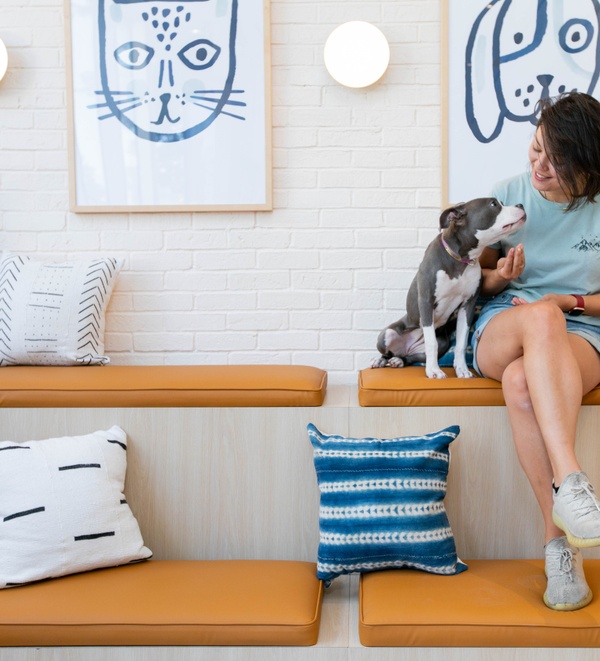
Dog Travel Anxiety: Prevention, Treatment, and More
Whether you’re planning a long road trip with your favorite pup, or simply trying to get them to the dog park, a car ride can be very stressful for both of you if your dog experiences car anxiety.
Travel-related anxiety can happen for a variety of reasons, including fear of the car, fear of an unfamiliar situation, or simply discomfort from motion sickness. Here are some important things to know about recognizing travel anxiety in dogs and how to help your pup…
What is Dog Car Anxiety?
Dog car anxiety, or travel anxiety, is exactly what it sounds like — anxiety, stress, or fear that occurs due to being in a moving vehicle.
This could mean mild discomfort to full-blown panic, or any degree of stress between these two extremes. In addition to the mental and emotional consequences to a dog, an anxious dog can also be a dangerous distraction to the human driver.
What Causes Car Anxiety in Dogs?
For a number of reasons, a dog may associate a car with something bad happening.
For example, if the dog was abandoned, they may associate the car ride with going to the shelter and being left behind.
Or, imagine if a dog only goes on car rides to the vet’s office (or the groomer’s or a boarding facility, or anywhere else they’re not super excited to go). In the dog’s mind, every time they get inside the car, they think they’re heading somewhere that’s not very fun.
Sometimes, there’s no specific “cause” or event that happened to make a dog afraid of the car. Instead, some dogs just find the car to be a scary or uncomfortable place.
Think about it from the dog’s perspective. Their footing is unstable due to the car’s movement, and they may lose their balance and fall if the car makes a sudden stop or turn. There may be scary noises or an overwhelming amount of stimuli.
Also, some dogs (especially puppies) get car sick, which can make riding in the car very unpleasant, even if they otherwise enjoy ventures outside the home.
So, while plenty of dogs love being in the car, it’s natural and not unusual at all for others to dislike the experience.
Common Symptoms of Travel Anxiety in Dogs
Some of the most common signs of dog anxiety in a car include…
- Reluctance to get into the car.
- Whining, panting, or barking.
- Pacing or acting restless.
- Excessive drooling.
- Lip licking or lip smacking.
- Shaking or trembling.
Some of these symptoms can also be caused by motion sickness. A dog who is car sick might vomit, too, or they may just show more subtle symptoms of distress.
Need a vet? Book a visit .
How to Prevent Car Anxiety
As with many things in life, prevention is the best medicine when it comes to car anxiety. If your dog is new to car rides, smart training strategies can help them learn to view the car as a fun (or at least neutral) place — so that travel anxiety never develops in the first place.
The main strategies used by behaviorists to get a dog used to the car include desensitization and counterconditioning, which are both types of healthy training techniques that avoid any type of punishment and help a dog feel safe.
Desensitization Helps a Dog Used to the Car Gradually
Trying to get a dog comfortable with the car with full-length drives can be a little like learning to swim by jumping into the deep end of a pool—it can be overwhelming.
A more comfortable strategy involves slowly introducing a dog to car rides — starting with the car parked and turned off.
Some pet parents start by playing with their dog — or giving them attention or delicious treats — near the parked car. Then, they will invite the dog to sit with them inside the car, while continuing to offer praise and treats. Initially, the doors of the car should be left open, so the dog doesn’t feel trapped.
Next, the positive time together can be repeated with the car door closed. Then, with the engine briefly turned on, then turned off again.
After that, short trips can be added — for example, starting with just a drive up the driveway or around the parking lot and back. Then, gradually increase the length of the drives.
Throughout each step of the desensitization process, give your dog praise, attention, treats, or playtime — or a combination of all of these, depending on what motivates your pup and helps make the experience a positive one.
If your dog ever reacts fearfully, that means the process is moving too fast for them. Go back to the previous step and try again.
Does this process sound slow? You’re right, it can require a lot of patience. For some dogs, the process can take weeks or even months. But it can make car rides much better for both you and your pooch in the long-term.
Counter-conditioning Teaches a Dog that the Car Is a Fun Place
Counter-conditioning is the term for training a dog to form a positive association to something — in this case, car rides.
This process was already partly covered in the above section on desensitization. When you offer your dog praise, quality time together, playtime, treats, or other positive reinforcement, that is helping to teach them that the car is a place where good things happen.
You can add additional counterconditioning benefits by driving your dog to fun places, once they’re ready for full-length car rides. For example, take them to a dog park, nature walk, or other location they would enjoy.
If possible, recruit a travel buddy who can sit with your dog and give them love and attention while you’re driving.
That way, your pup will associate the car with fun places, rather than just the vet’s office or groomer’s.
At What Age Can a Dog Begin Training for Car Rides?
Puppyhood is a great time to begin desensitization and counterconditioning, especially when it’s time for a puppy to begin socialization. But adult dogs can also learn to enjoy (or at least tolerate) car rides using this same process. It may just take a little longer.
For puppies, check with your vet as to when it is safe to begin socializing them or taking them to locations such as dog parks. Puppies are more prone to infectious diseases, which can be very dangerous, so it’s important to avoid exposing them to potential risks too soon.
One additional note on puppies: Since their inner ears are not yet fully developed, motion sickness is very common. Many will outgrow this issue, but it can initially create a negative association with the car. If your puppy has car sickness, talk to your vet team about the best time to begin longer car rides.
How to Help Your Dog with Travel Anxiety
If your dog already shows symptoms of car-related anxiety, don’t despair. There are many things you can do to help them.
The First Step Is to Get Motion Sickness Under Control
A dog’s motion sickness is often confused with travel anxiety, since both can cause symptoms such as drooling, restlessness, or other signs of distress. It’s especially common in puppies, but plenty of adult dogs get car sick, too.
Schedule a consultation with your vet to discuss your pet’s symptoms. Your vet can help determine if your pup truly has motion sickness. They can also prescribe medications to help, if needed.
Additionally, there are measures you can take that may help with mild motion-related tummy upset, including…
- Keep the car cool with the a/c or by cracking the windows.
- Create a comfy place for your dog to rest, so they aren’t looking out the windows or struggling to keep their balance.
- Limit food intake for a few hours prior to the car trip.
Many dogs experience a combination of motion sickness and travel anxiety, since nausea can make travel stressful to them. So it’s important to address motion sickness in addition to dog anxiety in cars.
Train Your Dog that the Car Is a Safe Place
Using the techniques of desensitization and counterconditioning, as described in the previous section, you can help your dog begin to see the car as a safe, or even fun, place.
While these techniques work best for dogs who don’t already have a negative association with the car, they can also be used to retrain a dog with car anxiety. It may just take a little longer.
Make the Car Ride as Comfortable as Possible
First, ensure everyone’s safety. Use a dog seatbelt or safety harness, set up a travel carrier or crate, or block off an area of the car. Not only will this prevent your dog from distracting you while you’re driving, it can also help a dog feel more secure and less likely to lose their footing, fall, or go flying forward in the event of sudden braking.
Also, consider these factors that can help your pup feel safe and comfortable…
- Place towels over the kennel or back windows to reduce overstimulation. Just make sure there is adequate airflow.
- Bring a comfort item, such as your dog’s bed or favorite toy, or an item of clothing that smells like you. Choose something washable if your pup is prone to car sickness.
- Play soft, soothing, or classical music.
- Distract your dog with a puzzle feeder filled with a special treat.
- For long car trips, bring adequate supplies (food and water) and make plenty of stops for potty breaks.
Use Non-Medical Calming Aids
The most popular options are probably a ThunderShirt and dog pheromone products.
A ThunderShirt is a snug vest made for dogs , which can provide comfort through gentle pressure.
Dog pheromones are synthetic substances that mimic calming scents that a mother dog would produce. Adaptil brand is widely available.
Consider Over-the-Counter Products and Homeopathic Remedies
Benadryl is a commonly used antihistamine that can reduce nausea from motion sickness and also make a dog feel drowsy. Another popular option is Rescue Remedy for Dogs , a homeopathic remedy that may help dogs with mild to moderate symptoms.
While these options are generally considered safe, they are not safe or appropriate for all dogs, and it’s important to give your dog the correct dose. Always check with your vet prior to giving a new medication or supplement.
Prescription Medications
Some dogs may benefit from prescription medications for anxiety or nausea. This is best determined via a consultation with your veterinarian .
For anti-anxiety medications, it’s always important to do a “trial run” prior to your road trip, since individual dogs respond differently and it may take some trial and error to choose the best medication and dose.
For your dog’s safety, always check with your vet prior to giving them any new medication.
How Your Vet Can Help
Your vet can help you create an individual success plan for taking your dog on car rides without stress or nausea. This may include training techniques, prescription or over the counter medications, general travel tips , or a combination of all of the above.
While the process of helping a dog with car anxiety may seem daunting, it helps to have a vet team that can guide you through the process and determine the best course of treatment for your individual pup.
Need help planning for your next car ride with your pup? Call us or schedule a telehealth consultation today so we can help make car travel more enjoyable, for both you and your favorite pup!
Better care, Right when you need it

Traveling With Dogs: Tricks and Tips for a Smooth Journey
B ringing your dog along for a vacation can make the experience even more enjoyable for the whole family. But before you hit the road and start traveling with dogs, it’s essential to consider the extra planning and preparation that is necessary for their health and safety during the trip.
Keep in mind, not all dogs enjoy traveling, and some may not be in the right mental or physical shape for it. It’s necessary to have a plan in place to ensure that your dog is comfortable and safe throughout the journey.
From finding the right travel crate to ensuring your dog has proper identification, to planning out your hotel stays, I’ll walk you through all the necessary steps to make your vacation with your dog a truly memorable and enjoyable one.
Schedule a Pre-Trip Vet Checkup
Before embarking on an adventure with your dog, it’s a good idea to schedule a visit to the vet to ensure that they are in good health and ready for travel.
This visit not only allows you to ensure that all vaccinations are up-to-date and that your dog is in good physical shape, and gives you an opportunity to discuss any concerns or special needs your dog may have when it comes to traveling.
For example, your dog may have a fear of flying or may have a medical condition that makes flying unsafe, so your best bet would be a road trip with your dog instead, If you are flying with your dog, the airlines will require a health inspection, generally within 10 days of travel, so make sure you time things correctly!
Your vet will be able to advise you on how to handle these situations and give you peace of mind that you and your dog are ready for the journey. They can review if anxiety medication would be a good idea for your dog if they struggle with car rides.
By having a pre-trip vet check-up, you will be able to be proactive in case your dog has any health issues that may arise during the trip. This will allow you to take action immediately, avoiding potential complications and making sure that your dog receives the best care possible.
Plan For Medical Emergencies
When traveling with your dog, be prepared for any emergency or health-related issues that may arise. First, make sure you have your pet’s medical records with you. This includes their vaccinations, medication and any other relevant information that a veterinary professional might need to know.
Have the contact information of at least one veterinarian in the area where you will be staying so you can get help quickly if needed. You can research the location of the nearest 24-hour veterinary emergency hospital at your destination and save the number in your phone or screenshot their phone number so you aren’t scrambling in an actual emergency.
Pack a doggy first aid kit that includes items such as bandages and antiseptic ointment. Bring any medications that your pet is currently taking and make sure they are properly labeled in case there are any mix-ups.
Having a plan in place is not only about being prepared for the worst-case scenario, it’s also about being able to enjoy your vacation without stressing about your dog’s well-being if they get into something they shouldn’t!
You can have peace of mind knowing that you are prepared for any situation that may arise, and you can focus on enjoying the journey with your dog. In case of an emergency, your dog will receive the best care possible, and you will be able to act quickly and efficiently thanks to the information and resources you have at hand.
Prep With The Right Travel Essentials
When traveling with your dog, bring along all the essentials to ensure their comfort and well-being during the trip. This includes bringing along a supply of their regular food, plenty of water, as well as any medications they may require.
You’ll need to consider the type of travel you will be doing and bring any necessary items such as a crate for air travel or a dog seatbelt for car travel.
Bringing along your dog’s favorite toy or their comfortable bed can help them feel more at home and reduce anxiety in unfamiliar surroundings. Bring extra poop bags for accidents and potty breaks. Traveling can be rough on all of our tummies, including our dogs, who often have no idea what’s going on!
Remember that traveling with a dog is not just about bringing the essentials, it’s also about making sure your pup is comfy and happy throughout the journey. By bringing their favorite toy or a comfortable mat, you can create a sense of familiarity and make the trip less stressful for them.
Using Crates for Safe Travel
The advantages of using a crate for travel.
When traveling with your dog, a crate can provide a number of benefits to ensure their safety and comfort. For air travel, a crate is often a mandatory requirement, and it can be used as a safe space for your dog while in a hotel or at a host’s home.
Crates can also be used during car travel, providing a safe and secure environment for your dog while in transit . After flying Roxy and Rico from Alaska to Colorado, we started taking them on tons of road trips.
Using a crate makes life easier as they’re used to them, it keeps them a bit more safe in case of an accident, and helps reduce their reactivity to situations like when our car was completely surrounded by mountain sheep at Mount Evans!
Using a crate allows you to have peace of mind knowing that your dog is safe and secure. In case of an emergency, the crate can act as a barrier and protect them from any potential hazards.
Crates provide a familiar space for your dog, reducing their anxiety and stress while traveling. It’s a place where they can retreat to and feel safe and secure. Roxy and Rico are so much calmer in their crates than when we travel without them.
Dog crates can a helpful training tool for your dog. By gradually getting them used to the crate before the trip, it can make the transition to travel smoother and less stressful for them.
How To Pick The Right Dog Crate
When selecting a crate for travel with your dog, consider certain criteria to ensure safety, comfort, and compliance with travel regulations. The crate should be large enough for your dog to stand, turn, and lie down comfortably, and be made of strong materials and free of any interior protrusions that could harm your dog.
A leak-proof bottom covered with absorbent material and ventilation on opposing sides is also important for your dog’s well-being. When we travel with Roxy and Rico, we use a crate mattress like this one for them to be comfortable.
When purchasing a crate for air travel, make sure that it complies with airline requirements to ensure that your dog can travel safely and comfortably.
Identification and Recovery Measures
Identifying your dog while traveling is essential in case they get lost or separated from you. A sturdy leash and collar with identification tags are a must-have when traveling with your dog.
The collar should have identification tags with the dog’s name, your name, and your phone number and address. Some places require a rabies tag on there as well, so be mindful of that if it’s required at your home or your destination.
Remember that collars and leashes not only serve as a means of identification but also as a means of control and safety. A sturdy leash and collar can prevent your dog from running away or getting into dangerous situations.
Practice using the leash and collar before your trip. By getting your dog used to wearing it and walking on a leash, you can make the transition to traveling smoother and less stressful for them.
By having proper identification on your dog and getting them used to their collar and leash, you can greatly increase the chances of recovery in case of separation and ensure their safety while traveling.
Permanent Identification – Microchips
While collars and leashes can provide temporary identification for your dog, permanent forms of identification can offer added peace of mind and increase the chances of recovery in case of separation.
Microchipping is a safe and permanent method of identification that involves inserting a small chip under your dog’s skin. This chip contains a unique identification number that can be scanned by veterinarians and animal shelters, making it easier to reunite lost pets with their owners.
Furthermore, microchipping is a one-time procedure that doesn’t require any maintenance and it can last the entire life of your pet. It provides a layer of protection against theft and lost as well as offering an additional way to prove ownership.
Update your contact information with the microchip registry as soon as possible after any changes in your contact information. This way, if your dog is ever lost and found, they can be quickly and easily returned to you.
By microchipping, you can greatly increase the chances of recovery in case of separation and ensure the safety of your pet.
Photo and Health Records
When traveling with your dog, it’s essential to have a recent photo of your pet and their health records on hand. A clear and current photo of your dog can greatly assist in identifying them in case they get lost or separated from you. This will help shelters and rescue organizations to identify your dog and reunite them with you as soon as possible.
Having a copy of your dog’s health records can be extremely helpful in case of an emergency. This includes vaccinations, medications, and any known health conditions. This information can be used to make sure that your dog is in compliance with any travel regulations and can provide vital information to veterinarians in case of an emergency.
Keep a copy of these records in a safe place, such as your email, a cloud-based storage, or with a trusted friend or family member, so that you have access to them even if you lose your original copies.
Our Dog Health & Wellness Journal has everything you need to keep your dog happy, healthy, and safe. It’s perfect for bringing along when you travel, so you have all your dog’s vital information handy. Grab it on Amazon here!
C. Crate Preparation
Preparing your dog’s crate for travel is just as important as selecting the right crate. By stocking the crate with familiar items such as a comfortable mat, your dog’s favorite toy, and a water bottle, you can create a sense of familiarity and comfort for your dog. This can greatly reduce their anxiety and stress while traveling.
Make sure the crate is clean and free of any debris or odors. This can help prevent any potential health issues and ensure that your dog has a clean and comfortable environment while traveling.
Get your dog used to the crate before the trip. By gradually introducing them to the crate and allowing them to explore it at their own pace, you can help them become more comfortable with it. This can make the transition to traveling smoother and less stressful for them.
Overall, by properly preparing the crate and getting your dog used to it, you can create a sense of familiarity and comfort for them during travel. This can greatly reduce their stress and anxiety, making the trip more enjoyable for everyone.
Traveling by Car
Familiarization with the car.
When it comes to traveling with your dog by car, prepare them for the experience in advance. One of the best ways to do this is by familiarizing your dog with the car. This can be done by letting them sit in the car with you without leaving the driveway, and then going for short rides.
By doing this, your dog can become accustomed to the sights, sounds, and smells of the car, reducing their stress levels when it comes time for the actual trip. This process can be beneficial for dogs with car sickness, as they can get used to the motion of the car before the longer trip.
Make sure that your dog is comfortable in the car. You can do this by providing them with a comfortable mat or blanket, and their favorite toy. This will help create a familiar and safe space for your dog and make the trip more pleasant for them.
Overall, by familiarizing your dog with the car and making sure they’re comfortable, you can greatly reduce their stress levels and make the trip more enjoyable for both you and your pup.
Carsickness Prevention
Carsickness is a common issue that can affect dogs, just as it can affect humans. It can cause them to feel nauseous and can make the car ride an unpleasant experience for both you and your dog. To prevent carsickness, take steps to make the car ride as comfortable as possible for your dog.
One way to do this is by feeding your dog a light meal before the trip, this way they will not have a full stomach and it will reduce the chances of them getting carsick. Providing plenty of fresh water for your dog during the trip will help them stay hydrated.
Make sure that the car is well-ventilated, this way your dog can breathe fresh air, which can help reduce the chances of carsickness. If your dog is traveling in a crate, make sure that the crate is well-ventilated, this way fresh air can flow in and out.
If your dog is prone to carsickness, you may want to consider consulting with your veterinarian to see if there are any medications that can help prevent carsickness.
Overall, by taking steps to prevent carsickness, you can make the car ride a more comfortable experience for your dog and ensure that both you and your dog enjoy the trip.
Keeping your dog safe while traveling by car is crucial for a successful and enjoyable trip. One of the most important things to consider is using a crate or a dog seat belt to keep your dog secure. This not only protects your dog in the event of an accident, and prevents them from distracting you while driving.
Another safety measure is to never let your dog ride with his head sticking out of an open window. This can lead to eye injuries and other accidents. Never let your dog ride in the back of an open truck. This is extremely dangerous and can lead to severe injuries or death.
Make frequent stops for exercise and potty breaks. This will not only keep your dog happy and healthy, and give you a chance to stretch your legs. Be sure to clean up after your dog and always supervise them during these breaks.
Lastly, never leave your dog unattended in a closed vehicle, particularly in the summer. The temperature inside a closed car can quickly become dangerous for your dog.
Overall, by following these safety measures, you can ensure that your dog is protected and secure during the car ride and make the trip a more enjoyable experience for everyone.
Safety Tips
In addition to using a crate or seat belt, and avoiding open windows and truck beds, there are other safety tips to keep in mind when traveling with your dog in the car.
One of the most important tips is to make sure that your dog is well-trained and obedient. This way, they will follow your commands and stay calm during the car ride.
Another tip is to instruct your children not to tease or annoy the dog in the car. Car rides can be boring for everyone, and a frustrated dog can become a safety hazard.
Be aware of the weather conditions and plan accordingly. If it’s hot outside, be sure to bring plenty of water for your dog and make frequent stops to let them cool down. If it’s cold, make sure your dog is properly insulated and protected from the cold.
Be aware of the laws and regulations regarding traveling with dogs in your destination state or country. This will help you to avoid any legal issues and ensure that your dog is safe and comfortable during the trip.
Overall, by keeping these safety tips in mind, you can ensure that your dog is safe and secure during the car ride and make the trip a more enjoyable experience for everyone.
Frequently Asked Questions About Traveling With Dogs
How do i know if a hotel is truly pet friendly.
Traveling with your pet can be a great experience for both of you, but make sure that the places you’re staying are actually pet friendly. After all, you don’t want to end up in a situation where your pet is not welcome. So, how do you know if a hotel is truly pet friendly?
The first step is to check the hotel’s website or call ahead to confirm their policies. Most hotels will have information on their website regarding whether pets are allowed, and any fees associated with bringing a pet along.
They may have restrictions on the size and type of animal that they allow, so be sure to read through these carefully. It’s worth inquiring if there are any nearby parks or green spaces that would be suitable for walking your dog or letting them exercise.
In addition to checking the hotel’s policies, you should consider other travelers’ experiences with the hotel. Look for reviews online from people who have stayed at the hotel with their pets and find out what their overall experience was like.
This could give you an idea of how accommodating the staff were and whether there were any issues during their stay. It may help you identify potential problems before booking a room at the hotel; such as noisy rooms and lack of amenities specifically tailored for pets.
Should I Bring My Dog’s Own Food And Water Bowls?
If you’re planning to travel with your pup, consider what pet supplies you should bring. One essential item is a food and water bowl for your dog. Having their own bowls ensures that your pup is eating and drinking from a container that is clean and bacteria-free. Plus, their own bowls can be comforting and familiar for them in unfamiliar places.
When choosing the right food and water bowl for your pet, there are several factors to consider. The size of the bowl should be appropriate for the size of your dog so they can comfortably eat without spilling or making a mess. Look for bowls that are easy to clean and durable enough to withstand daily use. For convenience when traveling, collapsible bowls are a great option as they take up less space in your bag or backpack.
When selecting a food and water bowl for your pooch, think about their nutritional needs while on the road. Remember to bring along enough food and treats that will last throughout the duration of your trip – plus some extra just in case! Bring along bottled water or store-bought filtered water so that your pup stays hydrated during long days of sightseeing or hiking.
What Should I Do If My Dog Becomes Lost While Traveling?
When traveling with your dog, be prepared for any situation. One of the most stressful situations you may encounter is if your pup becomes lost while away from home. The first step in this situation should be to remain as calm as possible and begin searching for your pet immediately. Start by asking people nearby if they have seen your dog, and then start widening the search area. If you don’t find your four-legged friend right away, try to stay in the same spot so that you can become a point of reference for them.
Have contact information on hand just in case someone finds your pup before you do. Make sure their collar has up-to-date contact info and any applicable medical information. You may even want to consider having a temporary ID tag made before leaving home with emergency contact info just in case they become lost while on vacation. Microchipping is recommended as another form of backup identification in the event that they wander off without their collar or tags.
If all else fails, reach out to local animal shelters , vets or rescue groups who can help reunite you with your dog. Check online lost and found pet listings such as Craigslist or Facebook groups for people who may have spotted your dog along the way.
With these steps taken beforehand, you can hopefully increase the odds of safely finding your pup and continuing on with a safe and enjoyable travel experience!
Sign up for our list and get a FREE printable pet identification sheet! It’s super helpful for pet sitters or if your dog wanders away for home!
How Do I Find Reliable Pet Sitters Or Dog Walkers Near My Destination?
Traveling with your pet can be a great experience, and having reliable help while you’re away in case you want to explore non-pet-friendly spaces makes it even better. A good way to find pet sitters or dog walkers near your destination is to do some research.
Start by searching online for services in the area that provide temporary care for pets, such as Rover. Check out reviews from others who have used them before. This will give you an idea of what kind of quality and reliability they offer. Make sure to read through the policies and procedures carefully before making your decision.
Another option is to ask friends or family if they know of any reputable pet sitting and dog walking services in the area. They may be able to provide information about experiences they’ve had with particular companies or people who offer these services.
Ask them questions such as how long have they been in business, what kind of training do their employees receive, and whether the company has insurance.
Once you’ve identified a few possible options, contact each one and ask questions about their rates, availability, and any special needs your pet might have.
![Bringing your dog along for a vacation can make the experience even more enjoyable for the whole family. But before you hit the road and start traveling with dogs, it’s essential to consider the extra planning and preparation that is necessary for their health and safety during the trip. Keep in mind, not all dogs enjoy traveling, and some may not be in the right mental or physical shape for it. It’s necessary to have a plan in place to ensure that your dog is comfortable and safe throughout the journey. From finding the right travel crate to ensuring your […] Bringing your dog along for a vacation can make the experience even more enjoyable for the whole family. But before you hit the road and start traveling with dogs, it’s essential to consider the extra planning and preparation that is necessary for their health and safety during the trip. Keep in mind, not all dogs enjoy traveling, and some may not be in the right mental or physical shape for it. It’s necessary to have a plan in place to ensure that your dog is comfortable and safe throughout the journey. From finding the right travel crate to ensuring your […]](https://img-s-msn-com.akamaized.net/tenant/amp/entityid/AA1mVizp.img?w=768&h=576&m=6)
7 Best Calming Treats for Dogs That Need Some Relaxation
Ease your pet's travel stress, separation anxiety and beyond.
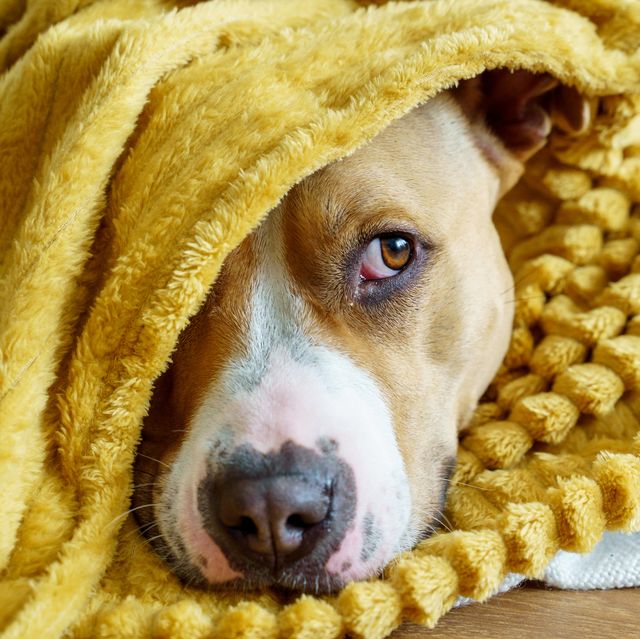
We've been independently researching and testing products for over 120 years. If you buy through our links, we may earn a commission. Learn more about our review process.
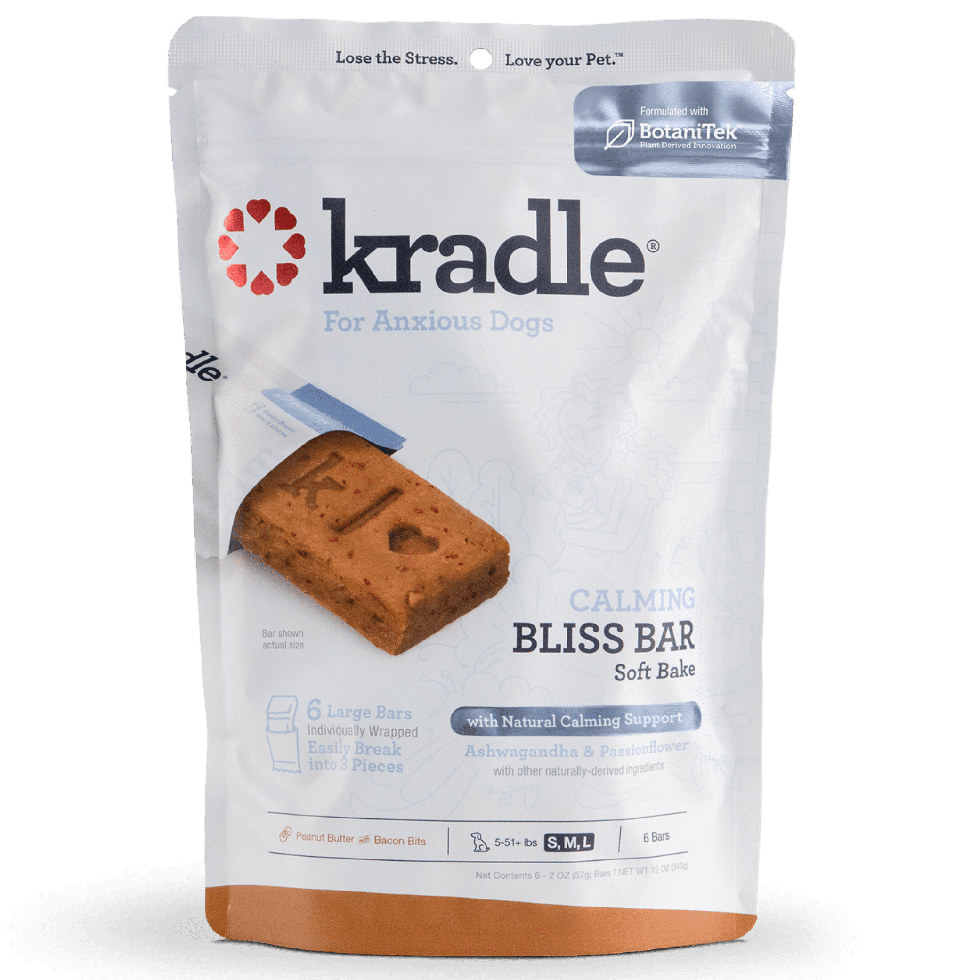
Best Overall
Kradle calming bliss bars.
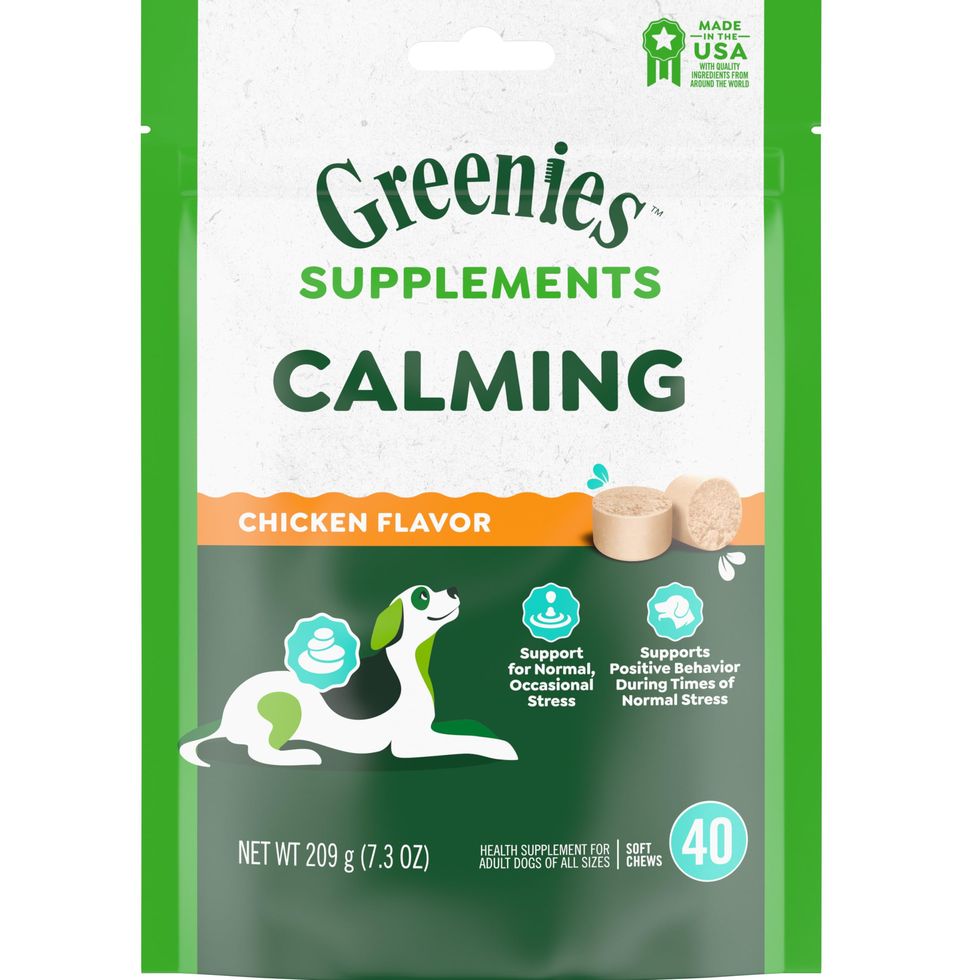
Greenies Calming Chews
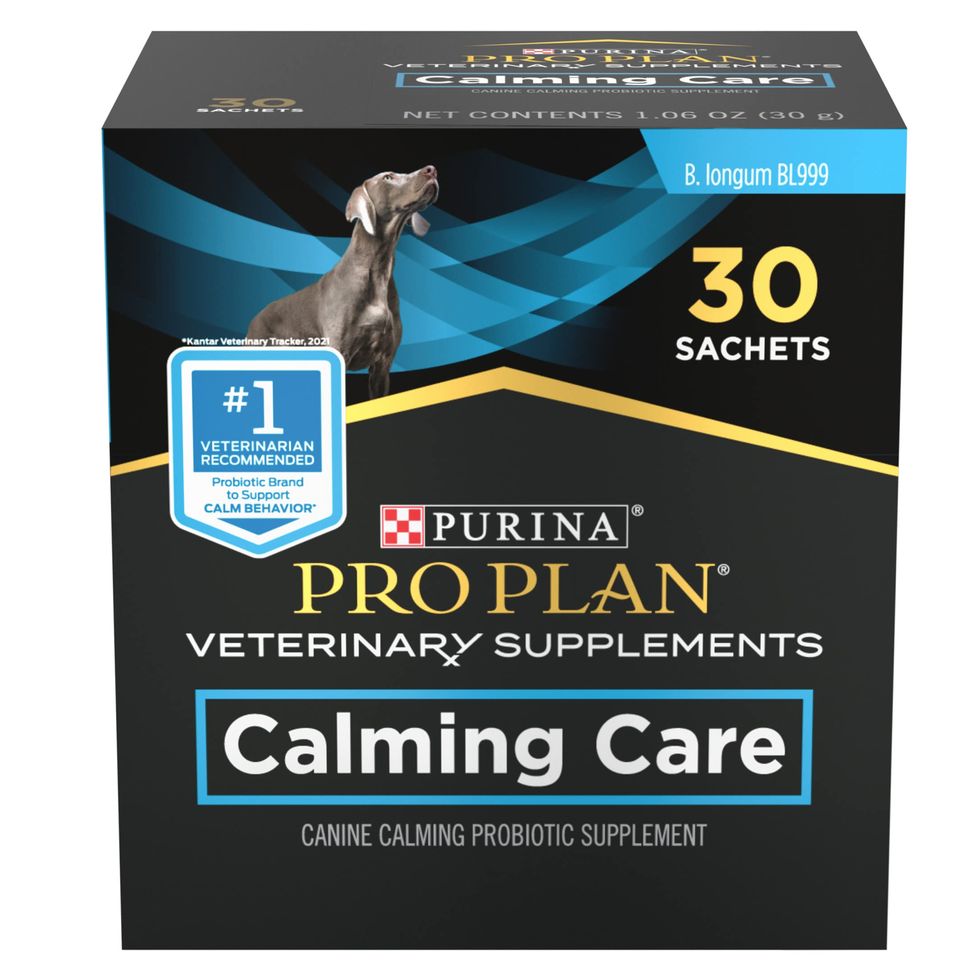
Best for General Anxiety
Purina pro plan calming care.

Best for a Stressful Event
Vetri science composure pro.
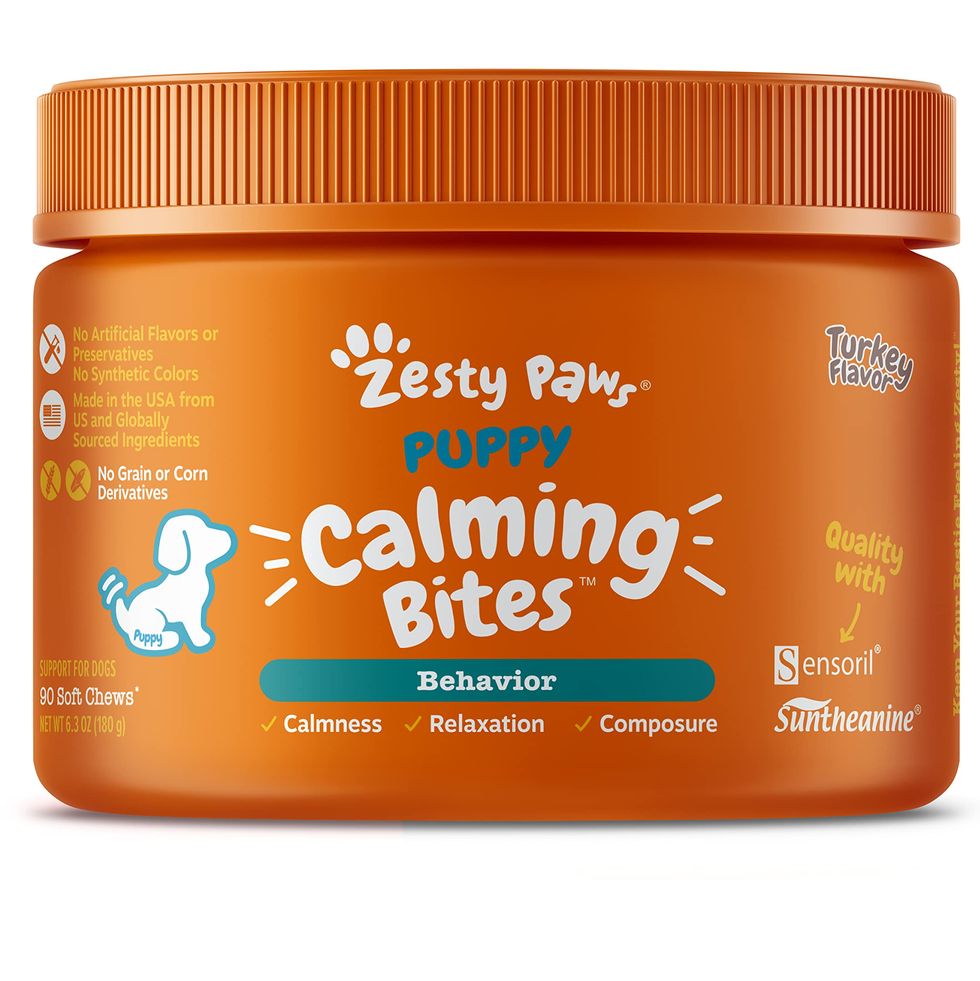
Best for Puppies
Zesty paws calming bites.
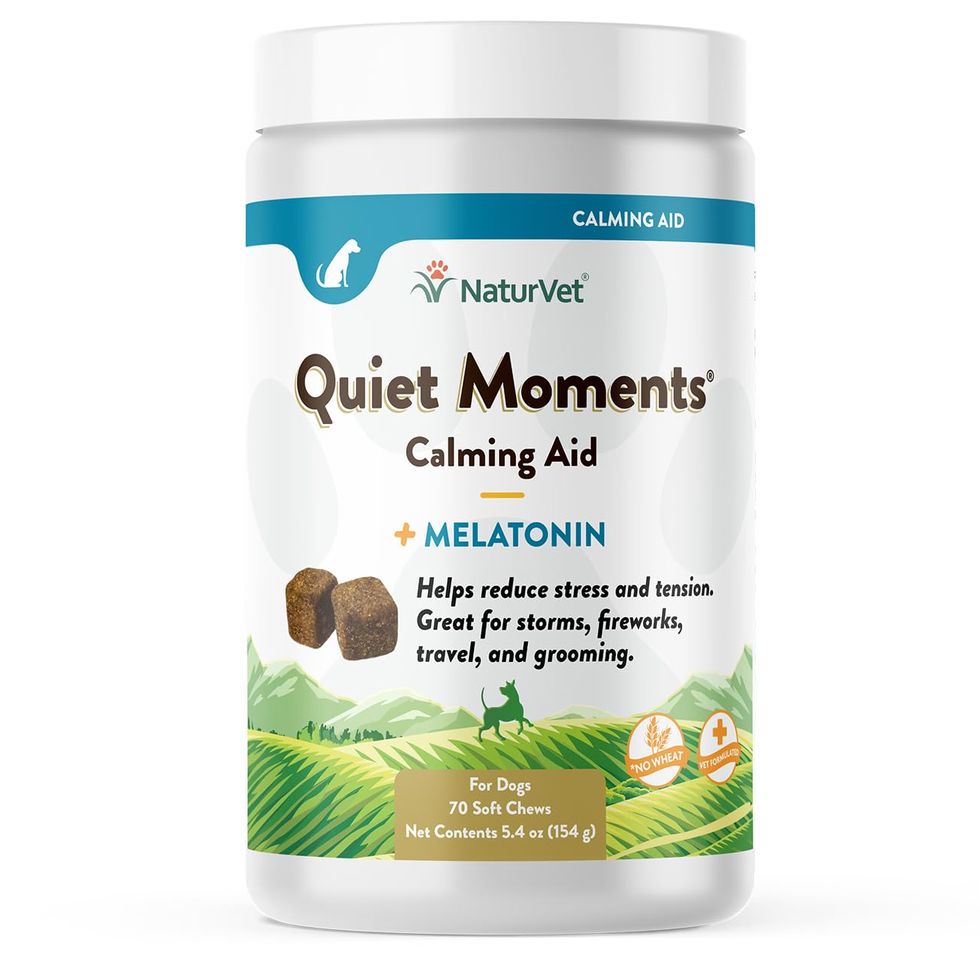
Best With Melatonin
Naturvet quiet moments.

Redbarn Bully Springs
To find the best calming treats for dogs, we sought the advice of Dr. Hammond and Lisa Lippman, D.V.M. , a veterinarian and director of virtual medicine for Bond Vet , asking them to weigh in on the ingredients they recommend for canine patients. Note that our list omits CBD and hemp dog treats , as our GH Institute nutrition experts don't yet believe there's enough clinical research to recommend them for dog anxiety. While there is some research showing CBD can help dogs with pain, Dr. Hammond says that she recommends using it "with caution and after consultation with a veterinarian." In general, it's good advice to speak to your veterinarian before feeding any dietary supplement to your dog .
Kradle is Dr. Hammond's top choice for calming dog treats. "It incorporates natural ingredients such as passionflower and L-tryptophan [an amino acid], which have been shown to have calming effects on dogs, " she said. The brand's soft Bliss Bars are in a dog-pleasing peanut butter-bacon flavor.
The brand suggests that you give a serving before a stressful event such as you leaving for work (separation anxiety is real!), a thunderstorm rolling in or a planned car ride. These can get pricey, especially if you have a big dog or intend to use these daily. For dogs who like to gnaw, the brand also makes hard chews .
Greenies chicken-flavored calming supplements has the only under-$20 pricetag on our list, and it's also an easy brand to find in many supermarkets, pet stores and mass merchants. The brand touts it for use in times of occasional (but normal) canine stress based on its lead ingredients, L-tryptophan and L-theanine (another amino acid), which may help reduce anxiety and stabilize mood , respectively.
These are relatively new for Greenies so there's not as many online reviews to read, but it's is a trusted brand that also makes some of our favorite cat treats .
Purina formulates this daily probiotic supplement for dogs that display general anxiety in the form of pacing, spinning, whining and/or barking. The brand says its proprietary strain of probiotics can help calm your dog, but there is no clinical study on it. We like that the powder is simple to sprinkle over your dog's regular food.
The brand cautions that it might take up to six weeks to see results, which can feel like a long stretch to dog owners, but some online reviewers report seeing much faster improvement. If you just want to calm your dog in a one-time stressful situation, such as a vet visit, you might want something more fast-acting.
Composure is a brand that Dr. Lippman trusts, and these chews are marketed as a way to calm a dog for a single stressful event that pops up from time to time, such as the need for a nail clipping or grooming session, fireworks or if you hear a thunderstorm rolling in.
Vetri Science says Composure will start working in a half hour, so you don't have to wait for weeks to see a behavior change — but these are not meant to be daily supplements, just as needed during stressful events. Like others, its powered by L-tryptophan and L-theanine, but the first ingredient is actually thiamine, a B vitamin, which, when deficient, can affect a dog's nervous system .
If you have a hyper or anxious puppy, this blend may be for them, made for a dog from 8 weeks to 12 months old . It uses chamomile and passionflower, two of the ingredients recommended by Dr. Hammond, plus other plant-based ingredients such as valerian and ginger. The small, soft bites are turkey flavored. Zesty Paws also makes a peanut butter flavor for fully grown dogs, and the supplements have more than 14,000 five-star Amazon reviews.
The right dose of melatonin can make an animal sleepy , so if that's what you're hoping to achieve — your dog napping in the car instead of whining at the window, or resting sleepily while visitors are over for dinner — this could be the calming dog treat for you. These chews also contain plenty of other calming ingredients such as chamomile, passionflower and L-tryptophan.
But note that an incorrect dose of melatonin can sometimes produce the opposite effect and increase a dog's heart rate or cause confusion , so dose carefully. If you want to further promote a calming atmosphere you might also try the brand's herbal calming room spray .
One pet owner with an anxious Spaniel swears these chews work wonders. "It's a vigorous chew experience, and he's always calm and happy afterward ," they said. So as an alternative to giving your dog a treat with calming ingredients, you can give your dog a long-lasting chew treat that will calm his troubles . It keeps a dog busy and distracted! And bully sticks are pricey, but made with just one single, natural ingredient.
RELATED: The Most Indestructible Dog Toys
How we chose the best calming dog treats

Two veterinary experts weighed in on this story: Sylvalyn Hammond , D.V.M., a general practice veterinarian in South Carolina, and Lisa Lippman , D.V.M., veterinarian and director of virtual medicine for Bond Vet , a chain of veterinary offices up and down the East Coast. We also checked in with Katie Brenner, a compliance officer with the National Animal Supplement Council .
On top of that, we consulted our in-house Good Housekeeping Institute experts on this guide, including Sabina Wizemann , a chemist who substantiates claims and evaluates products for the Good Housekeeping Seal , and Stefani Sassos , a registered dietitian who directs the Nutrition Lab. Last but not least, we interviewed real-life dog owners and sifted through online reviews for a full picture of real-life use of canine dietary supplements.
What to look for when shopping for calming dog treats

"Supplements are not tightly FDA-regulated , and different things may work for different pets," Dr. Lippman says. "So it's really about looking for trusted brands and trying them out to see what works for your pet."
Dr. Hammond agrees. "Every pet is unique, and individual factors such as age, breed, health status and concurrent medications must be considered before starting any new supplement regimen," which is why it's smart to first check in with your vet. Then, when shopping, consider:
✔️ Ingredients , including but not limited to:
- Chamomile: A medicinal herb with relaxing effects in dogs . (And humans, who enjoy chamomile tea.)
- Passionflower: Also a calming herb used for anxiety and sleep issues .
- Ashwagandha: Traditional, medicinal plant used to combat stress .
- L-theanine: A natural amino acid that can promote relaxation .
- L-tryptophan: An essential amino acid that works with serotonin and melatonin to help reduce anxiety . L-tryptophan is not made by a dog's body so it can only be consumed as food or treats.
- Ginger: There is some evidence that ginger can help with motion sickness and vomiting .
- Rosemary: This herb is thought to possibly enhance a dog's mood .
- Valerian: A flowering plant known for its sedative qualities .
- Melatonin: A sleep-regulating hormone that can help with stress .
✔️ Made in the U.S.: Dr. Hammond prefers treats that aren't imported, because the FDA has established Good Manufacturing Practices (GMPs) for American companies to follow that help ensure the safe composition of all dietary supplements, including ones for pets. All the treats on our list are made in the U.S., though some ingredients are globally sourced.
✔️ NASC-Certified: Both vets recommend looking for the NASC-Certified seal on dog supplements. Brands that are certified by the National Animal Supplement Council pay to be audited for quality so they can carry that third-party certification. Everything on our list is NASC-Certified except for the Bully Springs, which are not sold as supplements. (It's the action of chewing that is calming with those, not the ingredients.)
When to see a vet

If calming treats aren't helping, there is more to try. "There are non-treat products to help calm dogs, like ThunderShirts , which provide gentle pressure to help reduce anxiety," Dr. Hammond says. "There are calming sprays containing pheromones, plus environmental modifications such as creating a quiet, safe space for your dog during stressful events. Regular exercise, mental stimulation and positive reinforcement can also contribute to overall stress reduction in dogs."
Need more help? Consult your vet about a prescription. "When the anxiety is really bad, see your vet because oftentimes, drugs are really helpful," Dr. Lippman says. "Drugs are a big part of a vet practice in that we want to do things that take stress off of our animals. It's better living through chemistry."
Why trust Good Housekeeping?

For more than 120 years, the Good Housekeeping Institute has been dedicated to helping consumers make sound choices, and helping families with all things pet care is a part of that. Many of our Lab experts are dog and cat owners and we test things such as dog jackets and cat carriers in the Lab, in our own homes and in consumer-tester homes as well.
Journalist Jessica Hartshorn has owned pets all of her life, though admittedly now has two cats and no dogs. Fortunately she shares a home with her dog-owning cousin and has many dog parent friends who share their wisdom and are willing to test dog products. She also leans on the expertise of Good Housekeeping Lab experts and the brand's consumer testers.

@media(max-width: 64rem){.css-o9j0dn:before{margin-bottom:0.5rem;margin-right:0.625rem;color:#ffffff;width:1.25rem;bottom:-0.2rem;height:1.25rem;content:'_';display:inline-block;position:relative;line-height:1;background-repeat:no-repeat;}.loaded .css-o9j0dn:before{background-image:url(/_assets/design-tokens/goodhousekeeping/static/images/Clover.5c7a1a0.svg);}}@media(min-width: 48rem){.loaded .css-o9j0dn:before{background-image:url(/_assets/design-tokens/goodhousekeeping/static/images/Clover.5c7a1a0.svg);}} Product Reviews
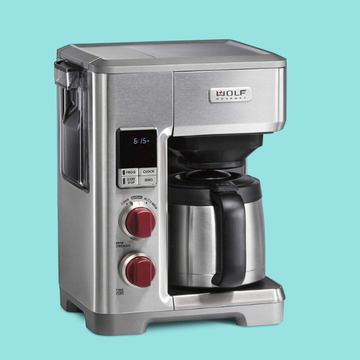
Hanes Beefy T-Shirt Review

Best Dinnerware Sets

The 15 Best Meal Delivery Services of 2024
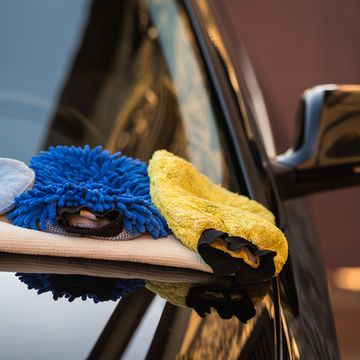
The Best Car Cleaning Kits

The Best Supplements for Menopause
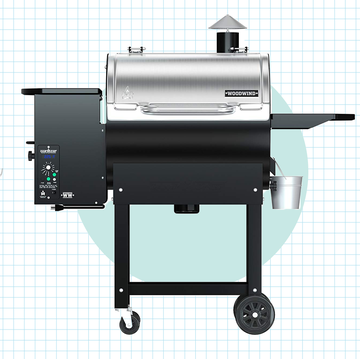
The 7 Best Pellet Grills

Best Garage Door Openers
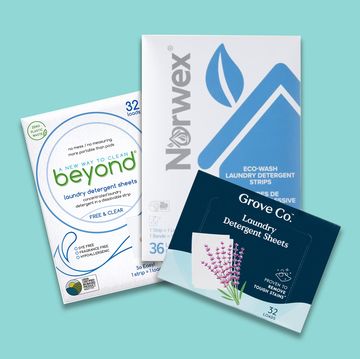
The Best Laundry Detergent Sheets
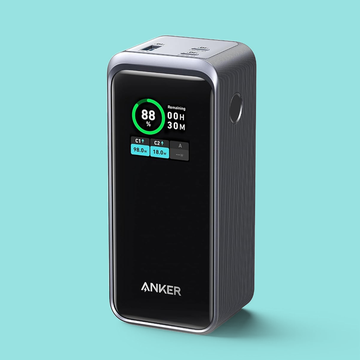
3 Best Portable Chargers

The 6 Best Smart Grills 2024

The Best Sleeper Sofas

Road Trips and Car Travel With Cats
Author: LeeAnna Buis, CFTBS, FFCP
Published: April 17, 2024
Our mission is to help save dogs' and cats’ lives through our educational content. To support our efforts, this page may contain affiliate links . We earn a commission for qualifying purchases – at no cost to you.
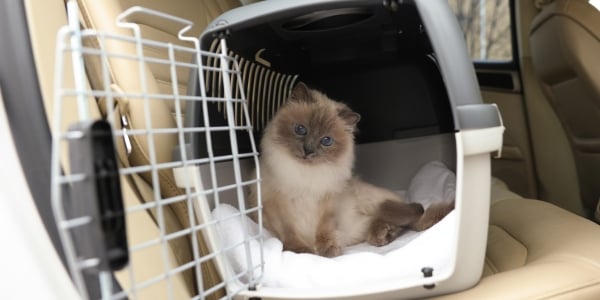
During the summer months and around the holidays, many of us head out on road trips and consider taking our feline family members along.
Summer is also a peak time for relocating across town or across country.
The problem is that most cats don’t feel safe in the car. They may cry or yowl, hide in their carrier, and even soil due to fear. That means an unpleasant trip for them and you.
It is possible to help your cat feel more secure in the car. Some may even learn to love it. We’re going to walk you through the steps to desensitize your cat to being in the car.
We’ll also recommend travel items to bring in the car and for a hotel stay so that you both have a safe and comfortable trip.
Skip to section:
- How to get your cat comfortable with car travel
- How to use a litter box when you travel – and will your cat use it?
- Where to stay when traveling with your cat and what to consider
- Special travel considerations for sick cats
- Be prepared for emergencies while traveling
Getting Your Cat Ready for a Road Trip
Step 1: get your kitty feeling comfortable in their carrier..
If they're going to ride in the car, like you, they’ll need to be safely “buckled up” to protect not just them but everyone in the car and on the road.
After all, unrestrained cats can be a distraction, interfering with your ability to steer or brake, and even become a dangerous projectile in the event of a crash or sudden stop.
What if your cat is wearing a harness and leash? If the car is moving, I still say keep them secure in a carrier. If you want to let them stretch their legs on the harness and leash while the car is stopped and windows are up, go for it. Just keep in mind that you’ve got to get them back in the carrier when you start moving again, and they may not love that.
It could be less stressful for everyone to stick with the carrier in the car and try the harness and leash INSIDE your hotel or destination. More on the dangers of letting your cat out of the car on their harness and leash later in the article.
So, your first step starts well before your trip. Spend some time training your cat to love their carrier – we have an article on that process – before the big travel day arrives.
Don't have a carrier for your cat yet? Check out our carrier recommendations, including carriers that are crash-test certified . If your cat is going to be spending a lot of long hours in the car, you may opt for a larger carrier than normal. We cover that, too. Just keep in mind you’ll want that carrier sooner rather than later, so you can use it during the pre-travel training.
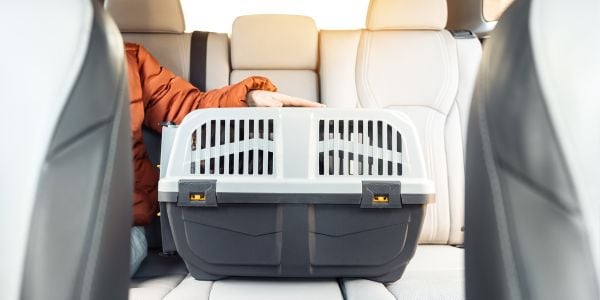
Step 2: Get your cat feeling comfortable in the car.
Now that your kitty feels better in their carrier, it’s time to help them feel comfortable in the car. Here are some steps to help you do that.
Pro Tip: Car acclimation is best done with two people … one to drive the car, the other to pet, praise, and treat kitty. It can be done with one person, too, but very carefully.
You’re going to do short sessions in the car – your cat dictates how long the sessions will be. The number of sessions depends on how quickly your cat gets comfortable. The main thing is that you don’t want to push your cat past their comfort zone. Your cat should always be calm.
You might be thinking that even if your cat is scared, leaving them in the car in spite of their fear will eventually show them they don’t have to be afraid. Nope! That’s not how cat brains work. Instead, think of it as starting at a really low intensity so your cat doesn’t have to be scared. As they’re ready, you slowly turn up the intensity.
If you turn it up too far and they get nervous, just end the session and lower the intensity for the next session.
Show them there’s no reason to be afraid because you’re not going to push them too far. And they’re getting good things through the entire process, so you’re actually turning a scary thing into a positive thing.
Take your cat out to the car in their carrier – covered on three sides with a towel or blanket for security.
With the car parked and not running and the doors and windows closed (weather permitting), sit in the back seat with your cat in their carrier. Partially open one of the carrier doors if you can do so without your cat trying to get out.
Then, make good things happen. Give treats (make sure it's a treat they love ), pets, praise, and show them this is a positive experience. Do this for just a few minutes (or longer if your cat is really enjoying it). Then, take them inside and end with treats and love. You’ll continue these sessions, gradually making them longer as your cat is comfortable, until your cat seems nice and calm, spending time in the car while in their carrier.
Next, you’ll turn up the intensity a bit by starting the car. Make sure the radio is off or very low (cats find classical music calming). And repeat the previous step.
Spend a few minutes in the back seat making good things happen for your cat while the car is running. If the engine really scares them, keep it short — just 1 minute with some treats. Again, you can gradually increase the length of time your cat is in the car, getting good things while the engine is on.
Caution: If your car is parked in your garage, either open your garage door or move your car out of the garage. Carbon monoxide is very dangerous for both of you!
Once your kitty is doing well with the car on, it’s time to turn the intensity up again. Time for a short drive.
Note: If they’re too nervous to eat treats, they’re probably not ready for this step. Back it up and spend more time on the previous steps.
It may just be pulling out of the driveway in the first couple of sessions. That’s just fine. You’ll work up to longer drives. And your cat will learn that being in the car doesn’t mean going to the vet. Never push these drives further than your cat is comfortable with. Also, be sure to drive calmly and go easy on the gas pedal and brakes.
Since each cat and each situation are different, it could take anywhere from a few sessions to several months for a cat to feel calm during car travel.
Car Travel Logistics With Cats
Will a cat use a litter box in a car.
Jumping right down to “business,” … depending on the duration of your travel adventures with kitty and where you’re winding up, you’re going to have to deal with litter box accommodations. This is the case both when you’re on the road and when you get to your hotel or destination.
Just because you give your cat access to a box doesn’t mean they’ll use it, especially if they’re nervous.
Cats don’t like to eliminate when they feel unsafe. They'll likely choose to do their business once you get to your destination. It’s nothing to worry about unless they go more than about 24 hours without peeing. At that point, call your vet and see what they suggest.
When I moved with my cats, and we had 8-hour days in the car, they held it all day and most of the night.
If they’re willing, you can help your cat take care of business on the road in a few different ways.
First, get them a good travel litter box. You’ll use the same litter they use at home, and (perhaps) even a litter attractant.
A good travel litter box will be large enough for your cat to fit in yet small enough to fit in their carrier. It will also be waterproof and sturdy. You can use a small plastic litter box or there are also disposable litter box options available.
We have travel litter box and large carrier recommendations here .
Set the travel box up in your home as an alternate option before your trip so your cat can get used to it. Don’t replace your regular boxes with the travel box, though. Have all options available.

If Your Carrier Can't Fit a Litter Box
Letting your cat out of a carrier to use a box placed in the car isn’t ideal. I actually rescued a kitten from the roadside once without a carrier. That kitten ended up inside my dashboard. So, if you think your cat can’t hide in dangerous places within the confines of your car, you’re wrong.
If your trip isn’t too long and their carrier isn’t large enough to fit a litter box, you can go with a larger litter box that they can use at the hotel or destination.
Note: If your cat uses the smaller travel litter box on the road, don’t consider replacing your larger boxes at home. Tiny boxes are not ideal and don’t fit your cat’s instinctual needs. They’re not a good long-term option. They’re the lesser of two evils when you’re traveling — the other evil being your cat peeing in the carrier.
Should You Let Your Cat Go Outside?
My vote is no unless you have a cat who is completely comfortable with travel, being in new places, and seeing and hearing strange people, pets, and sounds.
The first concern is that no harness is 100% escape-proof. If your cat gets scared, they can and will get out of that harness and take off.
Second, they’re going to be surrounded by newness — smells, sights, sounds, things you can’t control. Even if they don’t get scared, the idea that you’ll be able to get them to focus on peeing at that moment isn’t very likely. Cats don’t pee and poop on cue the way dogs can. It’s safer to keep them in the car.
What Do You Do With Your Cat When You Have to Go?
If the temperatures aren’t too hot or cold to leave your cat in the car, just leave them in their carrier and go about your business. Just make it quick!
Cover three sides of the carrier so they feel more secure and are less of a target for theft. Use a light cover (blanket) for warm days and a heavier cover for cooler days. Both should still allow for airflow.
It's usually safe between about 40–65 degrees F (4–18 degrees C), though every cat and every situation will be different, so use this as a rough guide.
Talk to your vet about more specific safe temperature ranges for your cat based their age, breed, and any chronic medical conditions they may have or medications they may be on. If the temperatures are outside of that range, you’re going to have to take some precautions when making your own pit stops that take you away from your car.
In some cases, it may be possible for you to bring your cat into the bathroom with you in their carrier.
Quick tips if you must leave your cat in the car
- Some cars now have pet mode , like Telsa, Chevrolet Bolt, Rivian, and other Form and BMW models. Caution: If you decide to leave your engine running in a gas-powered car, be aware that car engines and air conditioner compressors can and do fail, leading to excessively hot temperatures building up in the car quickly. Similar malfunctions can happen in EV cars, too, and if the battery dies, the cooling system will shut off.
- If leaving your car and running the A/C or heat isn’t possible or practical, pre-cool or pre-heat your car the best you can by running the system on high for several minutes before you get out. Then, be quick!
- Move their carrier from the back seat to the back floor. Since hot air rises, it should be a bit cooler on the floor. There are fans made for keeping pets cool in the car , but we really can't overstate this: pets should never be left in a closed car, even in the shade or with cooling devices. In this case, it's simply for a quick amount of time.
- Park in the most well-shaded spot you can find.
- Park with your front windshield facing the sun and put up a reflective windshield sun shade like this one .
- Cracking the windows doesn’t make a huge difference, but it also doesn’t hurt (so long as your cat is securely in their carrier and there’s no danger of someone reaching into your car and stealing them and your stuff).
- Make sure you leave your cat plenty of water.
- If it's cold outside, add a warm blanket or fleece to your cat's carrier for them to snuggle up. If it's sunny, move the carrier to a sunny spot in the car.
- Be as quick with your stop as possible. If it’s a food break, get it to go from a drive-thru and eat it in your car.

Where to Stay When Traveling With Your Cat
Road trips and long-distance moves with cats will often require hotel stays. But not all hotels, motels, or rentals are pet-friendly. And just because they say they’re “pet” friendly doesn’t mean they’re “cat” friendly. So, plan ahead. Call to confirm they take cats and reserve the room or rental in advance.
Pro Tip: “Pet-friendly” means other pets likely stayed in that room recently! Not everyone uses flea and other parasite protection on their cats and dogs. Make sure your cat is protected before heading out on the road! Learn more about safe and effective parasite prevention for your cat , and talk to your veterinarian.
What to Do With Your Cat in the Hotel or Rental
Once you’re out of the car, you’re faced with a question. Do you let your cat out in the hotel or rental to explore, or do you keep them confined? There’s a lot that goes into the answer. Here are some things to consider:
Is your cat relaxed in new places? Being in their carrier in the car is different than being in a completely new room with smells and places to hide.
Does your cat chew, climb, or otherwise destroy things? I couldn’t let my cat into a new space without putting cord protectors on every cord, or they’d be chewed in a matter of minutes.
Are there hiding places you can’t get to or unsafe spaces your cat can reach? The last thing you want is your cat stuck in the vents of a hotel or squeezing through that tiny hole in the wall behind the fridge in your rental. It happens.
Is it clean? Not to get gross, but you may not want your cat rolling around on a motel floor or getting under the bed.
Is it safe from toxins? There could be rodent traps or pest poison in the room that could be dangerous for your cat.
Is there any chance they’re going to pee on something? Yep, it happened to me on my road trip. My cat was stressed and peed all over the fabric carrier, and it soaked through to the bed. Talk about embarrassing. And there's sometimes an additional cleaning fee for mishaps like this.

Confinement for Safety
I like the idea of bringing along a much larger, collapsible pet pen for overnight use. They’re plenty big enough for a good-sized litter box and everything your cat needs. There’s even room to play. Just make sure you get one with a top, or your cat will jump right out.
If you want to let your cat out on a harness and leash or heavily supervised, you have the option. But you’ve got the pet pen as a backup just in case you need it. You never know how a cat is going to react in a new space, especially when you’re sleeping or in the shower and they’re unsupervised. Here are a few great options:
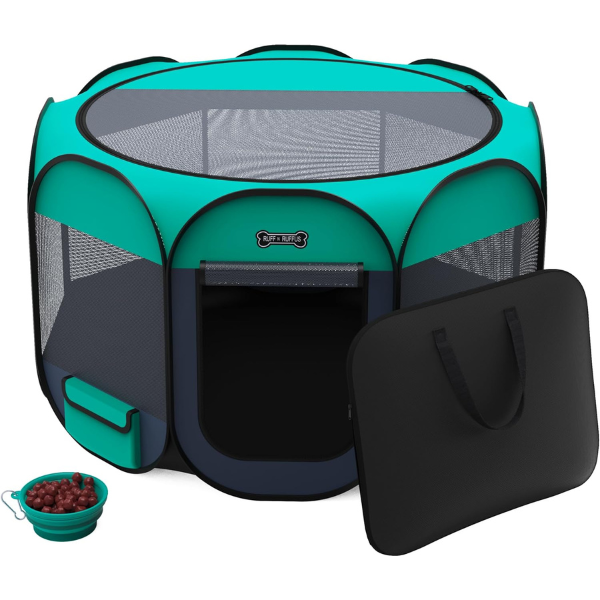
Available at:
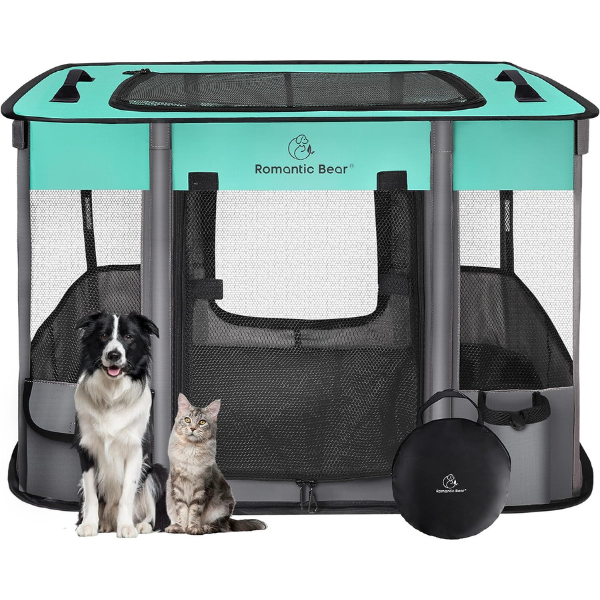
Travel Considerations for Cats With Chronic Health Issues
Before striking out on the road for a long trip or moving with a cat who has a chronic medical condition or is on long-term medications — like diabetes , hyperthyroidism , chronic kidney disease , or heart disease — there are a few precautions you should take.
- Make sure your cat had a recent (ideally within the past month or so) exam with their vet. You’ll have more peace of mind knowing that their condition is as well managed as possible and that they’re as healthy as can be before hitting the road with them. Your vet will also have recommendations for making their trip as comfortable and safe as possible.
- Bring a copy of your cat’s medical records with you! This should include recent exam notes, laboratory test results, and medication/supplement names and dosages. Your vet can often print these out (with enough notice), and they may even subscribe to an app or other service that allows you to keep updated copies of such records with you always on your phone. This will make visiting another vet on the road much easier.
- Especially for cats with known chronic health concerns, it’s a good idea to know about a few vet hospitals along your route and in the area of your destination before you head out. See the vet locator tools listed in the next emergency section to start searching.
- If your cat is on a special prescription diet, like for their kidneys, make sure to stock up on it from your vet before leaving. It’s not always easy to get prescription diet refills when you’re away from home. You should take enough with you to last for the duration of your trip PLUS an additional (at least) 2 weeks.
- Similarly, be sure to stock up on your pet’s medications and supplements, as well as any supplies you need for them. This would include needles and a travel-sized sharps container (or larger needle container ) for safely disposing of and storing used needles for diabetic cats, pills for blood pressure, overactive thyroid, and any other chronic medications. Again, you should take with you enough to last for the duration of your trip PLUS an additional (at least) 2 weeks.
- If your cat is diabetic and on insulin, don’t forget a cooler and ice packs to help keep it cool while in the car. You can also look into a cooler that plugs into your car’s cigarette lighter or USB, like these: Cooluli Mini , Wagan 14L , or the Wagan 24L (which could even store some of your food and drinks for the road). Pro Tip: Depending on the type of insulin your cat is on, you may be able to get an insulin “pen” that may be more stable outside of the fridge and easier to administer to your cat. It's still advisable to use a cooling case for the pens . Talk to your vet to see if an insulin pen is an option for your cat — it isn’t for all cats, but if it is for yours, it could be a great travel (and even long-term) solution for you.
Emergencies on the Road With Your Cat
It’s a good idea to plan ahead and map out a few 24-hour Emergency Clinics on your route, just in case. Try this vet emergency locator .
Have your hometown veterinary clinic number handy, too. For less serious issues, call them first. They may be able to give you advice or let you know if it’s a true emergency.
Make sure you have a card in your wallet or attached to your cat’s carrier with your cat’s name, the number where you can be reached during travel, and an emergency contact who is not traveling with you. If your cat has medical issues, you should list those as well or the contact info for your veterinary clinic. If there’s an accident, your car is stolen, or something happens where you’re separated from your cat, emergency services will have options.
I just got this great set for myself (featured below). The keychain says “pet home alone,” with instructions to look in your wallet for a card with emergency contact info. It’s meant to notify emergency services if you’re in an emergency situation and someone needs to care for your pet at home. In this case, you’d just include a note on the card that you’re traveling with your cat in the car.
It’s also vital to ensure your cat is microchipped and the contact information is up-to-date (including a way you can be reached on the road).
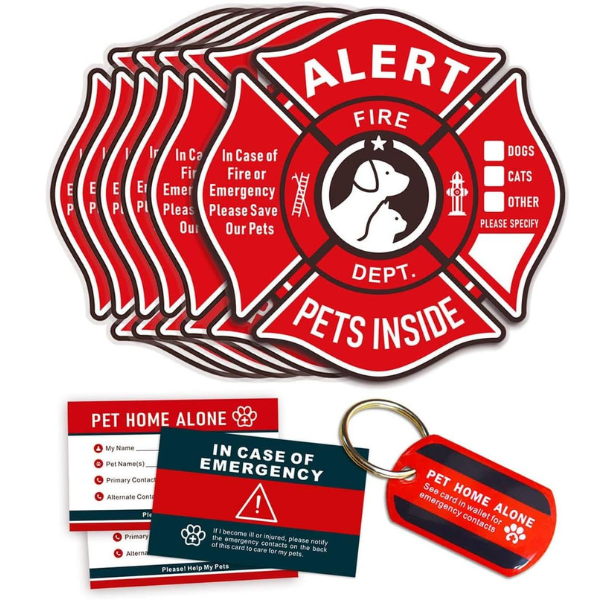
First Aid on the Road
Consider putting together a pet first-aid kit for your car. Here's a shopping list of first-aid essentials . Look for the icon of a little car 🚗, as it's these products that are the most essential in a smaller, travel-sized first-aid kit.
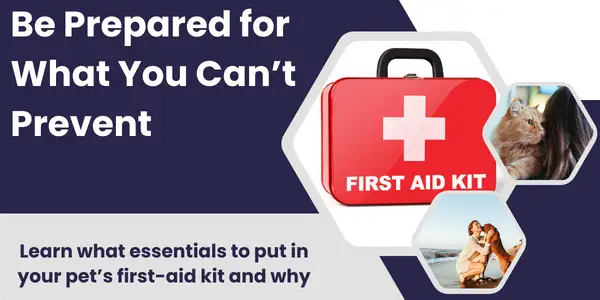
We encourage you to leave a comment below if you’ve got any tricks, tips, or products you’ve used that made car travel with your cats easier. Best of luck on your travels or your move. Have fun and be safe!
About the author

LeeAnna Buis, CFTBS, FFCP
LeeAnna Buis has adored cats her entire life and thought she knew them inside-out and sideways. But it wasn’t until she worked with a feline behavior consultant that she fully understood how incredible, complicated, and inspiring cats really are. Literally, that day, she made a career change knowing she wanted to give other cat parents the same experience of truly “seeing” and appreciating their cats. Now, she works virtually with cat parents all over the world through Feline Behavior Solutions and Preventive Vet.
LeeAnna earned her certification through Animal Behavior Institute, earning the CFTBS designation. She is a certified Fear Free® trainer (FFCP), a training professional member of the Pet Professional Guild (PPG), and a member of both the International Association of Animal Behavior Consultants (IAABC) and Cat Writer’s Association (CWA).
More about LeeAnna Buis, CFTBS, FFCP
Related Articles

- Cat Behavior
- Health & Care
How to Travel With a Cat: 14 Vet Approved Tips & Tricks
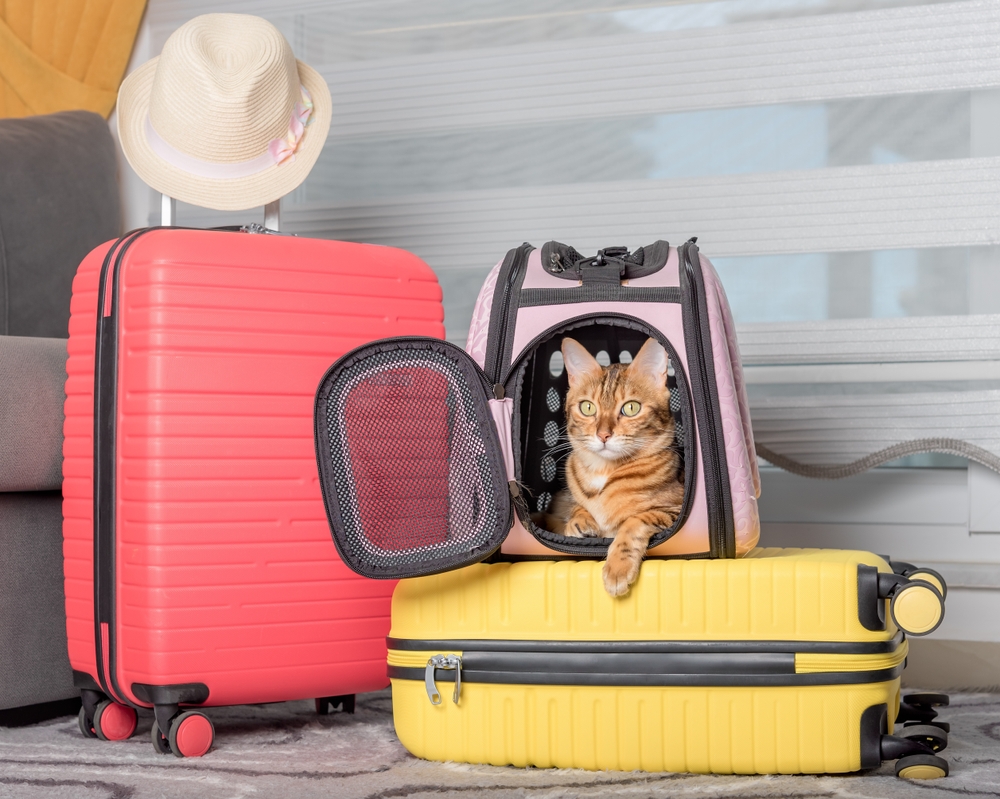
Image Credit: Svetlana Rey, Shutterstock
Last Updated on April 19, 2024 by Catster Editorial Team
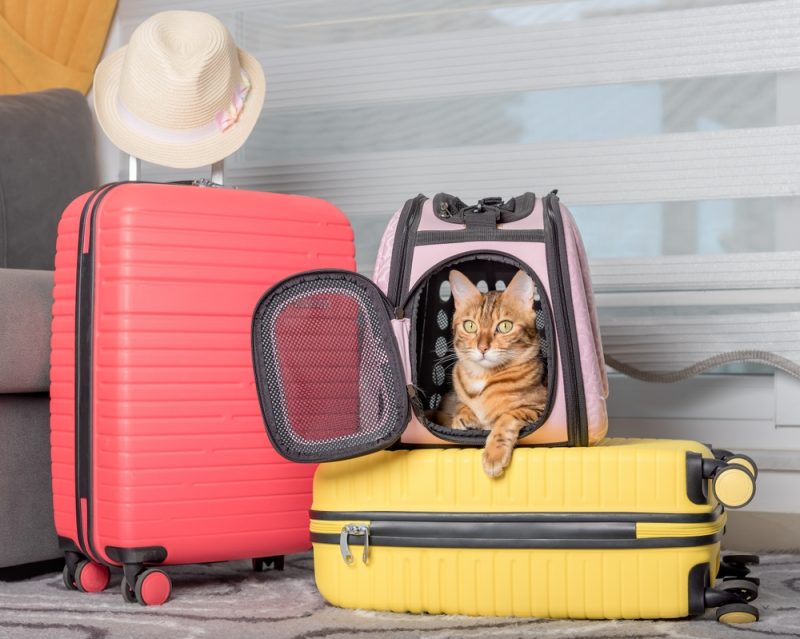
VET APPROVED
REVIEWED & FACT-CHECKED BY
Dr. Amanda Charles
BVSc GPCert (Derm) MRCVS (Veterinarian)
The information is current and up-to-date in accordance with the latest veterinarian research.
Traveling with a cat can be rewarding, but it requires thorough planning. Whether you’re getting ready to drive a short distance and hang out with family or fly somewhere for a relaxing vacation, there are a few factors to consider when traveling with your cat.
Make sure to start the planning process early, particularly if you’re traveling internationally or are going to stay in a hotel during any part of your journey. Below, you’ll find 14 tips and tricks to make your journey with your cat successful.

- The 14 Tips to Travel with a Cat
- 1. Invest in a Good Carrier
Cats should always be restrained when riding in cars, and airports require them to stay in their carriers at all times (except during the security screening process). Airlines have several rules and regulations regarding traveling with pets, including guidelines regarding the size of carriers.
Make sure the carrier you use meets the airline’s regulations and requirements. If you’re driving, the sky’s the limit when it comes to the size of your cat’s mobile palace. Carriers should be sturdy, well-ventilated, secure, and easy to clean. Plastic carriers are usually the best options.
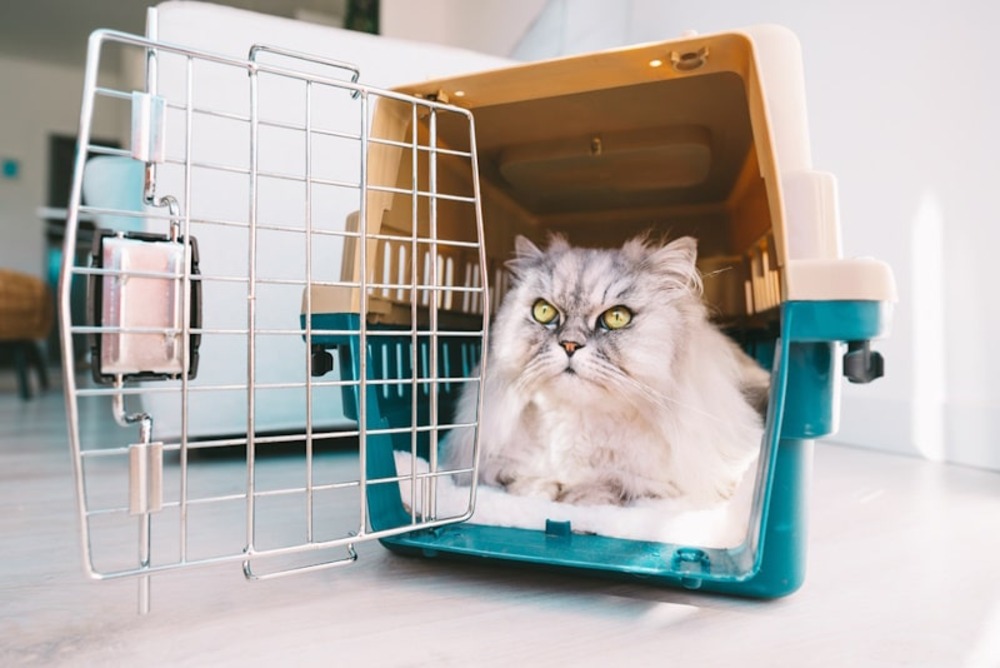
- 2. Give Your Cat Time to Get Used to Their Carrier
Because cats spend so much time in their carriers when traveling, they must feel comfortable in them. Consider leaving your cat’s carrier out so they can get used to it before your trip.
Letting your cat have dinner in their carrier a few times may encourage them to develop positive associations with their traveling home.
- 3. Invest in a Good Harness and Leash
If you visit a rest stop during a road trip, your cat should be harnessed and leashed when they’re away from their carrier to ensure they can’t run off and get lost if they become scared.
Make sure the harness you choose fits properly, and give your cat time to get used to wearing it so they’re ready to do so when you hit the road.
Are you looking for the perfect cat harness? We suggest Hepper's Cat Harness & Leash Set , which includes a nicely designed, machine-washable harness made from soft, sturdy velvet and mesh.

- Escape Proof - Cat leashes and harnesses for walking aren't all equally secure. Our double aluminium...
- Superior Comfort - Our cat harnesses are lightweight, made with premium velvet fabric, breathable...
- Free Extra Strength Leash - You don't need to worry about your cat escaping this harness. This cat...
This harness is easy to put on and take off and features reinforced stitching, reflective stripes, and quick-release buckles. This set also includes a great leash made from durable nylon climbing rope.
At Catster, we’ve admired Hepper for many years and decided to take a controlling ownership interest so that we could benefit from the outstanding designs of this cool cat company!
- 4. Practice Everything
No matter how you’re traveling, your cat must be comfortable entering and exiting the carrier. If you’re flying, you’ll need to take them out of their carrier during the security screening process in the airport.
You can practice taking your cat out of the carrier when you’re around other people to make them more comfortable during the security check. If you plan on driving, consider taking your cat for a few practice rides to get them used to spending time in the car. Make sure to reward them for their cooperation!
- 5. Ask Your Veterinarian for Advice
Some easily stressed cats may benefit from medication to help them stay mellow while traveling. However, sedation isn’t suitable for all cats, and most airlines won’t transport pets who have been tranquilized or sedated.
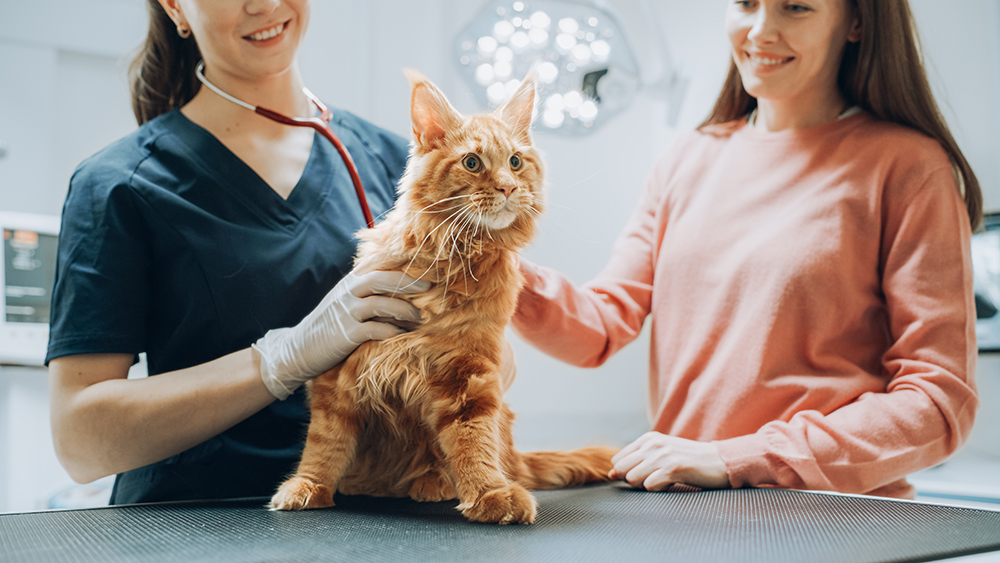
- 6. Have Cleaning Supplies on Hand
Pack a bag with cleaning supplies and plan to have it close at hand while you’re underway in case your cat has an accident and you need to do a bit of on-the-fly cleaning. It’s best to pack paper towels or cleaning wipes, gloves, and baggies for disposal.

- Gentle Care For All Pets - Infused with moisturizing hypoallergenic ingredients & enriched with...
- Deep Cleans From Head to Tail - Tackle the toughest dirt & messes with our extra strong pet wipes...
- Freshness On The Go - Each dog grooming wipes pack contains 30 counts of premium dog wipes that...
It's hard to beat the convenience of pet-safe wipes after a big adventure, between baths, or when cleaning sensitive areas. Our favorite option is Hepper's Wash Wipes, premium wipes designed to safely and gently remove grime from cats and dogs of all ages and sizes. These hypoallergenic wipes are made in the USA and feature moisturizing ingredients to soothe your pet's skin.
- 7. Pack Toys and Blankets
Take a few of your cat’s favorite toys and a well-loved blanket that smells like home to keep them comfortable while away from their territory. Putting a favorite blanket in your cat’s carrier may make being on the road less stressful.
A stuffed toy might look a little different than a traditional cat toy but many felines find them quite enticing. The Hepper Plush Whale serves a dual purpose, featuring a faux fur exterior that mimics prey and a soft interior for cuddling during long cat naps when playtime is over. The best part about it is it's an affordable option for ages, sizes, and conditions. Learn more about why your cat needs a plush here!

- Tailored size even for kittens - the compact size of the whale plush cat toy at 15cm long ensures...
- Catnip Free Cat Toys - Made with top quality plush exterior & cotton interior, it's perfect for cats...
- Peaceful Playtime - No more squeaky cat toys for indoor cats. This stuffed cat toy is perfect for...
At Catster, we've admired Hepper for many years, and decided to take a controlling ownership interest so that we could benefit from the outstanding designs of this cool cat company!
- 8. Consider Portable Litter Boxes
If you’re traveling by car , pack a litter box with some of your cat’s regular litter. Plastic poop bags and a scoop are also essential. If you’re staying at a hotel, check their pet policies thoroughly.
Most hotels that accept cats don’t provide litter boxes and litter. Collapsible litter boxes are ideal for shorter trips and can be folded down and packed.
- 9. Pack Food, Water, Treats, and Medication
If you’re traveling by car, bring enough of your cat’s regular food to keep them happy while you’re away from home. It’s also helpful (and usually mandatory) to pack food and water for your cat while flying, but some cats may be too nervous to eat until you land.
If your cat takes medication, pack enough to last them for your entire trip, and consider putting it in your carry-on luggage to ensure you have access to it even if your checked luggage takes a detour.
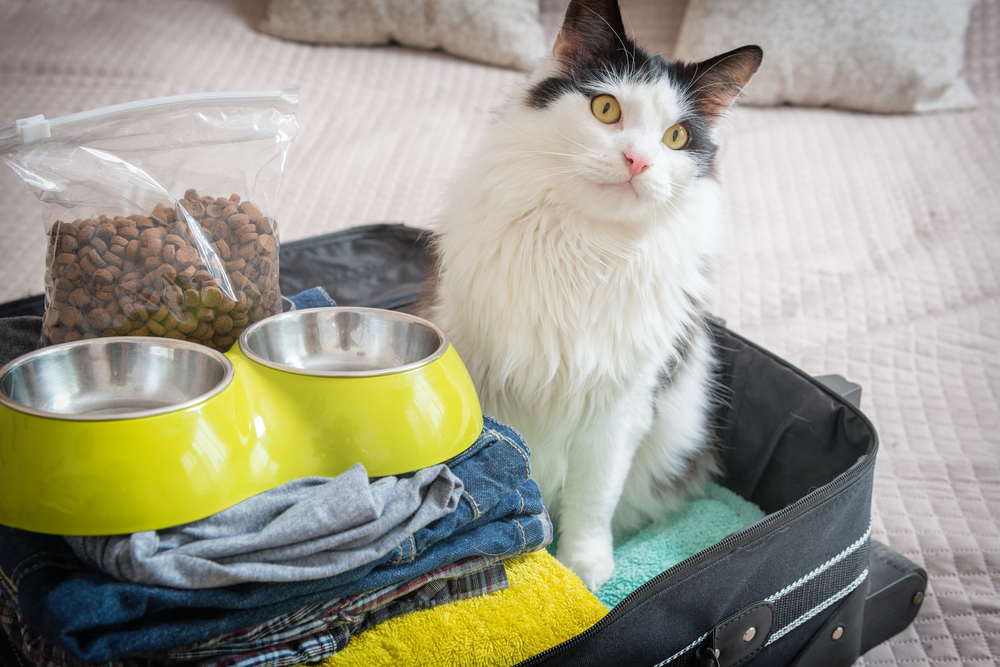
- 10. Consider Pheromones
Commercial synthetic feline pheromone products may help some cats stay calm while underway by reducing stress and creating a sense of safety and well-being. They’re available in sprays and wipes, so your cat can enjoy the benefits of calming pheromones while you’re on the road.
- 11. Check Your Cat’s Microchip Registration
Ensure that the registry where your cat’s microchip is registered has the right contact information. Losing your cat when you’re out of town is a nightmare, but an up-to-date microchip can significantly improve the chances of their return.
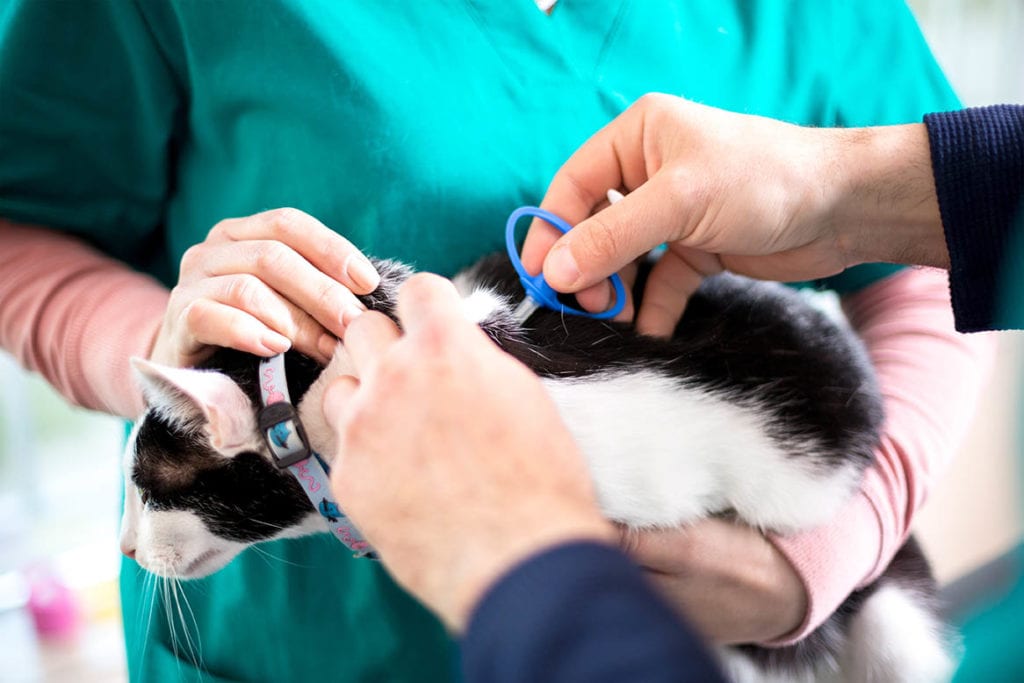
- 12. Collect Your Cat’s Medical Information
It’s vital to collect your cat’s medical information before you plan to leave and make sure you have a way to access it while you’re on the road in case they require veterinary care while you’re away from home.
Ensure you have all the documentation and certificates your cat needs to travel, including their vaccination status. Remember that the requirements vary based on where you’re headed and how you plan to travel.
- 13. Double Check Your Reservations
If you plan on staying in a hotel at your destination, contact the property ahead of time to ensure pets are permitted and get information about the rules and requirements that may apply. Don’t forget to inquire about the availability of litter boxes and food and water bowls.

- 14. Invest in Physical ID Tags
It’s best to attach an ID tag with your name and contact information to your cat’s collar. It will make it easy for people to reach out to you if your cat gets loose and makes a run for it.
Microchips are helpful , but lost cats need to be taken to shelters or veterinarians with scanners for their chips to be read. ID tags make the reunification process far more efficient; if your cat runs off, anyone who finds them can simply give you a call.

Traveling with cats can be stress-free with a bit of planning and preparation. Make sure to get started before you hit the road with your cat , particularly if you’re thinking about flying or staying in a hotel. Also, don’t forget to invest in an appropriate carrier and give your cat lots of time to get used to it.
- Hiking With a Cat: Is It Possible?
- Traveling With Kittens: Essential Tips
- https://vcahospitals.com/know-your-pet/flying-with-your-cat
- https://vcahospitals.com/know-your-pet/road-trips-and-car-travel-with-your-cat
- https://www.petmd.com/cat/care/8-tips-traveling-cat
- https://www.avma.org/resources-tools/pet-owners/petcare/traveling-your-pet-faq
- https://www.aa.com/i18n/travel-info/special-assistance/pets.jsp#:~:text=As%20recommended%20by%20the%20American,cardiovascular%20problems%20at%20high%20altitudes.
Featured Image Credit: Angels Relax CZ, Shutterstock
About the Author
Lorre Luther
Lorre Luther is a writer who is firmly convinced that cats are smarter than humans. She left her law career in the United States and moved to the Netherlands to follow her dream of becoming a writer. Lorre currently lives in Rotterdam, she enjoys traveling and greatly appreciates the beauty of nature. Lorre has a spot for animals and admires the intelligence of cats.

Zumalka Pet Supplement Review 2024: A Detailed Look

10 Pet-Friendly Hotels in St. George, Utah (2024 Update)

Does Health Monitoring Cat Litter Work? Vet Reviewed Facts & FAQ
Get catster in your inbox.

Here Comes the Sun: Is It Alright? Dangerous Things Cats Like

Cat Dogs: Cats for People Who Think They Don’t Like Cats

Strange Places That Cats Hide: Olga’s Preferred Spots
© pangolia pte. ltd. all rights reserved..

WATCH: Officials evacuate 46 dogs from smoke-filled kennel
FAIRFIELD, N.J. (WABC) – More than 40 dogs were rescued from a kennel in New Jersey after it filled with smoke.
Police released bodycam video of the rescue at the K9 Resorts Pet Hotel in Fairfield.
A fire at a smoke shop two doors down from the kennel sent smoke snaking through the shared ventilation system.
Officer Ryan Cleary was one of the first four officers to arrive. He broke in the door to get to the animals.
“All we were thinking was how many dogs are inside and how are we going to get them out back safely to their owners,” he said.
Fortunately, the officers did not have to shoulder the task alone. They were assisted by fire fighters and K9 Resorts workers, among several others.
Graham Clarke and his wife just closed their nearby shop for the night when they noticed the commotion.
“It was kind of exciting,” he said. “The dogs were old, very well behaved for dogs that had just been pulled out of a smoke filled building.”
Once out of the building, local vets on call for the facility checked out all the dogs.
The Humane Society jumped in to help move the dogs to another K9 Resorts location.
All of the dogs are expected to make it home safely.
“We’re all dog owners and none of us wanted any dogs to come to any harm,” Cleary said. “Our goal was, let’s just get these dogs out.”
Copyright 2024 WABC via CNN Newsource. All rights reserved.

‘A nightmare’: What High Water Festival attendees hope changes about travel

Mother says students saved her son’s life after man allegedly tried to grab him during recess

N. Charleston babysitter charged after child severely burned

Missing 14-year-old found safe, Charleston Police say

Judge sentences N. Charleston man found with loaded gun while out on bond for murder
Latest news.

Arizona grand jury indicts 11 Republicans who falsely declared Trump won the state in 2020

Amber Alert for 10-year-old boy canceled; child found safe

Police tangle with students in Texas and California as wave of campus protest against Gaza war grows

Man found guilty of murdering Mount Pleasant woman in 2019

City of Charleston does not recommend College Lodge demo, despite college request

IMAGES
VIDEO
COMMENTS
5. A crate, car seat, and/or seatbelt are necessary. Safety is important when you're on the road. If you stop short, slam on the brakes, or get into an accident, your dog can get seriously hurt. To protect your dog, make sure to secure them while in the vehicle. For medium to large dogs, try a crate or dog seatbelt.
A few dog carrier tips for car travel: Make sure that whatever carrier or crate you get is large enough for your dog to stand, sit, lie down and turn around in. Place the carrier in the back seat, and then thread the seat belt through the handle. (Unsecured carriers can slide around on the seat.)
Crate. A safer way for your dog to travel in a car is in a dog crate, preferably made from a strong material such as aluminum. Some crates even have padding for added impact protection. No matter ...
Car travel with dogs, especially long trips, requires some forethought. You can't just assume you'll be able to get everything you need for your pet during your trip. 10 Tips for Safe Car Travel
Dog Car Safety Training. Although car travel is familiar to humans, how to behave in this scenario isn't something dogs automatically understand. ©dmytrobandak - stock.adobe.com.
Dogs can be great travel companions, but before you gas up the car and back out of the driveway, there are definitely a few things you can do to make your dog's trip in the car smoother, safer, and more enjoyable for everybody. Car Sickness in Dogs. Dogs can get car sick while riding in the car, and often this leads to travel anxiety.
However, traveling with dogs in a car can pose some safety concerns. Read on to learn more about safety tips for car travel with dogs. Bring Health Records. Planning ahead when traveling with dogs in a car is important. Ensure your pup is up to date on vaccinations and has identification tags with current information on their collar.
Pack a few water bottles and a travel-sized water bowl for your dog, and offer them water every time you stop at gas stations or rest stops. This is especially important if your dog doesn't like to drink while the car is in motion. 5. Regular Potty Breaks.
Take a look at the results of our best dog car seat belt round-up. 11. Hide his eyes or distract the nose. Some dogs simply prefer not to see where they're going. In such cases, it's best to get a ...
Give your dog a meal 3 to 4 hours before you hit the road. Whenever it is time for them to eat again, always pull the car over and stop to let them eat and take a bathroom break before resuming. 4. Don't Leave Your Dog in the Car. Do not ever leave your dog in a car unattended.
2. Introduce your dog to the cage, if you are using one. Present the cage to your dog positively. Allow the dog to sniff the cage before it goes in the car. Once the cage is placed in the car, lock your dog in it. Continue your positive attitude about the cage and walk away from the dog in the cage for several minutes.
Keep your dog safe while driving. According to the Whole Dog Journal, the safest way to travel with a dog in the car is by securing them in a dog travel crate. in the car for your dog is within a secure crate or a harness restraint in the back seat. If you have room for a crate in your car, this is definitely what we'd recommend.
Ideally, your dog will travel in a properly sized crate anchored to the vehicle with a strap or seatbelt. A crated dog is the safest solution (especially in a crash-tested model of crate). Dog seat belts, while helping to keep a dog distanced from the driver, are not safe at protecting dogs during a car crash.
The travel supplies large dogs need are a lot bigger, bulkier, and take up more space, so a bag is a really good idea. A dedicated, size-appropriate gear bag or backpack will be immensely useful, especially if you're going on journeys with your gentle giant. 9. Scope Out the Location Beforehand.
Get Your Dog Used to Their Car Safety Equipment Be sure to get your dog's travel carrier or harness ahead of the trip to get them used to it and to ensure you purchased the right size.
More Info. +. $59.99 from Amazon. The Bottom Line on Dog Car Seat Covers. Dog car seat covers offer a great option for owners who are fine letting their larger dogs sprawl out in the back seat of the car, but prefer to keep the fur contained in one place.
Avoid carsickness by letting your dog travel on an empty stomach. However, make sure they have plenty of water at all times. Keep the car well-ventilated. If the dog is in a crate, make sure that ...
About half of pet parents and their dogs travel by car, and some of those pups experience motion sickness. Signs of motion sickness include excessive drooling, licking of the paws, whining, or yawning. If this sounds like your dog, Bryant suggests asking your vet if an anti-motion sickness medication could help.
Tips for Leaving Your Dog in the Car (Travel Hack #3) At some point, you will need to leave your dog unattended in the vehicle. It is almost unavoidable, especially if you are traveling solo. There are a few things people do that can really help when you need to leave your dog in the car to use the bathroom, grab something to eat, etc. ...
As your pet becomes more accustomed to car travel, start to gradually increase the length of your trips. And, of course, pets are not excluded from the old adage to buckle up for safety! Make sure your pet is safe and secure in the back seat. You can invest in a pet car seat, travel crate or seat belt leash to keep your dog restrained in the back.
Manufactured in four colors, including Jet Black, Orange Dream, Robin Egg Blue, and Strawberry Red. Available in four sizes, including small, medium, large, and extra-large. Crash Testing Info: Earned a 5-star rating from the Center for Pet Safety. Connection Method: This is a one-piece safety system.
Buy From Amazon. Finding a dog crate for car travel that suits big breeds can be tough, but Lucky Duck makes one of our favorite kennels ideal for medium to large dogs. With a capacity to hold ...
Dog car anxiety, or travel anxiety, is exactly what it sounds like — anxiety, stress, or fear that occurs due to being in a moving vehicle. This could mean mild discomfort to full-blown panic, or any degree of stress between these two extremes. In addition to the mental and emotional consequences to a dog, an anxious dog can also be a ...
Crates can also be used during car travel, providing a safe and secure environment for your dog while in transit. After flying Roxy and Rico from Alaska to Colorado, we started taking them on tons ...
Source: Unsplash. Have a clean-up kit ready: Put together a clean-up kit for your car that includes paper towels, a carpet cleaner, wet wipes and plastic bags, just in case your pet gets car sick ...
Chamomile: A medicinal herb with relaxing effects in dogs. (And humans, who enjoy chamomile tea.) Passionflower: Also a calming herb used for anxiety and sleep issues. Ashwagandha: Traditional ...
Step 2: Get your cat feeling comfortable in the car. Now that your kitty feels better in their carrier, it's time to help them feel comfortable in the car. Here are some steps to help you do that. Pro Tip: Car acclimation is best done with two people … one to drive the car, the other to pet, praise, and treat kitty.
Keep the temperature inside the car cool. Lower the windows for fresh air. Limit your dog's food and water for a few hours before the trip. Consult your vet about motion sickness medication or ...
The 14 Tips to Travel with a Cat. 1. Invest in a Good Carrier. Cats should always be restrained when riding in cars, and airports require them to stay in their carriers at all times (except during ...
FAIRFIELD, N.J. (WABC) - More than 40 dogs were rescued from a kennel in New Jersey after it filled with smoke. Police released bodycam video of the rescue at the K9 Resorts Pet Hotel in Fairfield. A fire at a smoke shop two doors down from the kennel sent smoke snaking through the shared ventilation system. Officer Ryan Cleary was one of the ...